Monthly Archives: May 2014
Ruddy Turnstone
Turning Stones and Turning Heads – The Ruddy Turnstone is in Town!
If you’ve ever watched a successful baseball team, you’d see that there’s a different hero each night. The teams with just one or two all-stars never go as far as the ones where someone different is always stepping up. Yesterday that person was Randy with the report of phalaropes and Stilt Sandpipers. Today it was Steve. Steve stopped by Carlson’s Dairy over his lunch hour to see what was happening. Since he has an hour to eat lunch, unlike those of us who have 20 minutes to inhale our food AND get our daily dose of adult conversation, he often goes birding during that time. Steve will usually email me his report when he gets back to the office after 1:00. I very much look forward to this local intel as it often helps me determine on any given day if I should head into town to go birding or not, depending on what he finds.
I was at school for my last teacher day, busy wrapping up another year when my phone rang at 12:57. It was Steve. Whoa, a call and not an email. It had to be something big. Steve dropped a bomb when he said he found a Ruddy Turnstone at Carlson’s Dairy! Then he casually mentioned that he found four American Avocets! Unbelievable. I had two hours to fret before I was free to hit the highway.
3:00 finally came, and I zipped into Willmar where I transferred Marin over to Melissa and then picked Evan up at school. Evan and I got out to the field we had just visited not even 24 hours earlier. It didn’t take long to find what we were after.
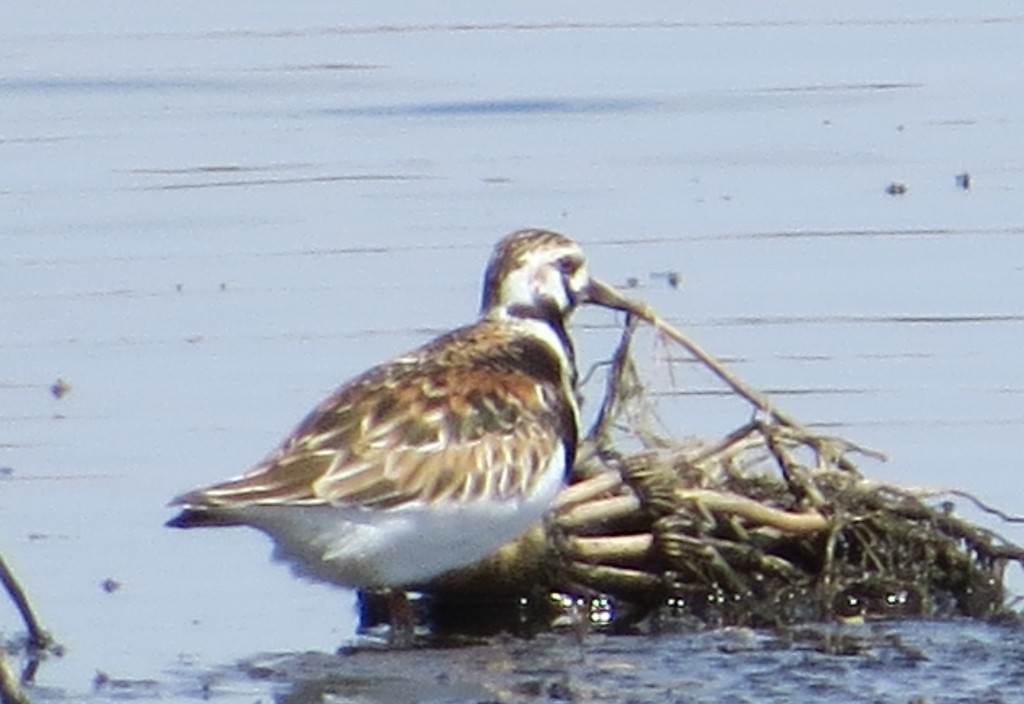
Ruddy Turnstone
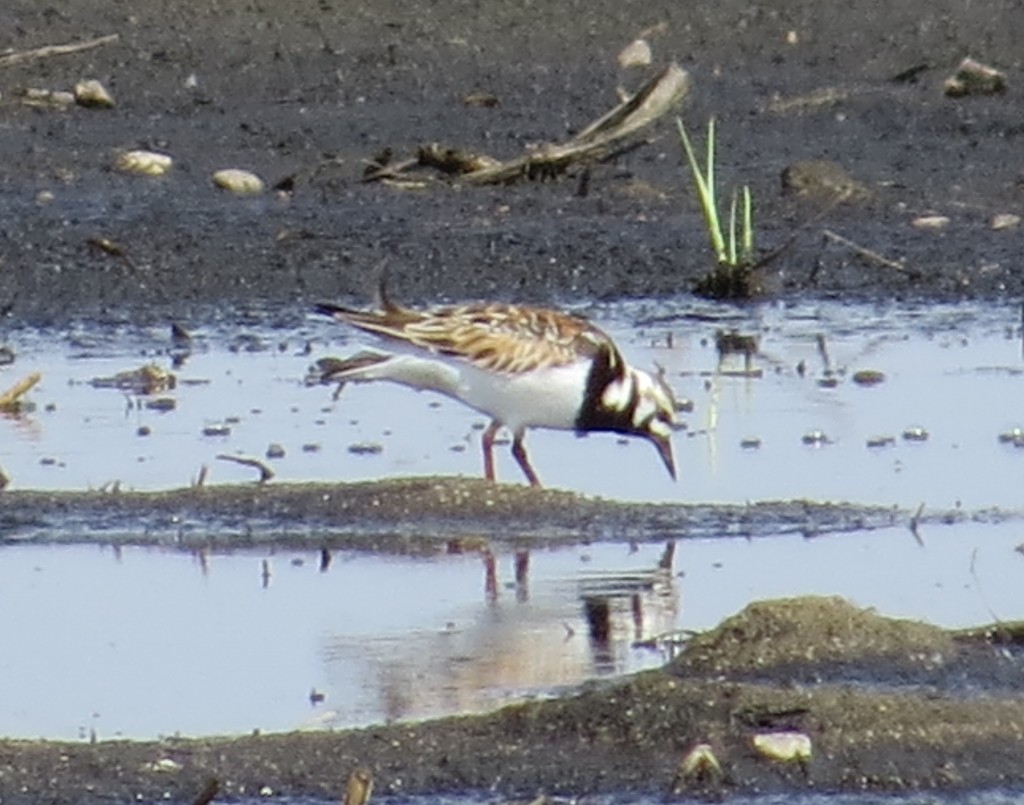
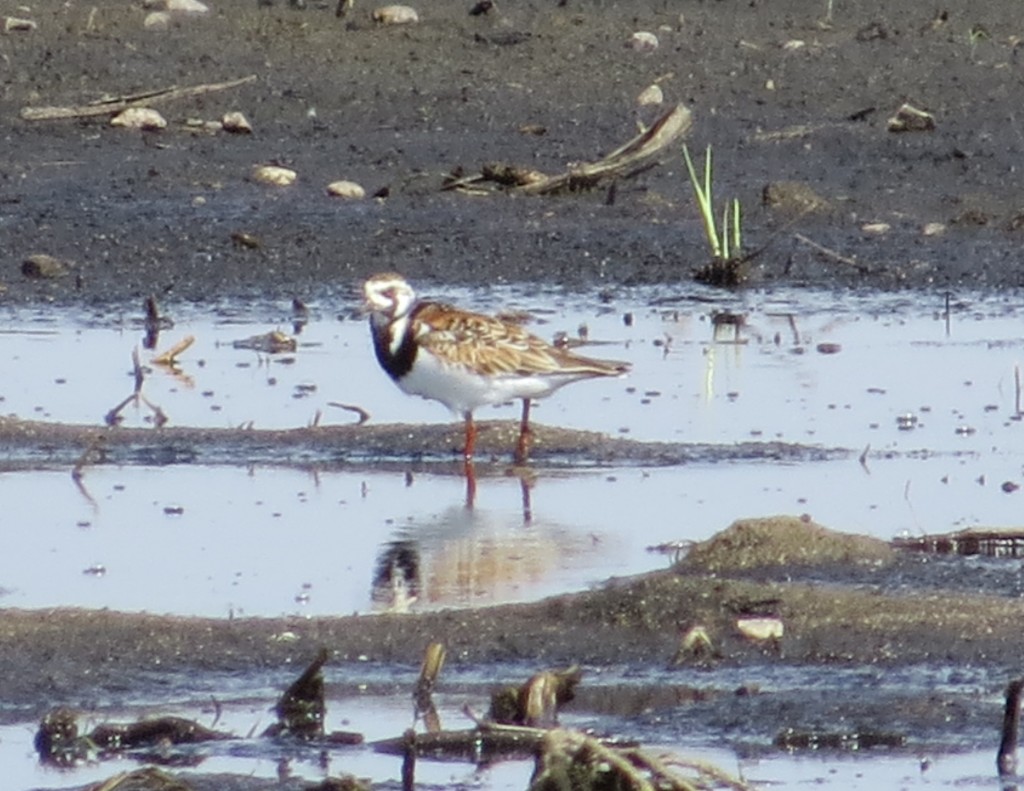
When we arrived I never saw the avocets. I figured they must have left. I saw some Canada Geese resting on the far shore, but there was not an avocet with them. Then, magically, one appeared. Evan was excited to see this second avocet of his life. The Ruddy Turnstone didn’t really trip his trigger, but these avocets seem to get his attention and rightly so. Before long all four American Avocets that Steve reported had materialized.
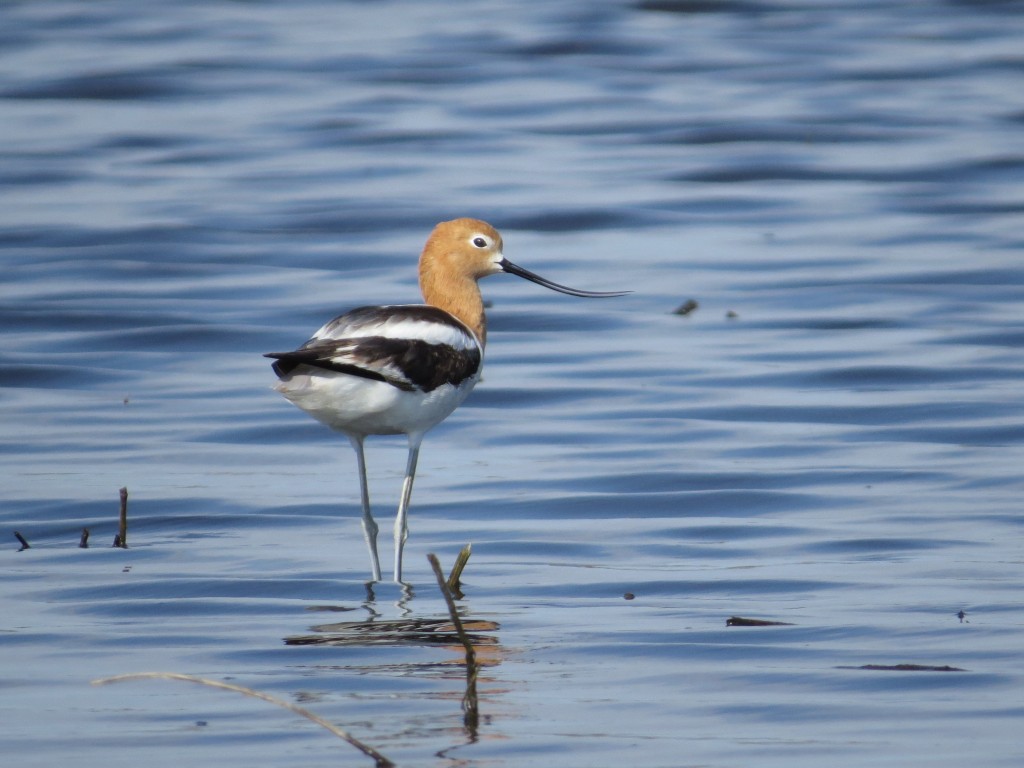
American Avocet
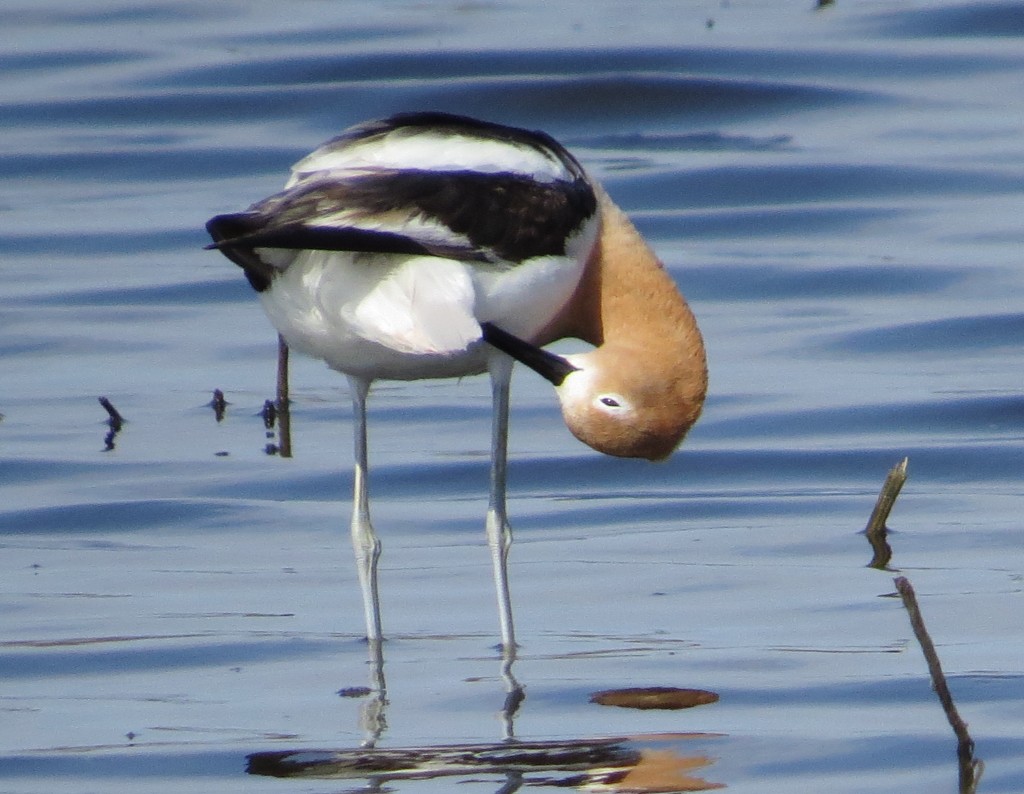
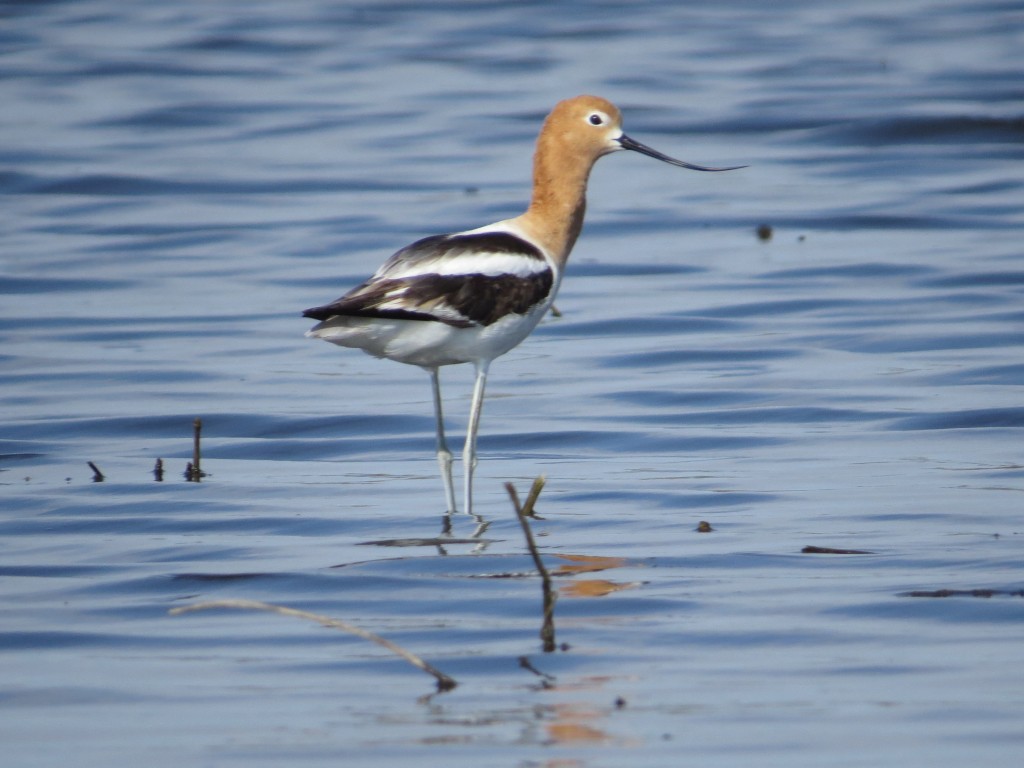
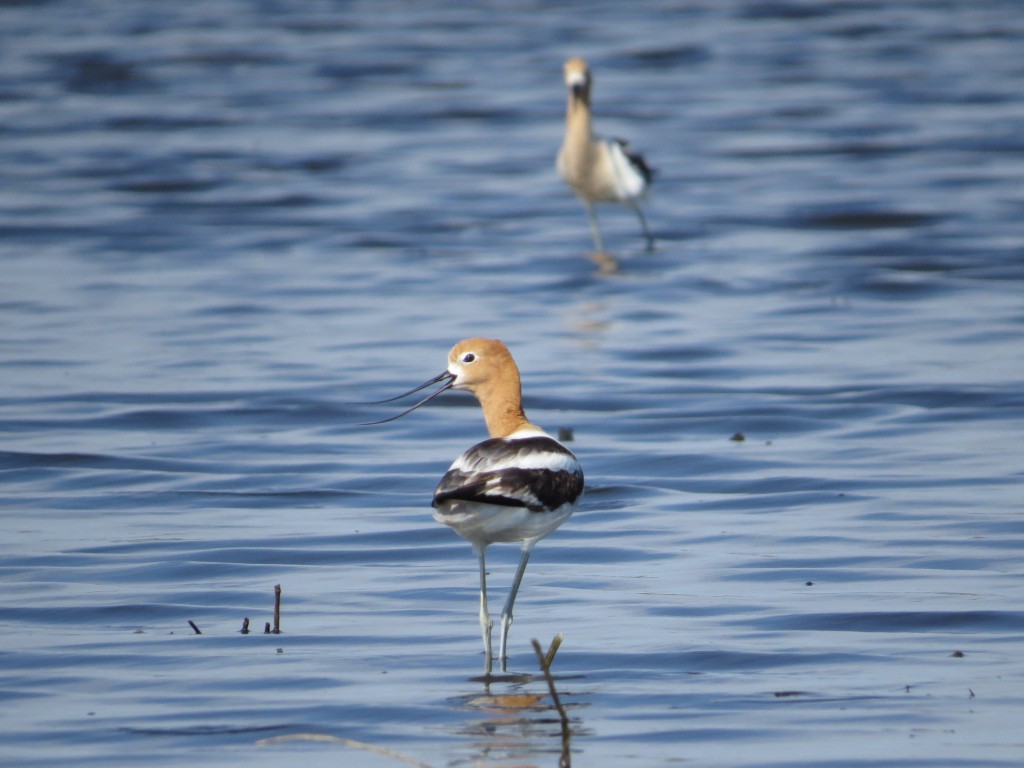 I continued to check out birds and photograph them while Evan played in the field.
I continued to check out birds and photograph them while Evan played in the field.
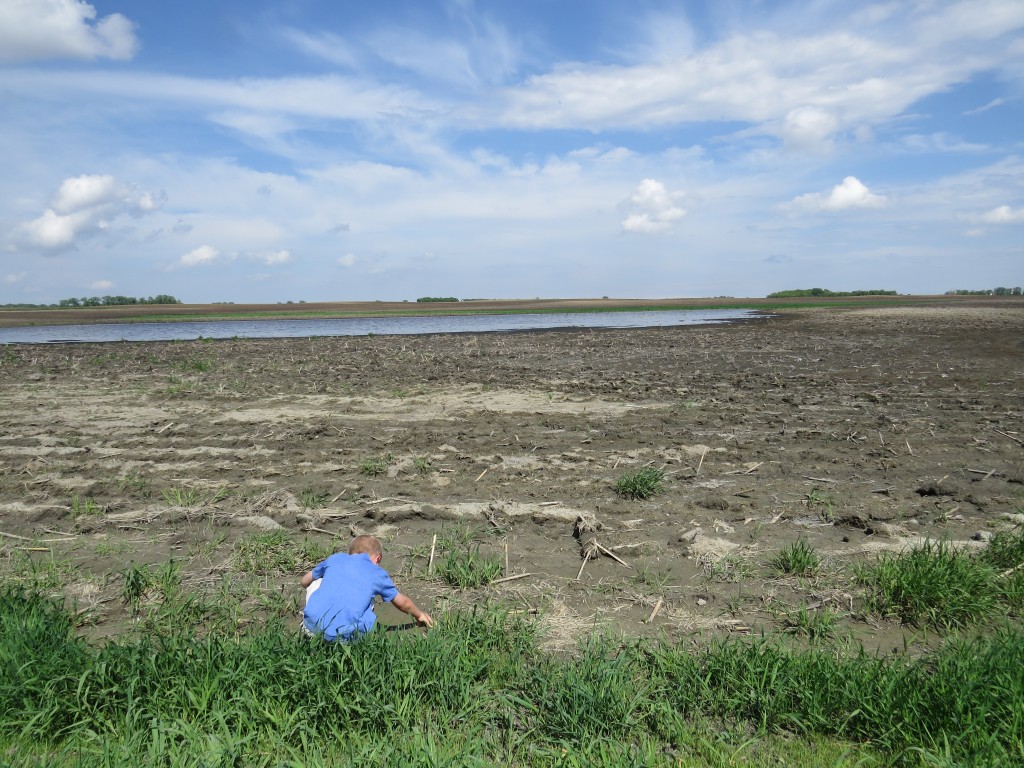 It’s a good thing that Randy showed up to break up the monotony by joking around with Evan and letting him look through his scope at all the cool shorebirds.
It’s a good thing that Randy showed up to break up the monotony by joking around with Evan and letting him look through his scope at all the cool shorebirds.
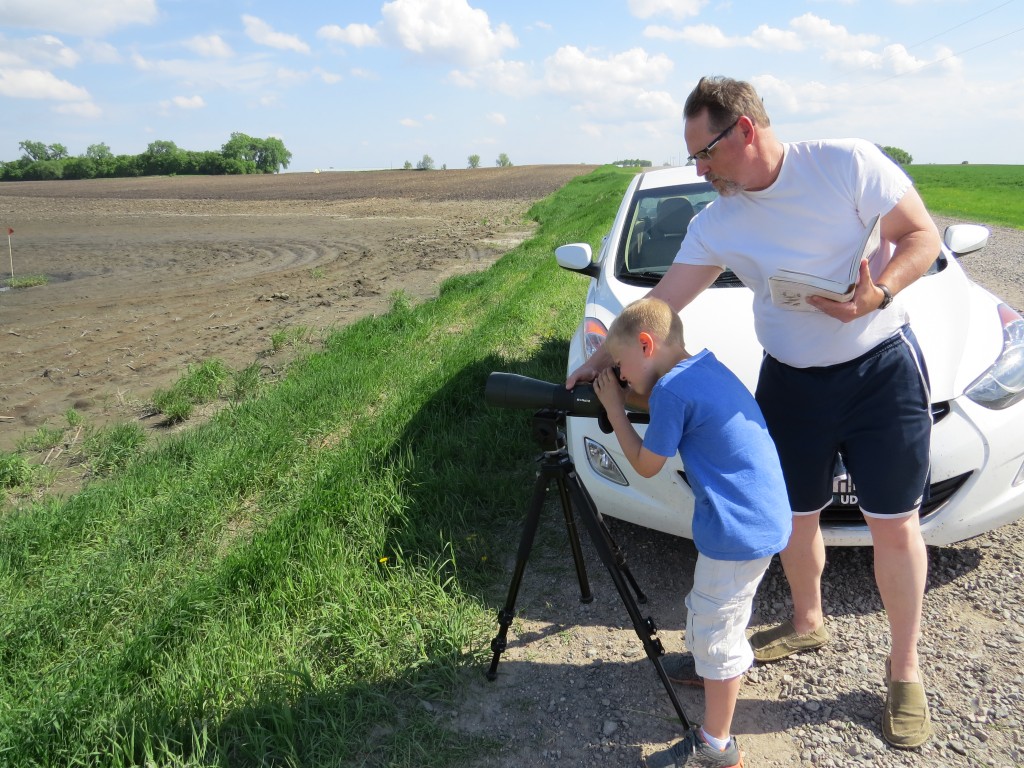 I was glad to have Randy there too. We had seen Dunlin and Wilson’s Phalaropes in addition to the Ruddy Turnstone and American Avocets, but we didn’t even try to sort through the peeps. Randy’s been to battle with shorebirds for many years, so he was undaunted by the challenge. Within seconds he was calling out Least Sandpipers, Baird’s Sandpipers, and White-rumped Sandpipers. White-rumped was one we needed, so I told him to find us one. He would oblige and let us look through the scope to get our looks at this lifer. Then I’d try to relocate the one he’d found in order to photograph it. The way these things move around and how many different species there were, I think it would have been easier to win the shell game against a hustler. I gave up on photographing this bird that varies only slightly from a Baird’s Sandpiper. I decided to cheat instead by photographing a whole flock of peeps and looking at my pictures later. See the ones with the clear white rumps? Those are White-rumpeds.
I was glad to have Randy there too. We had seen Dunlin and Wilson’s Phalaropes in addition to the Ruddy Turnstone and American Avocets, but we didn’t even try to sort through the peeps. Randy’s been to battle with shorebirds for many years, so he was undaunted by the challenge. Within seconds he was calling out Least Sandpipers, Baird’s Sandpipers, and White-rumped Sandpipers. White-rumped was one we needed, so I told him to find us one. He would oblige and let us look through the scope to get our looks at this lifer. Then I’d try to relocate the one he’d found in order to photograph it. The way these things move around and how many different species there were, I think it would have been easier to win the shell game against a hustler. I gave up on photographing this bird that varies only slightly from a Baird’s Sandpiper. I decided to cheat instead by photographing a whole flock of peeps and looking at my pictures later. See the ones with the clear white rumps? Those are White-rumpeds.
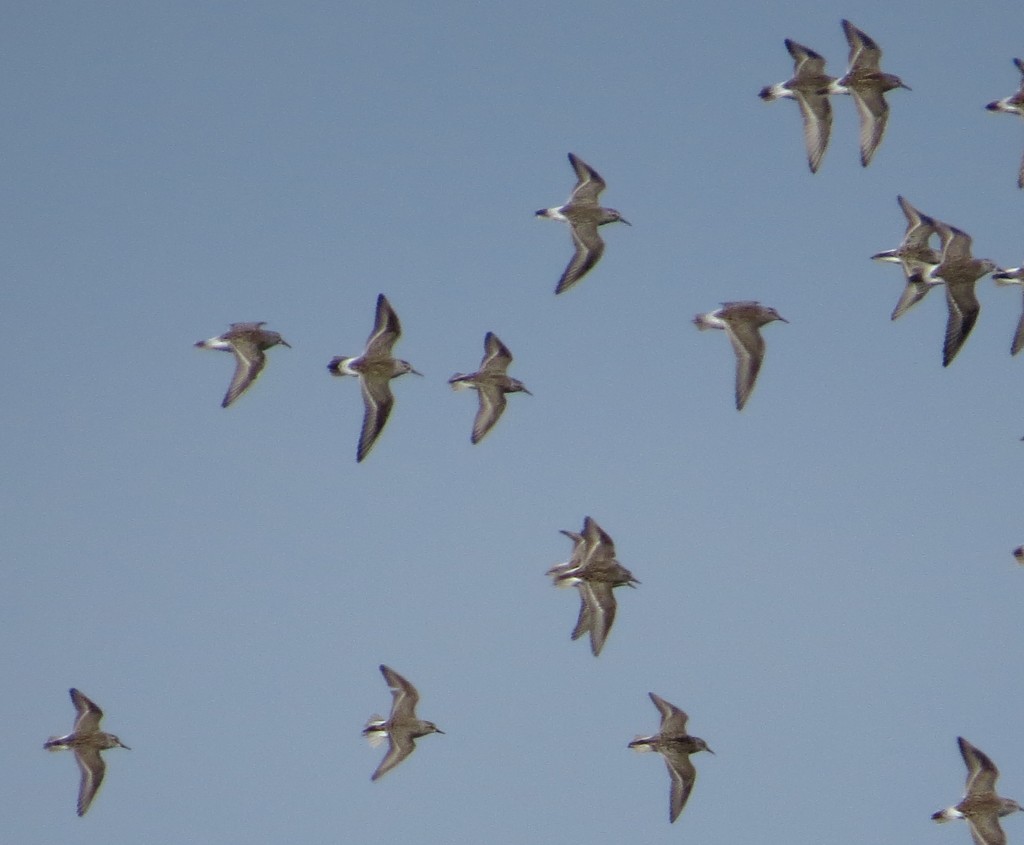
White-rumped Sandpipers et al
It was sad, really, that I spent a great deal of time trying to ID and photograph such a boring shorebird. I even missed it when Randy was observing the Ruddy Turnstone living up to its namesake by literally turning over stones with its bill to look for a meal. Randy also taught us that little tidbit of knowledge.
Even though I was frustrated with the White-rumped Sandpipers, Evan was having a good time getting into this scope thing. He even tried to turn a Killdeer into a Semipalmated Plover. Check out the bird book in his hand opened right up to the plovers section.
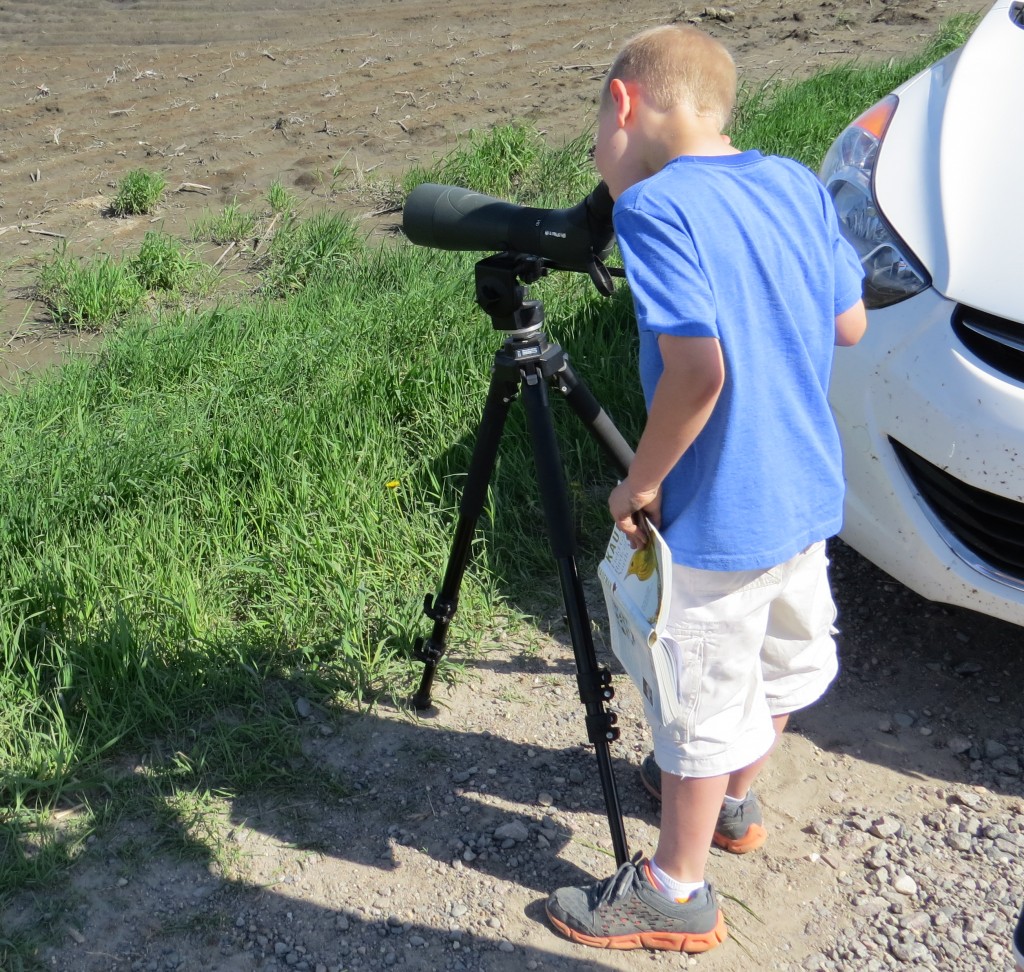 Two days and five life birds for Evan and four for me with some great sightings of some other really good shorebirds as well. This was quite unexpected. Migration has been screwy this year. Normally we wouldn’t be chasing shorebirds after warblers. Now, though, it’s open season on these guys again. And I’m learning that shorebirds are still arriving in states to the south of us. Tomorrow is my first full day of summer vacation, so Marin and I will be hitting the few local shorebird spots to keep up on the action. There will be no rest for the weary.
Two days and five life birds for Evan and four for me with some great sightings of some other really good shorebirds as well. This was quite unexpected. Migration has been screwy this year. Normally we wouldn’t be chasing shorebirds after warblers. Now, though, it’s open season on these guys again. And I’m learning that shorebirds are still arriving in states to the south of us. Tomorrow is my first full day of summer vacation, so Marin and I will be hitting the few local shorebird spots to keep up on the action. There will be no rest for the weary.
Shorebird Surprise
So it seems I wrote that previous blog post a tad prematurely. Yesterday I was fully living my life like migration was over – I slept in, scrubbed the deck, cleaned out two cars, and was gearing up to take the kids fishing in the afternoon. I was in full-on get ready for summer mode. Then I got a midday email from Randy who had checked out Carlson’s Dairy, an annually flooded field near a local dairy farm that is the go-to spot for shorebirds in our county. Randy said the place was hopping with about 90 peeps, 10 phalaropes, and 10 Stilt Sandpipers. A Wilson’s Phalarope would have been a life bird for Evan and a county bird for me, and the Stilt would have been new for both of us.
Though Evan had been asking repeatedly all morning when we were going fishing, I asked him if he wanted to make a quick run out to Carlson’s first. When he heard about those phalaropes, he was in. It was quite a sore spot for him last year when I got to see them without him.
We got out there and found the place full of tiny shorebirds.
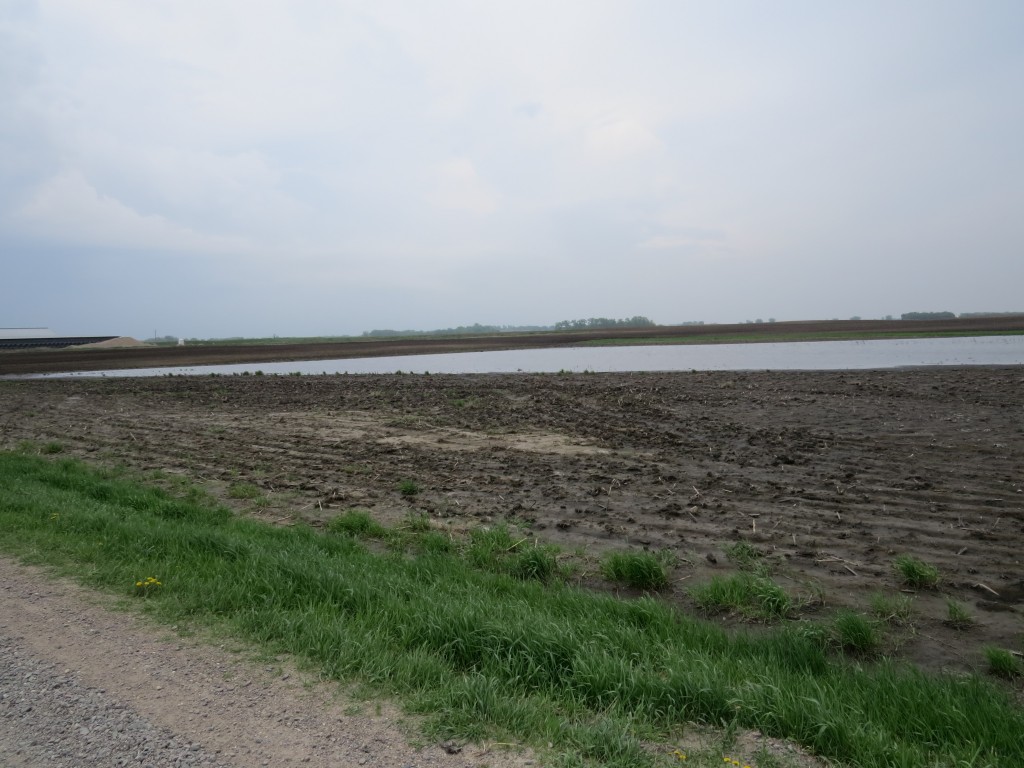 All I could see were the peeps who are no bigger than sparrows. There were tons of them. It took my awhile but I finally located a phalarope. I certainly didn’t see 10. I zoomed in on it and showed it to Evan on the LCD. He was excited to get his Wilson’s Phalarope but then wanted to go right away. Birding doesn’t really compare to fishing to a 7-year-old. So I snapped a picture of this phalarope, just assuming it was a Wilson’s, the most likely species. Then I looked a little closer at the LCD and realized it was a male Red-necked Phalarope in breeding plumage! This was not a life bird as we saw a very drab version last August at the Atwater sewage ponds.
All I could see were the peeps who are no bigger than sparrows. There were tons of them. It took my awhile but I finally located a phalarope. I certainly didn’t see 10. I zoomed in on it and showed it to Evan on the LCD. He was excited to get his Wilson’s Phalarope but then wanted to go right away. Birding doesn’t really compare to fishing to a 7-year-old. So I snapped a picture of this phalarope, just assuming it was a Wilson’s, the most likely species. Then I looked a little closer at the LCD and realized it was a male Red-necked Phalarope in breeding plumage! This was not a life bird as we saw a very drab version last August at the Atwater sewage ponds.
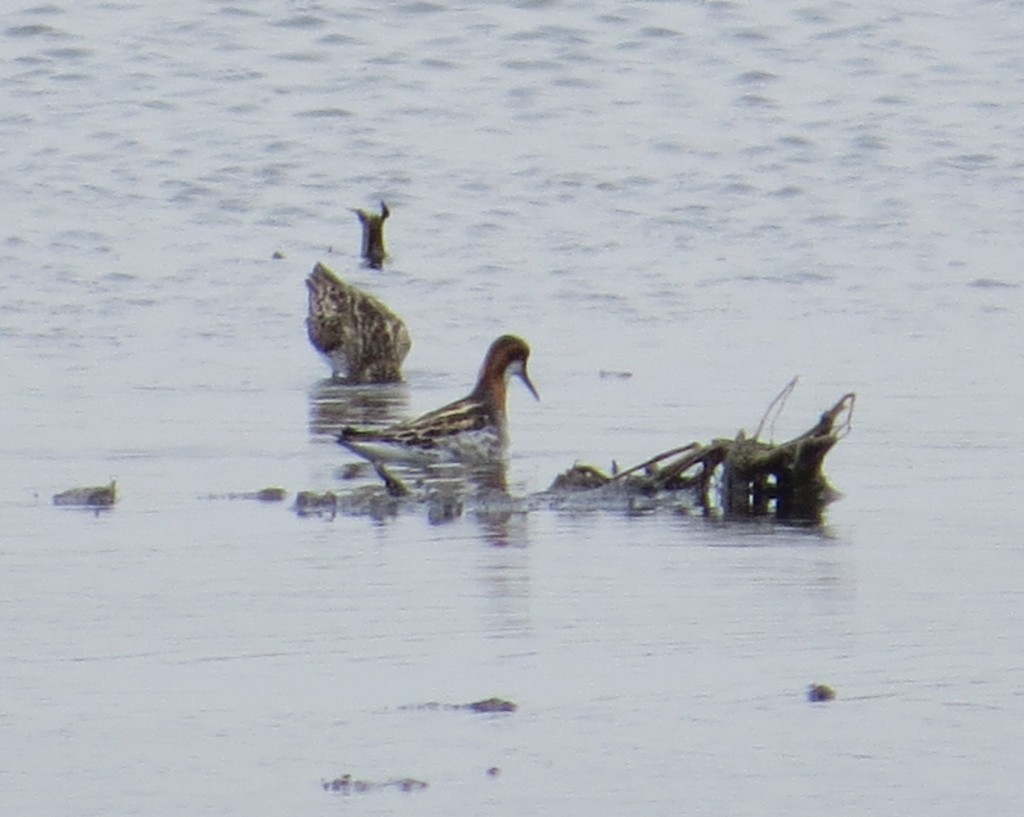
Male Red-necked Phalarope in breeding plumage
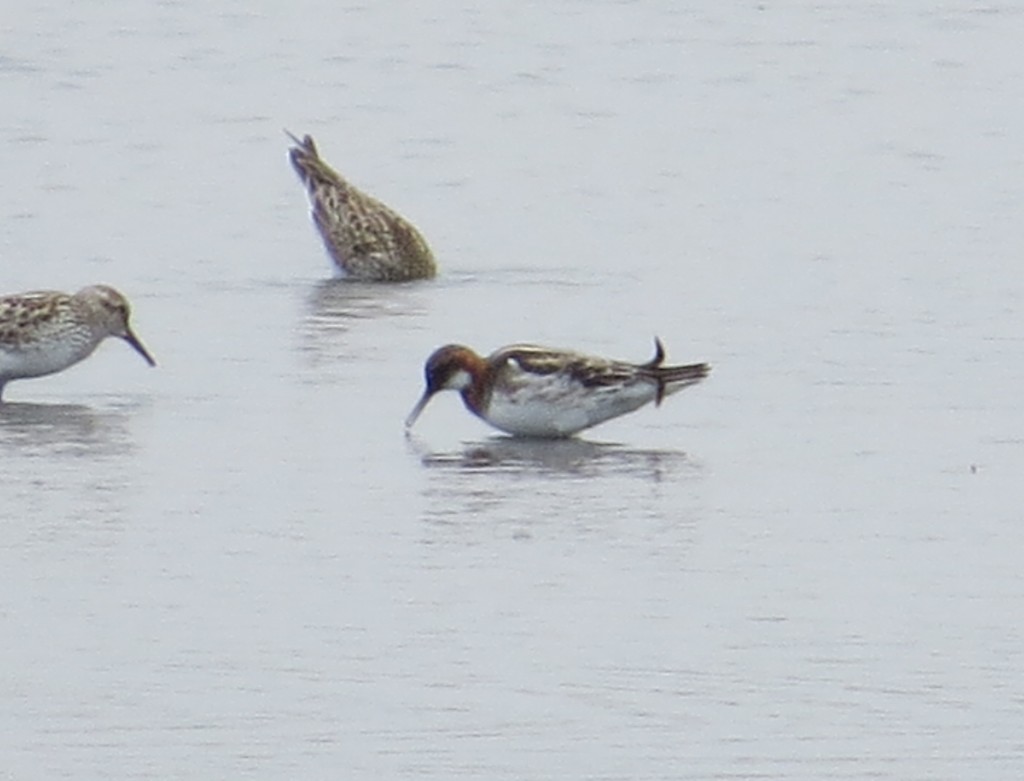 Now we had to stay for a bit because we hadn’t even gotten one of the two potential lifers there. I walked on the road to the view the north end of this pond, and I finally found the cache of phalaropes. These were definitely Wilson’s, so Evan got his life bird after all.
Now we had to stay for a bit because we hadn’t even gotten one of the two potential lifers there. I walked on the road to the view the north end of this pond, and I finally found the cache of phalaropes. These were definitely Wilson’s, so Evan got his life bird after all.
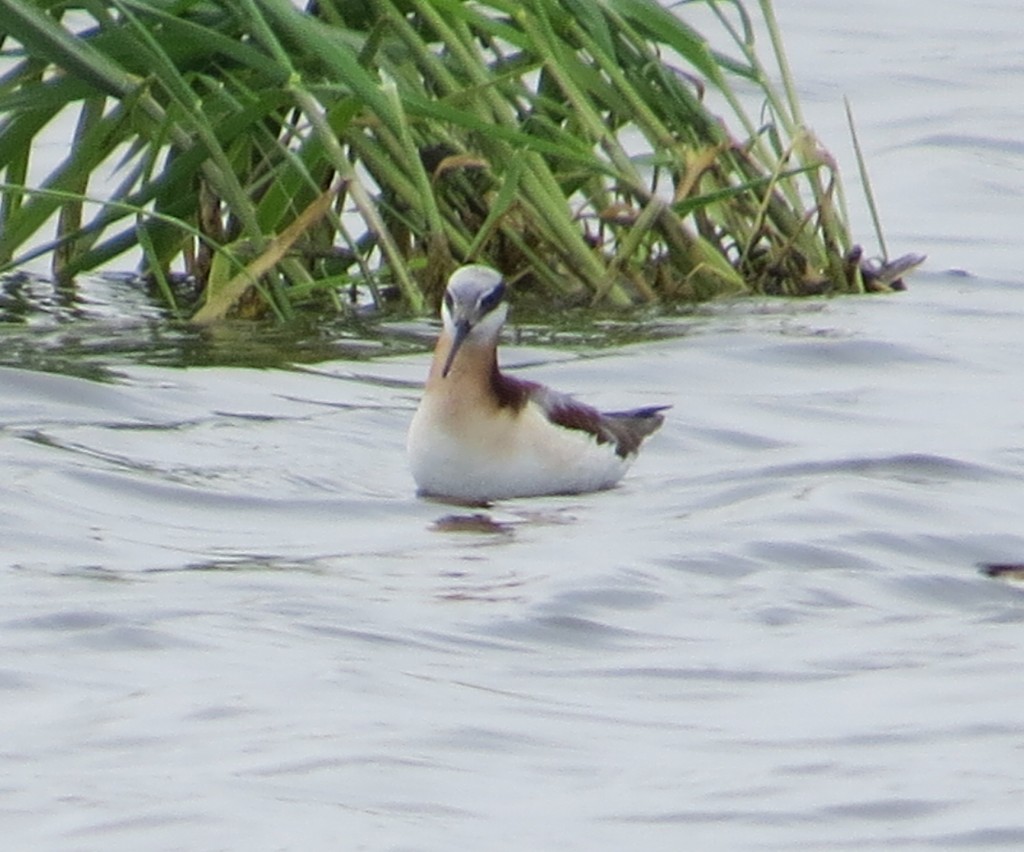
Wilson’s Phalarope
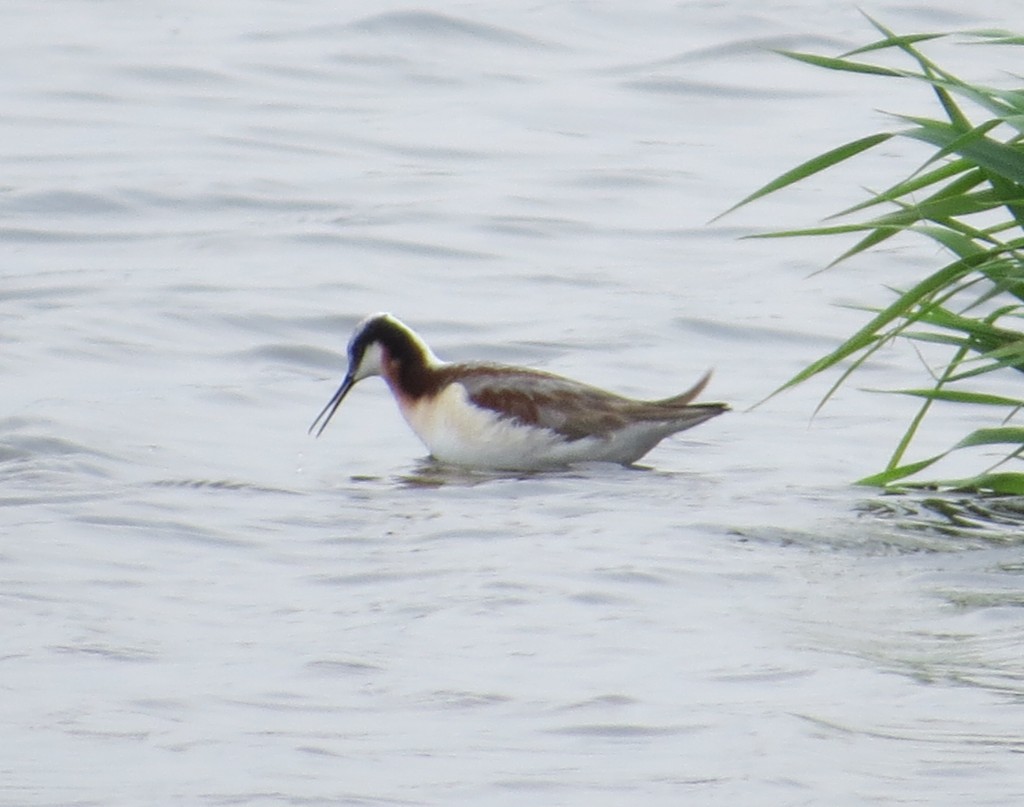 Then I spied some chunkier looking shorebirds that were bigger than the peeps but stockier than the phalaropes. The cloudy skies, distance, and strong wind buffetting my camera lens made it difficult to tell what they were. Were these our Stilt Sandpipers or a dowitcher of some sort? After looking back at my photos I could clearly see they were our Stilt lifers. It was interesting to read in the field guide, though, that they are compared to dowitchers in their behavior.
Then I spied some chunkier looking shorebirds that were bigger than the peeps but stockier than the phalaropes. The cloudy skies, distance, and strong wind buffetting my camera lens made it difficult to tell what they were. Were these our Stilt Sandpipers or a dowitcher of some sort? After looking back at my photos I could clearly see they were our Stilt lifers. It was interesting to read in the field guide, though, that they are compared to dowitchers in their behavior.
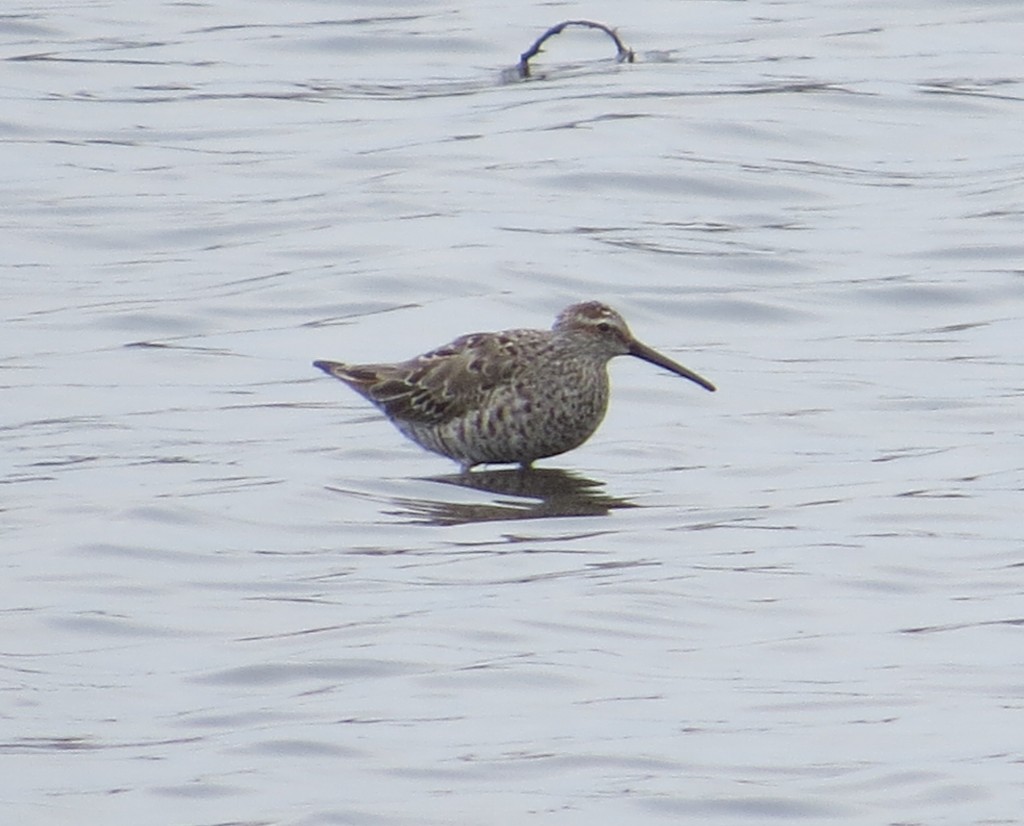
Stilt Sandpiper
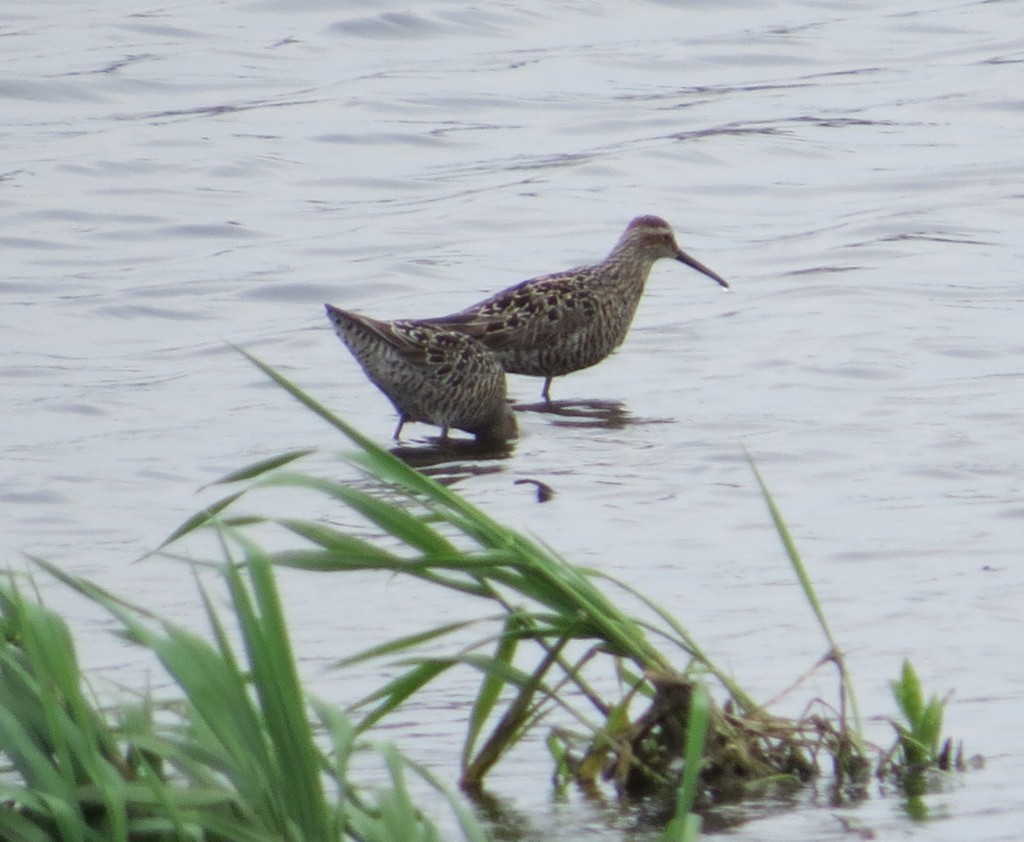
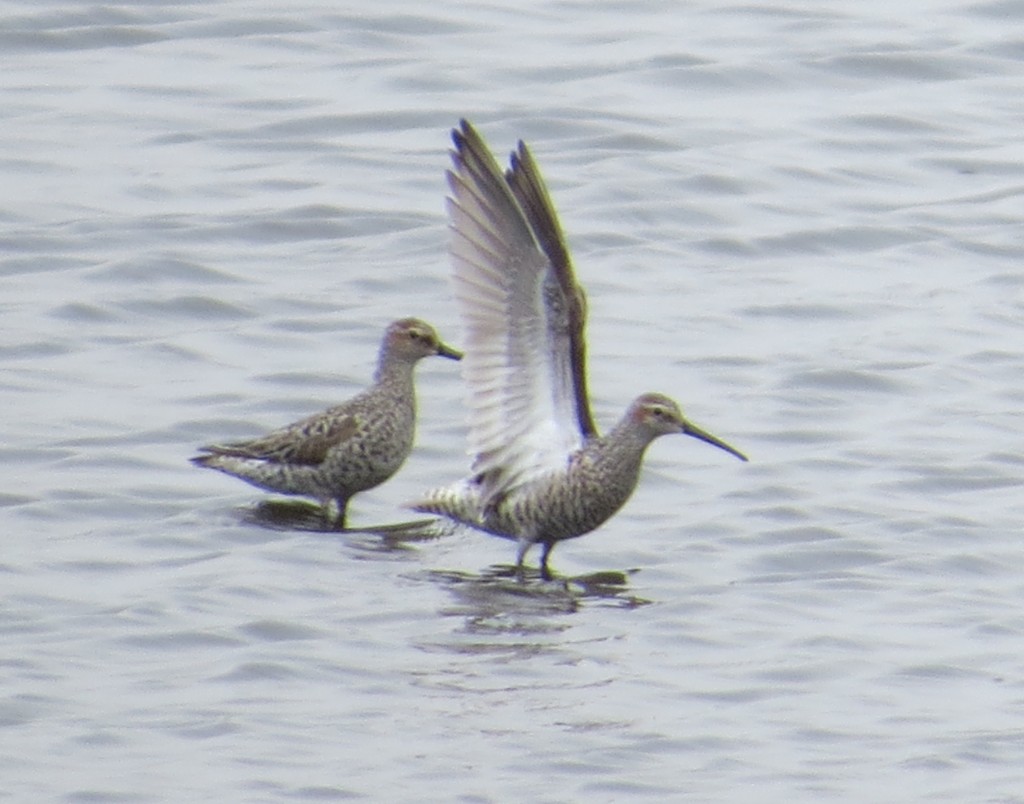
“I’m not a dowitcher! Don’t shoot!”
It turns out that there was one more little surprise for us mixed in with the chunkier shorebirds – a couple of Dunlin! This was a life bird for both of us. This is also my kind of shorebird as there is no doubt about the identification with the black bellies and chestnut-colored backs. Awesome.
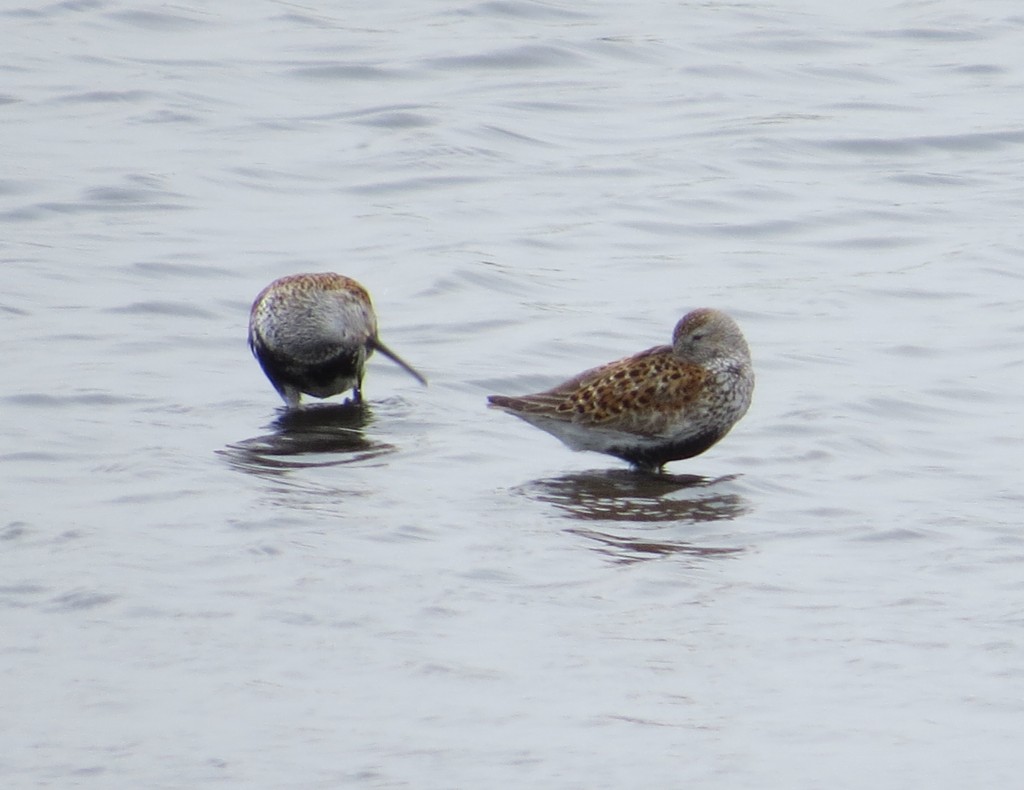
Dunlin
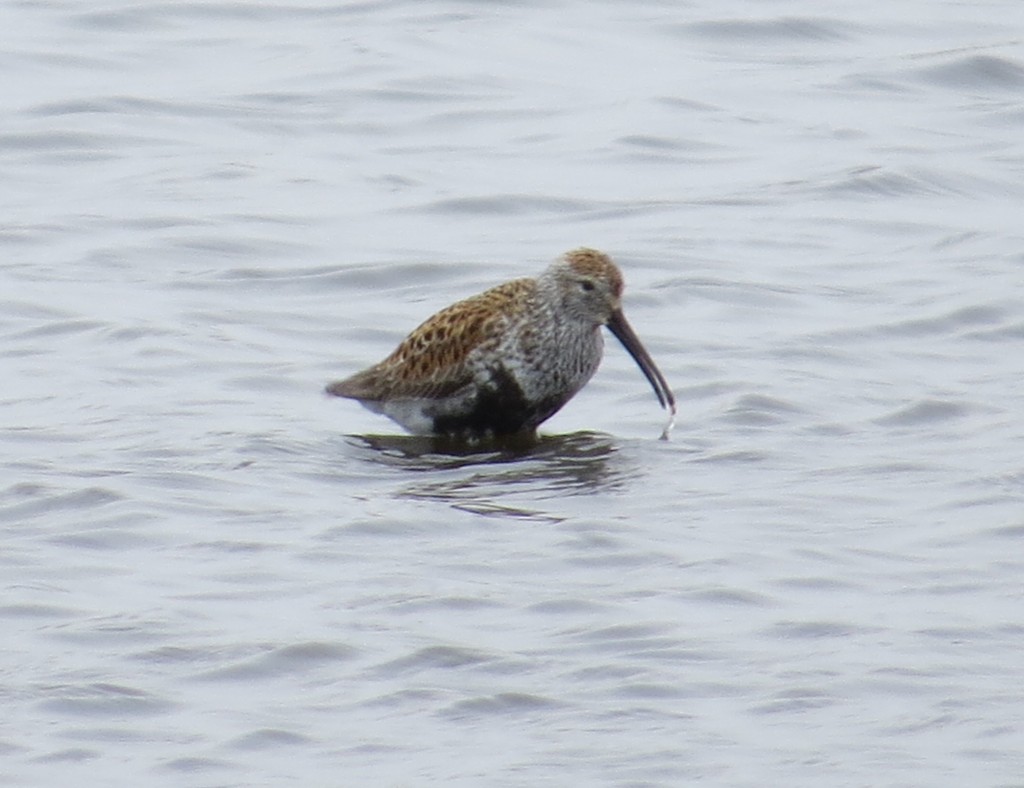 Three life birds for Evan, two for me, and a breeding plumage Red-necked Phalarope. I guess we better stay alert for a few more late migrants. As for the fishing report, Evan caught four Bluegill and quenched, albeit briefly, his thirst for fishing.
Three life birds for Evan, two for me, and a breeding plumage Red-necked Phalarope. I guess we better stay alert for a few more late migrants. As for the fishing report, Evan caught four Bluegill and quenched, albeit briefly, his thirst for fishing.
Later that evening we started working on our summer list of bird targets by going out with Randy. We were after anything marshy – Least Bitterns, American Bitterns, Soras, and Virginia Rails. We ended up hearing Soras and Virginia Rails which was pretty neat, but we did not see any. As Randy said, they are the kind of birds that you just have to get lucky with and bump into someday in order to get a good look. In the meantime we shall keep up the hunt for our targets and stay vigilant for any more late surprises.
Feelin’ Red Eyed
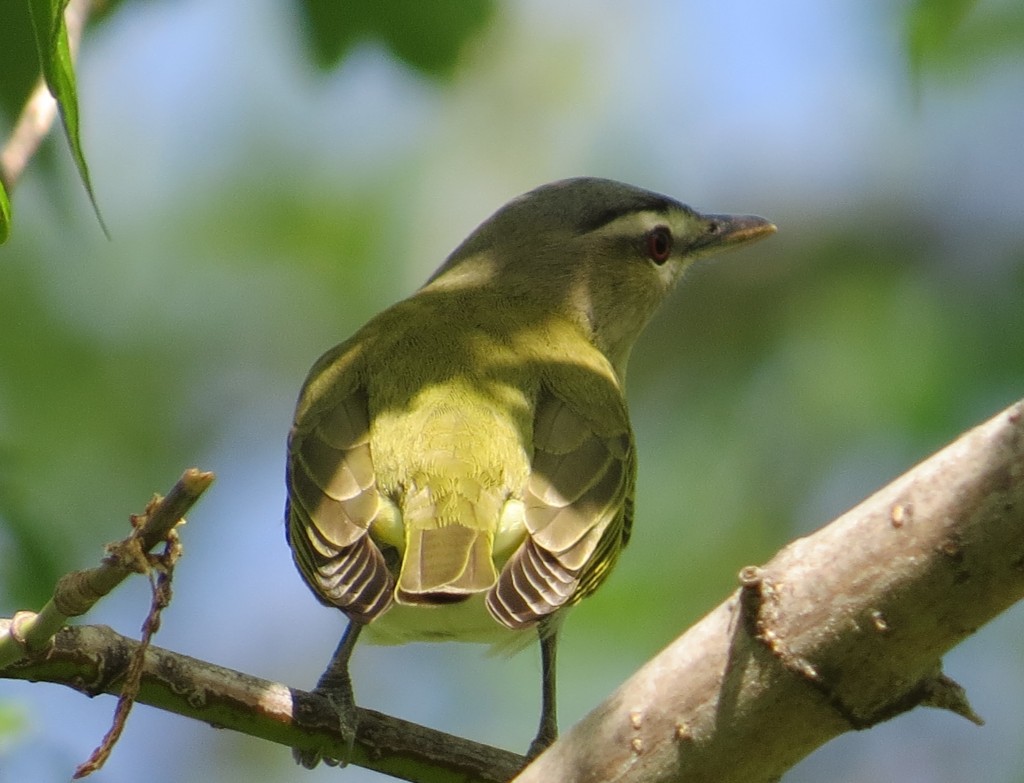
Red-eyed Vireo – probably one of our last migrants
It’s over. It really is. The long parade of migrants and the Easter-egg hunt for rarities is done. Also finished are the nights of a couple hours sleep from waking insanely early to hunt for good birds to staying up way too late to blog and eBird those good birds. In between waking and sleeping are way too many moments of checking for any new information on new arrivals, and sometimes this is done during the sleeping hours when I wake up in the middle of the night (several birders post to the listserv around 1 AM because the day’s birding was so good). We birders are as bad as stock traders watching the capricious whims of something for which we have no control, experiencing similar feelings of euphoria when something good pops up and feelings of depression when something goes away as quickly as it came. This constant flux of emotions can wreck havoc on an already exhausted body, but somehow we keep going out, keep searching for one more avian treasure.
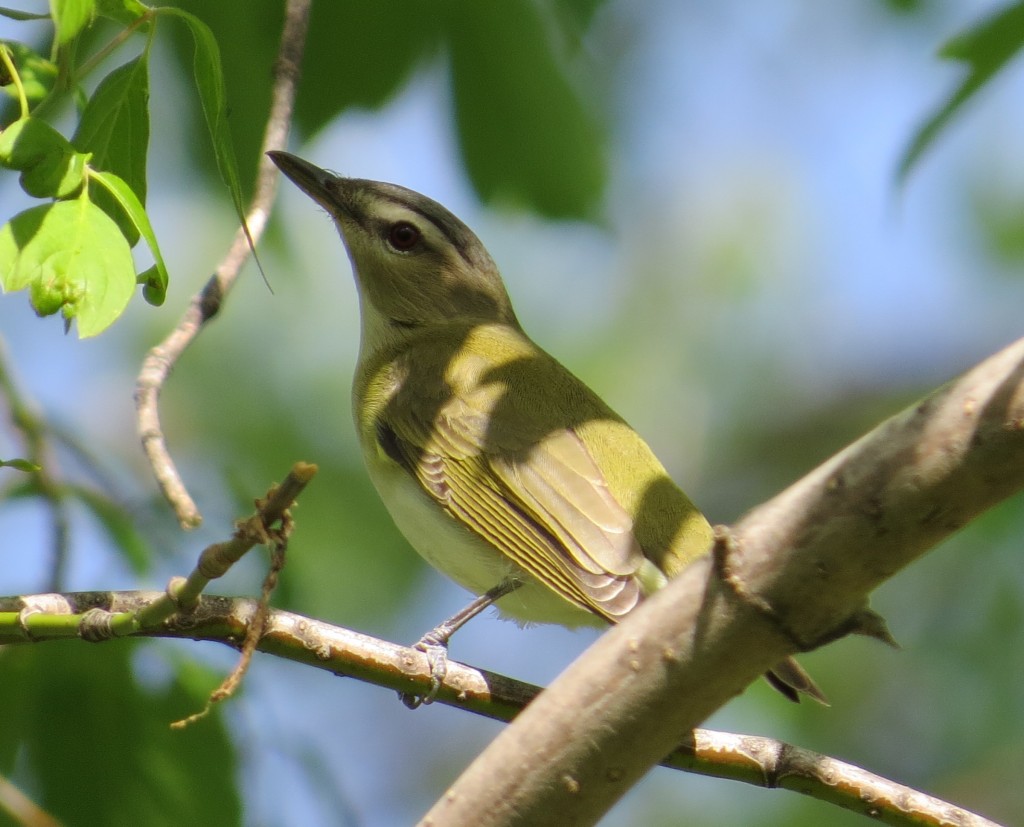
Ironically, the conclusion of migration coincides with the end of my teaching year when I now actually have time to go after birds and be well rested. All the chaos of migration also happens when life seems to be at the pinnacle of craziness with kid events, friend events, and just life in general. This massive amount of birding has to be squeezed in around the bigger and more important things going on.
Since Evan and I have seen most everything we can around here, I often go out by myself during migration and come back to grab him when I find something good. Surprisingly that happened a lot this spring, and way more life birds were added to the list for both of us than I ever anticipated. I had intended to spend time with a few favorite birds and photograph ones I’ve missed previously, but I was constantly interuppted with rarities that I found or chased. Maybe next year I’ll get to spend more time absorbed in the observation and photography of a particular species, something birding guide Erik Bruhnke refers to as zen-birding.
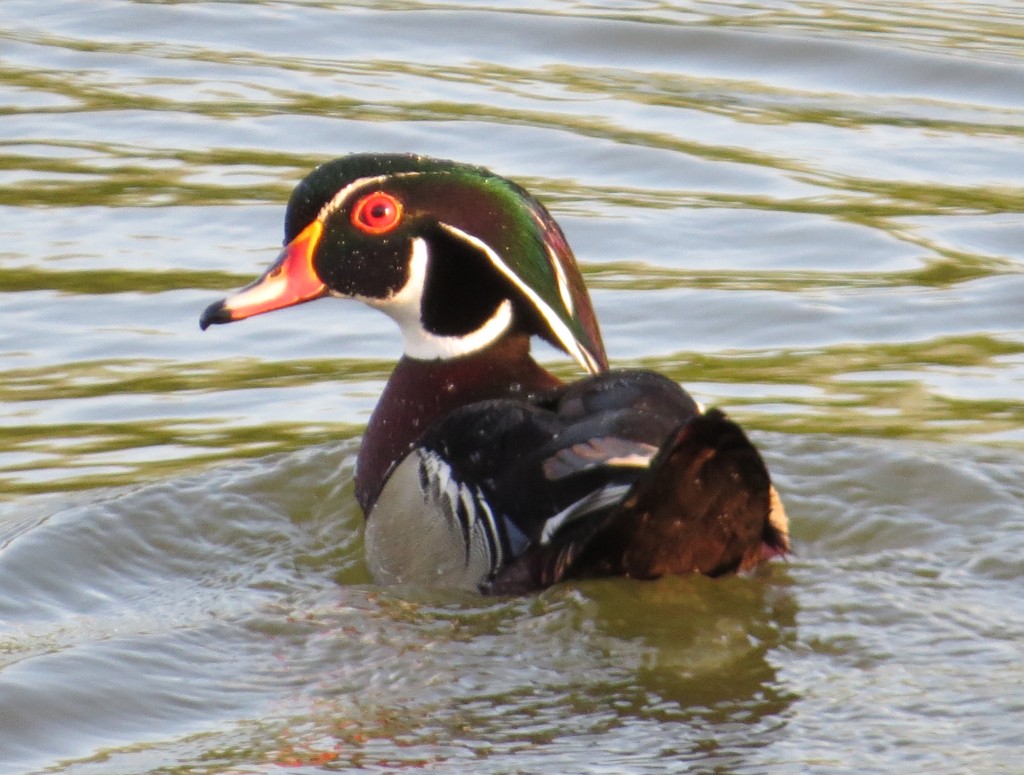
Wood Duck
Right now we are transitioning into “hunting” mode. There are a handful of resident birds that we have yet to see, either because of their scarcity, remarkable camouflage ability, or both. We will be working on the list in the coming weeks. The good news is that the birds will stay put; we just have to find out where they are and then get a good look at them.
It is also the time to catch up on photos of common birds. With fewer and fewer migrating birds to distract from these wallflowers, they can finally get their moment of glory.
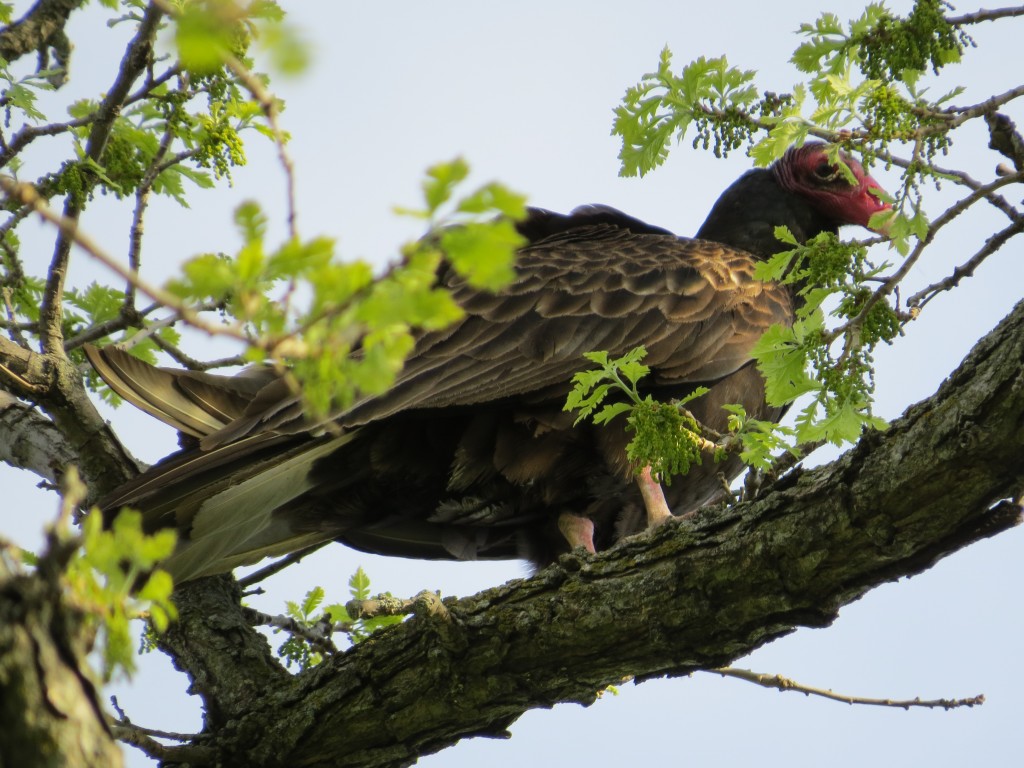
Turkey Vulture
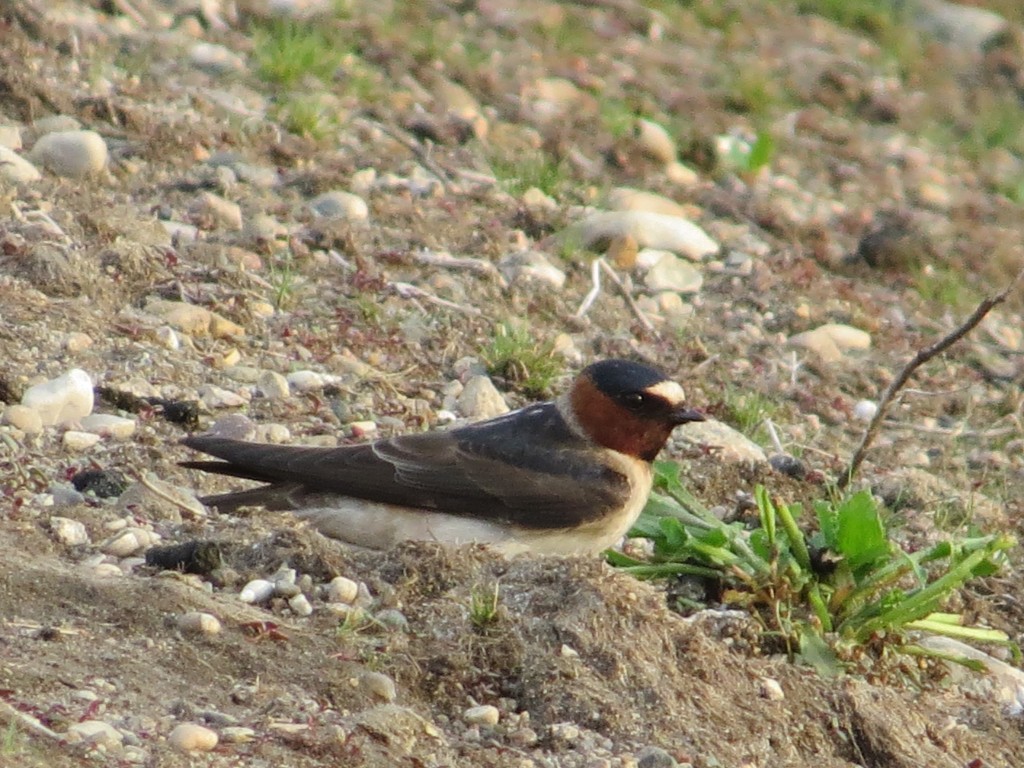
Cliff Swallow
And maybe, just maybe, I will finally take pictures of things like American Robins and Mourning Doves. I’ve been putting it off long enough, but it might be time to fill those holes. I promise I won’t bore you with those images this summer. Stay tuned, though, because there are some exciting summer birding forays planned with quite possibly a trip out-of-state.
Kingbird Highway or umm, County Road
If you think this post is a review of Kenn Kaufman’s book Kingbird Highway:The Biggest Year in the Life of an Extreme Birder, then you will be disappointed. Well, not really disappointed because this post still has some darn good birding it. Maybe some day I’ll find the time to read Kaufman’s book and do that review, but for now this little kingbird anecdote will have to do.
Tonight I went out on a solo birding mission. It was a gorgeous evening as we hit a daytime high of 79° with no wind and clear skies. That rarely happens here. Just last week Evan has his track and field day at school and the kiddos were wearing hats, gloves, and winter coats. Anyway, I had to get out tonight. Both kids declined my offer to go for a ride to scout out a new place to look for warblers.
About ten minutes from the house I turned east onto a gravel road to head to my destination on the south end of Lake Elizabeth. I have this terrible habit of focusing on my destination that I don’t take the time to adequately check out the birds on the way other than while traveling 60 MPH. It’s a good thing, though, that I was traveling slow on the gravel and heading east because the setting sun caught the brilliant yellow belly of a large bird as it lifted off the nearby telephone wire. I instantly knew it was the Western Kingbird! I tried for this bird unsuccessfully a couple different times last year and couldn’t turn one up at Blue Mounds State Park, Felton Prairie, or even Arizona. I had even been making plans to go to Cottonwood this summer to look for it again, and here it was in my own backyard!
I made the ID as I went past it. Looking back I was staring at its sillhouette in the setting sun. I also had a truck come behind me and scare it up. Thankfully it landed back on the wire. I wasn’t taking any chances on scaring it without seeing it in the good light and getting a recognizable photo, so I continued east and drove around the square mile section so I could pull up on it with good light at my back.
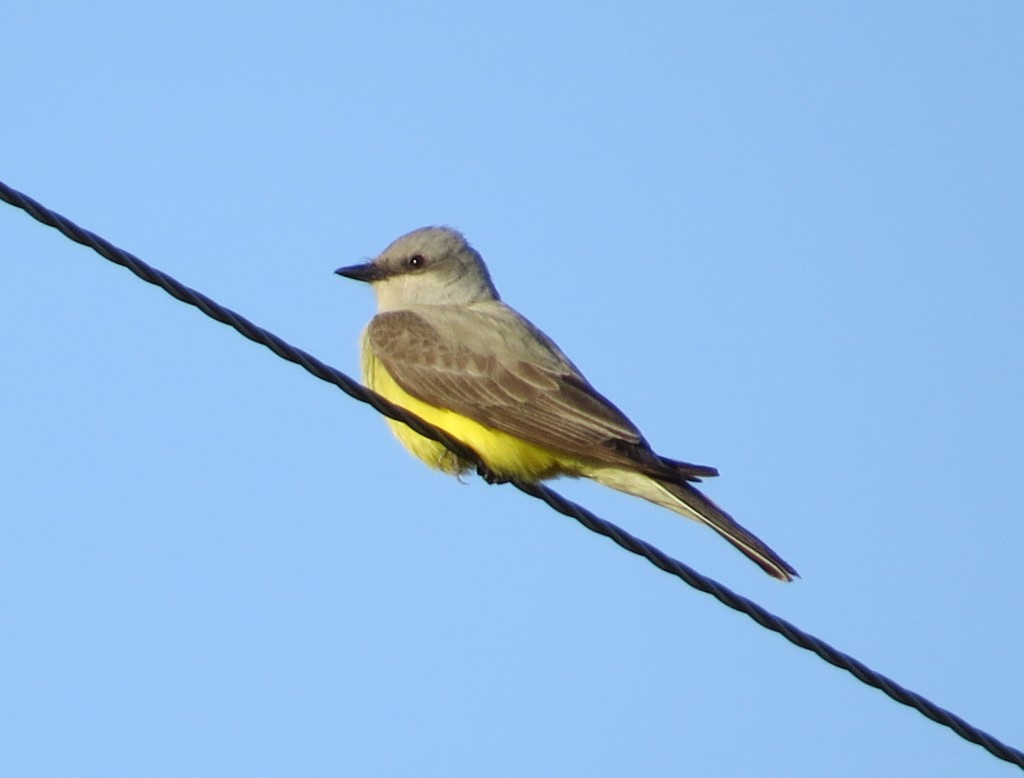
Western Kingbird
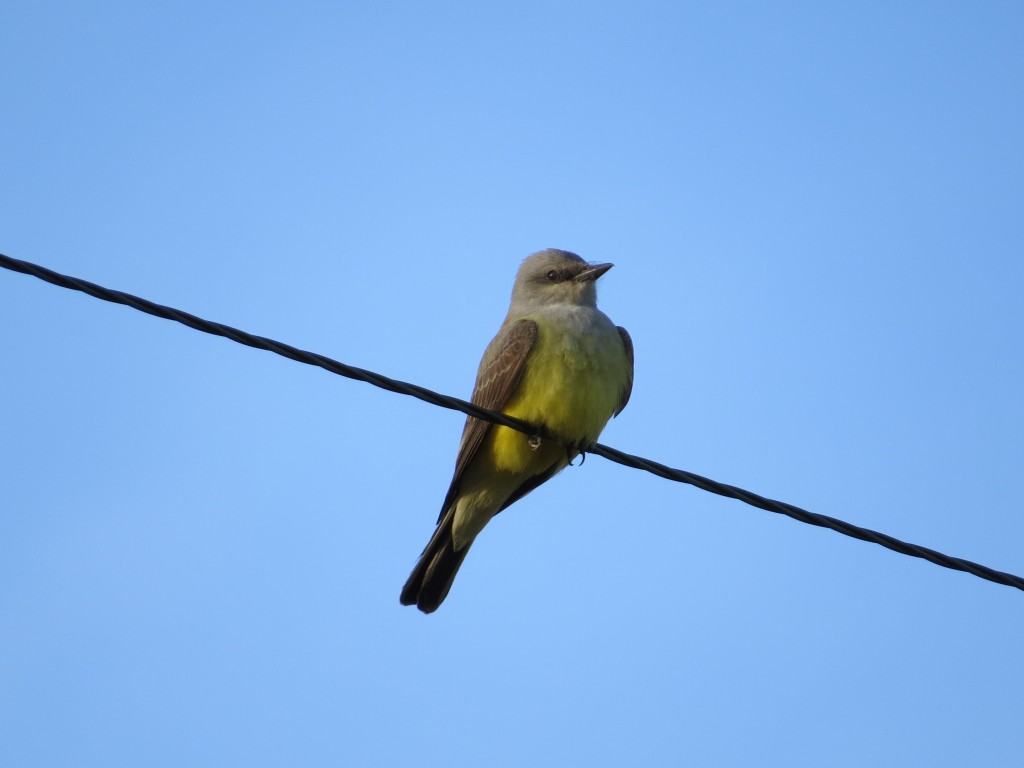 I raced home to get Evan. It was only 7:20, so I still had time to get him, get the bird, and get him back for bed at 8. I whipped into the neighborhood and saw all the neighbors and neighbor kids were outside hanging out enjoying this gorgeous night. When they saw me pull up curb-side and not bother to pull in the driveway, they all knew I had seen something good and was there to pick up Evan. No time for small talk. I told Evan to hop in because I found us the Western Kingbird. In seconds, we tore off going back to the wire.
I raced home to get Evan. It was only 7:20, so I still had time to get him, get the bird, and get him back for bed at 8. I whipped into the neighborhood and saw all the neighbors and neighbor kids were outside hanging out enjoying this gorgeous night. When they saw me pull up curb-side and not bother to pull in the driveway, they all knew I had seen something good and was there to pick up Evan. No time for small talk. I told Evan to hop in because I found us the Western Kingbird. In seconds, we tore off going back to the wire.
When we got there, I saw a bird on the wire and was hopeful. Then my hopes sank for Evan when I saw it was a Mourning Dove. But I glassed the wire a little further down and refound the kingbird between the next two poles. Whew. Evan has trouble operating binoculars, so I crept the car right up to this bird giving us some incredible looks.
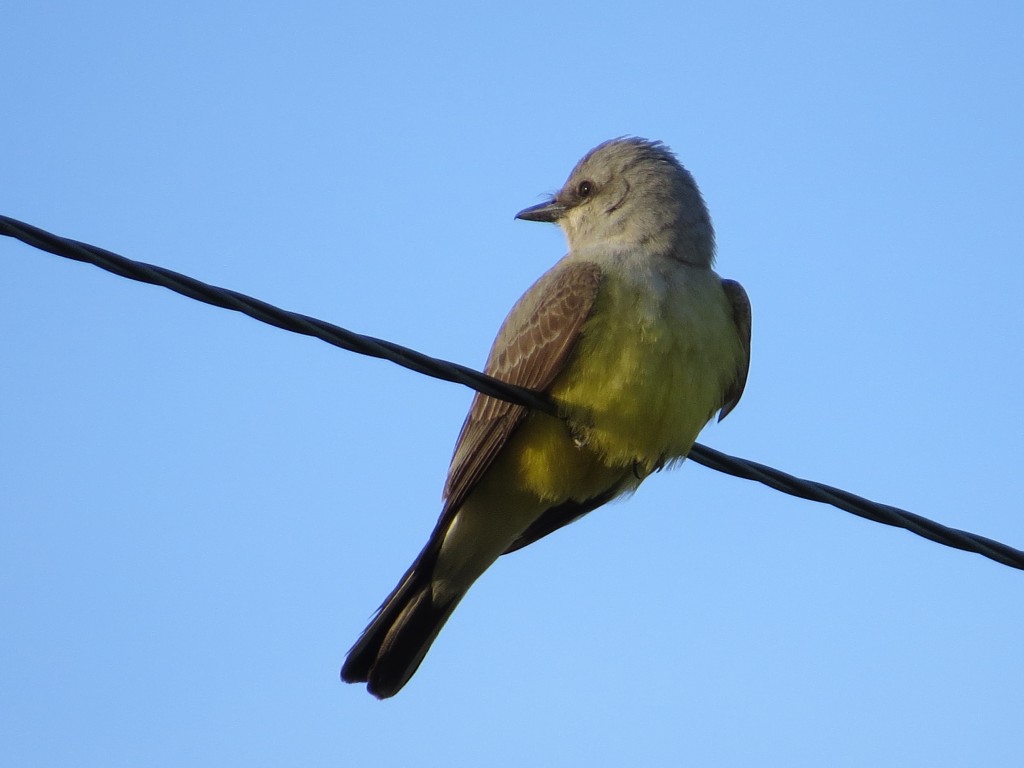
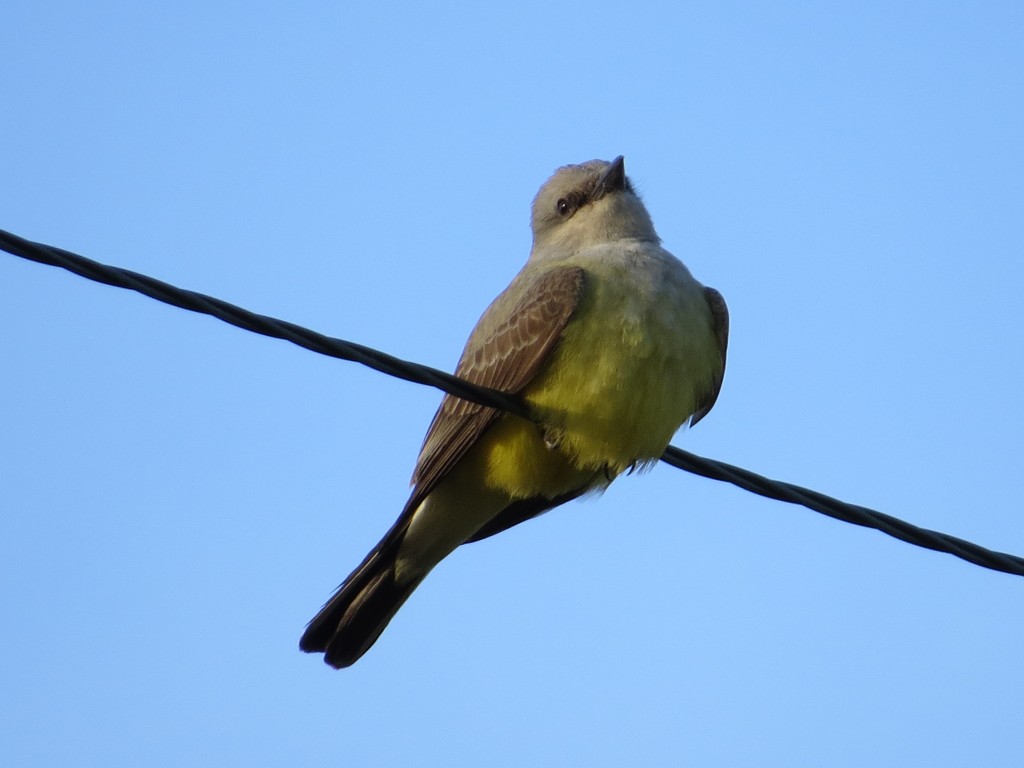
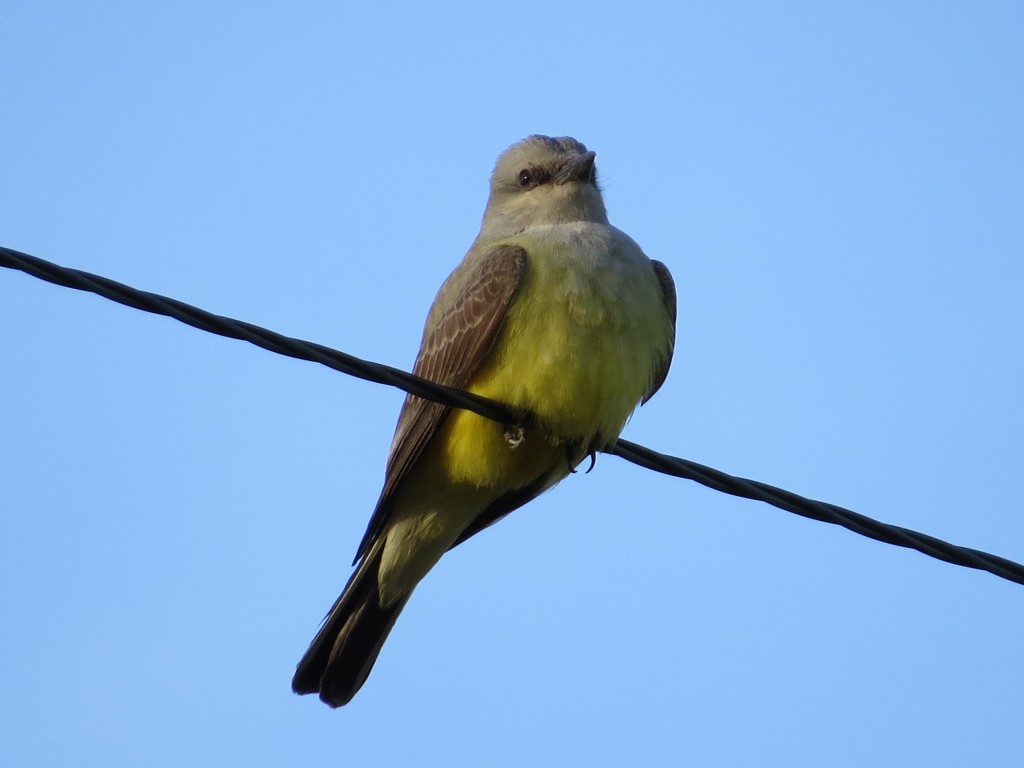
Even being so close, it was tough to fully see how cool this bird was. I flipped open my LCD display for Evan to get a real good look. His response was, “Cool!” Yes, it was. Sadly this bird finally left us going long out of sight. I was hoping it would stick around for other area birders. After all, Western Kingbirds are quite scarce here. Joel told me he’s only seen them twice in the county before.
The funny thing about this Western Kingbird is that he was sitting on a wire on the west end of this gravel road. On the east end were five Eastern Kingbirds! How appropriate. It reminded me of a blog post by the Two-Fisted Birdwatcher. Strangely, I’ve never spent much time photographing this locally common bird, and they were quite skittish tonight when I tried.
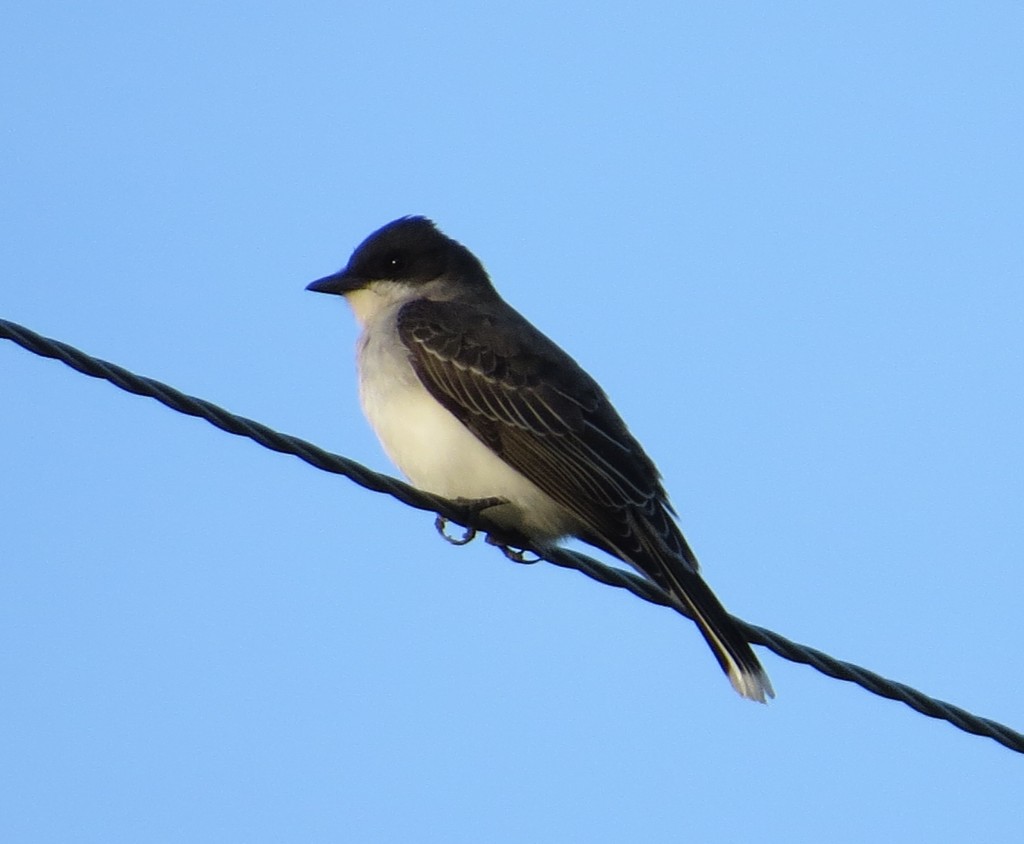
Eastern Kingbird
It was a very cool burst of birding on this school night. We did a little wandering on the way home and stopped to look at birds here and there. Evan didn’t let me dawdle too long as he had a date with a root beer float back home. Our wandering back brought us down a gravel road that winds between two lakes – water on the left, water on the right. We’ve traveled it many times. Where the water flows through a culvert under the road there are always American White Pelicans feeding on the fish that move between the lakes. Before we got there Evan said he would bet me $10 that there would be pelicans. I told him there was no way I was taking his bet.
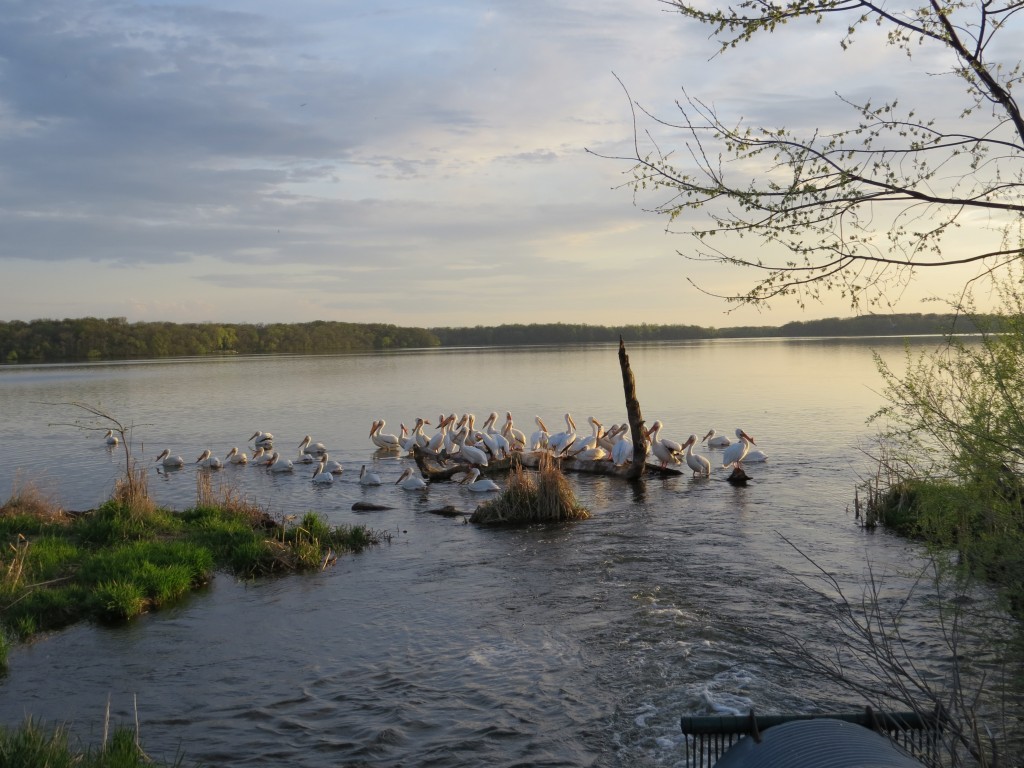
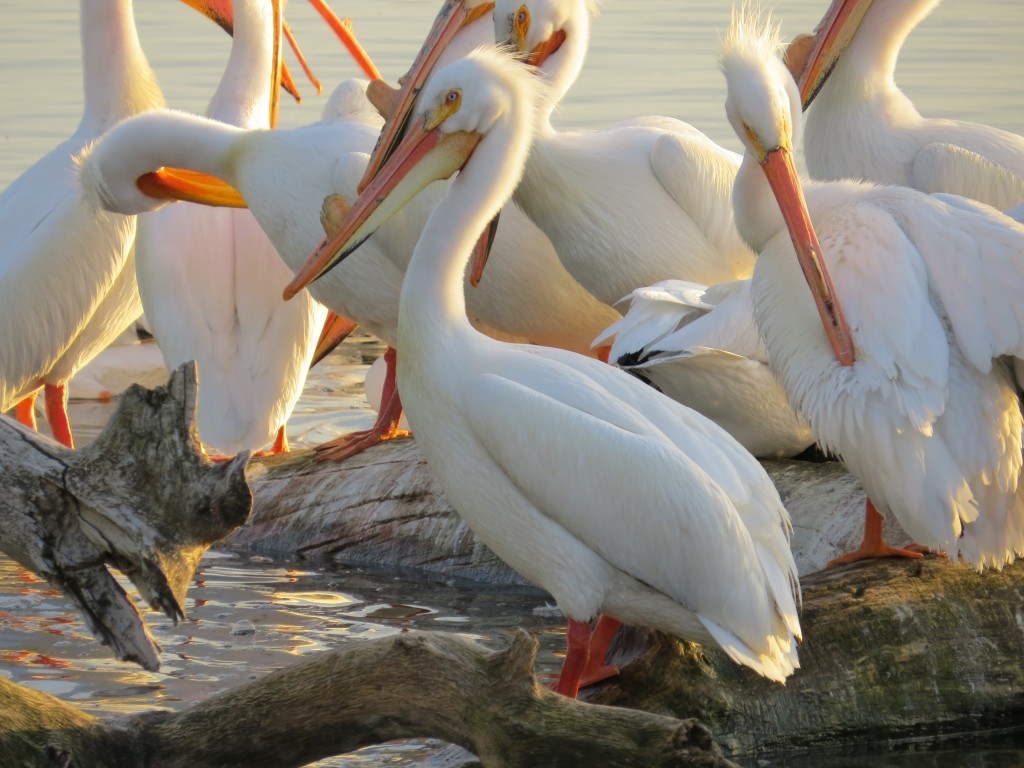
Evan would have to settle for his root-beer float instead. I didn’t care about a root-beer float anymore as I was already content with a great sighting of a life bird that was near the top of the summer wish list. But I still enjoyed that float.
Scouting and Spartan-Training with a Healthy Side of Birding
There was much rejoicing in the neighborhood this weekend – I finally made it up on to the roof to take down the Christmas lights. Though I would have rather been birding on this gorgeous day, June was fast approaching and I was getting dangerously close to leaving them up and boasting about how prepared I was for next Christmas. It turns out, though, that birding from the roof was pretty good. Two male American Goldfinches in the midst of a dogfight nearly crashed into my face, and later I had a stunning bird pull a “Maverick” as it buzzed the tower at eye-level. The burnt orange and glossy black were unmistakable – no binoculars were needed to see this was an adult male Orchard Oriole! I’ve only seen a flash of one before, and we had an immature male at the feeder once last year. The kids were playing outside, so I hollered for Evan to get my camera out of the car while I kept an eye on the bird. It probably would have been faster for me to go myself, but after some communication misfires, two trips to the vehicle, losing the bird, and refinding the bird, I finally got a picture of this scarce oriole. The shot was from a long way off, and the bird was gone before I could get more.
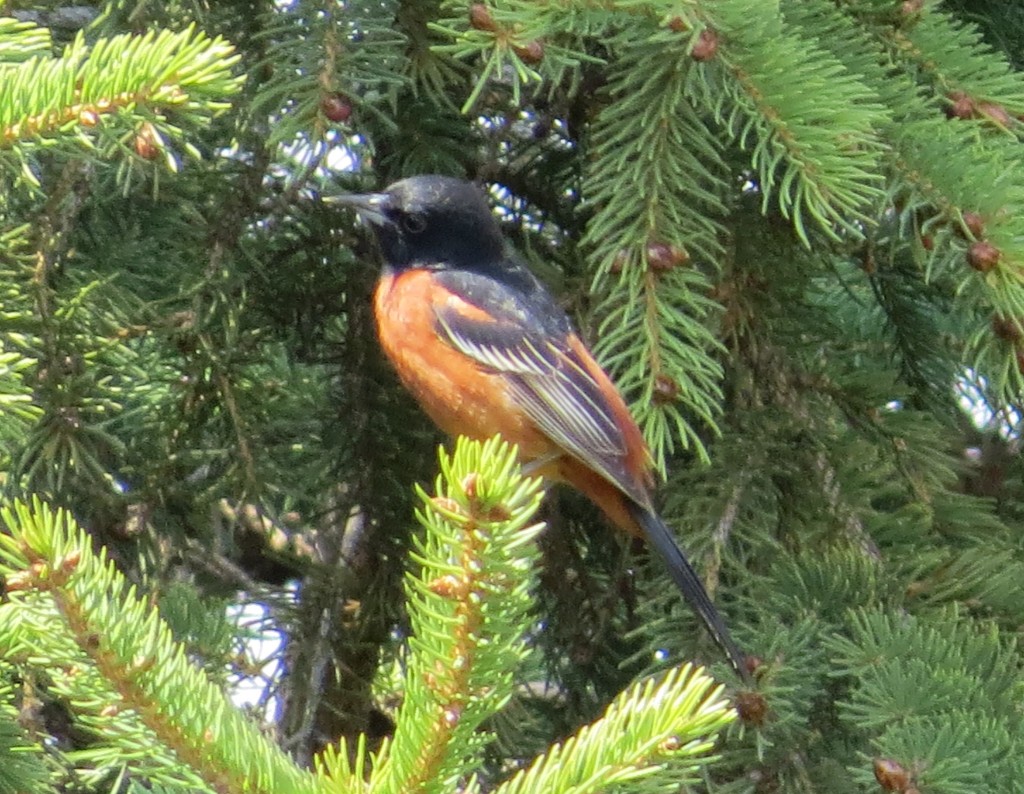
Adult male Orchard Oriole
The Orchard Oriole wasn’t the only yard-bird excitement this weekend. As Evan and I were getting ready to go on a Cub Scout camping outing, I was trying to grab a photo of a new yard bird, the Nashville Warbler. This isn’t an exciting warbler, but any bird takes on a new level of importance when it visits your yard for the first time, especially a warbler. Since we aren’t near water and don’t have many mature trees here, we rarely get warblers in the yard.
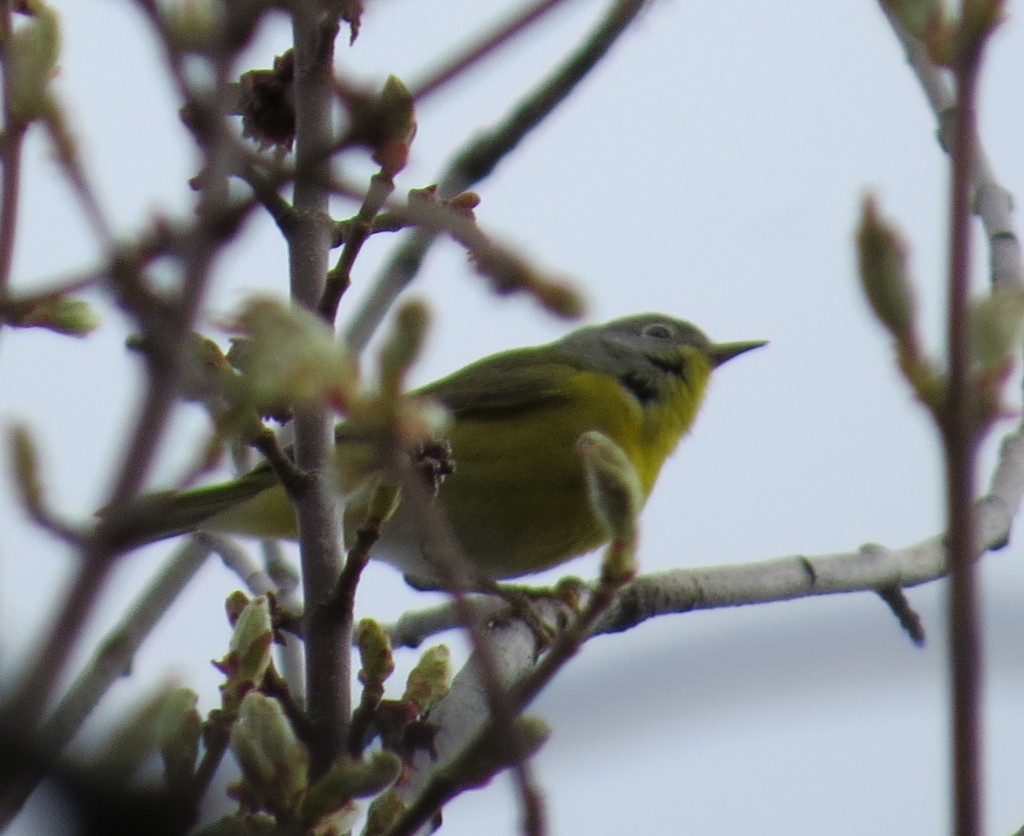
Nashville Warbler
As I was maneuvering to photograph this warbler and holding up the camping weekend, another new yard-bird warbler popped in front of my face, the Black-and-White Warbler!
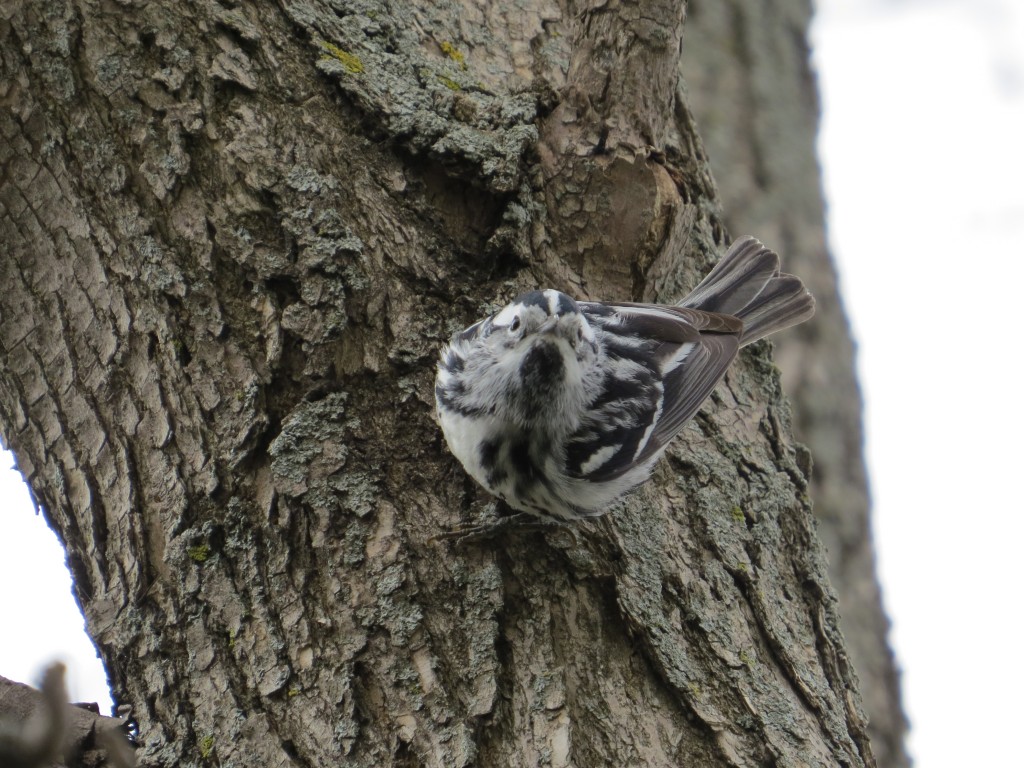
Black-and-White Warbler
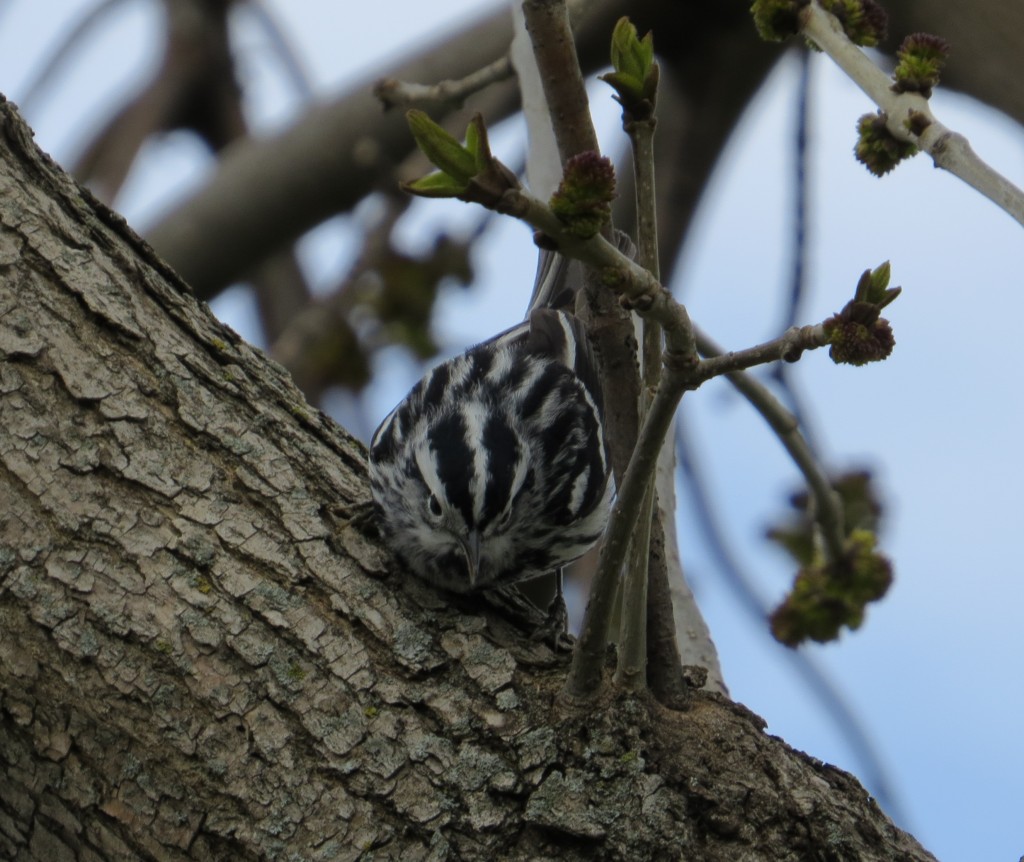 And then I noticed a third warbler, the Yellow-rumped! Though none of these warblers were terribly exciting, it was a thrill to have them invade our very own trees. I wondered what else was with this mini warbler wave, but we had to get to scout camp.
And then I noticed a third warbler, the Yellow-rumped! Though none of these warblers were terribly exciting, it was a thrill to have them invade our very own trees. I wondered what else was with this mini warbler wave, but we had to get to scout camp.
Scout camp was a lot of fun made even more so because Evan and I opted to spend the night back at home instead of huddling in a tent for an overnight low of 37°. We participated in the activities Friday evening, went home, and then drove back for the activities Saturday morning. I should point out that we also never missed a meal with the scouts. Priorities.
The location of camp was on 600 acres of beatifully wooded private land complete with two private lakes. There were birds galore. One of the predominant species was the Wood Duck. I visited with one of the other scout dads who helps maintain the Wood Duck boxes on the property, and he told me there were about 100 boxes and that 85% of them were occupied this spring!
I didn’t photograph any of the Woodies, though, and instead picked out a couple species that have evaded my photography efforts, like the ground-skulking Palm Warbler.
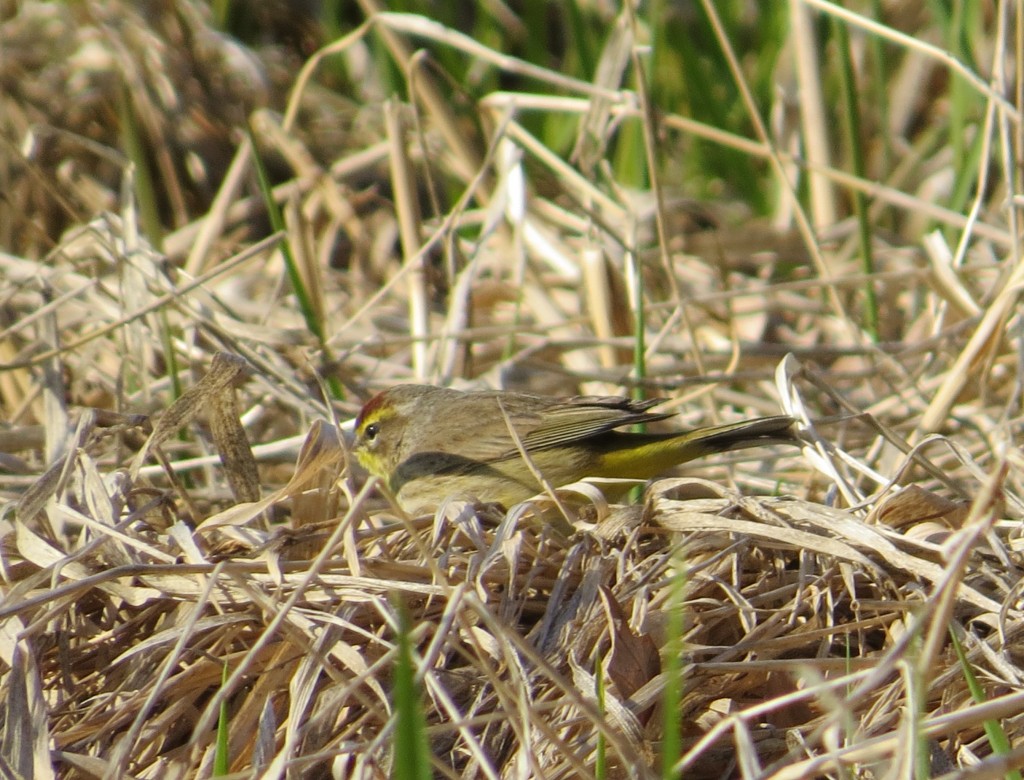
Palm Warbler
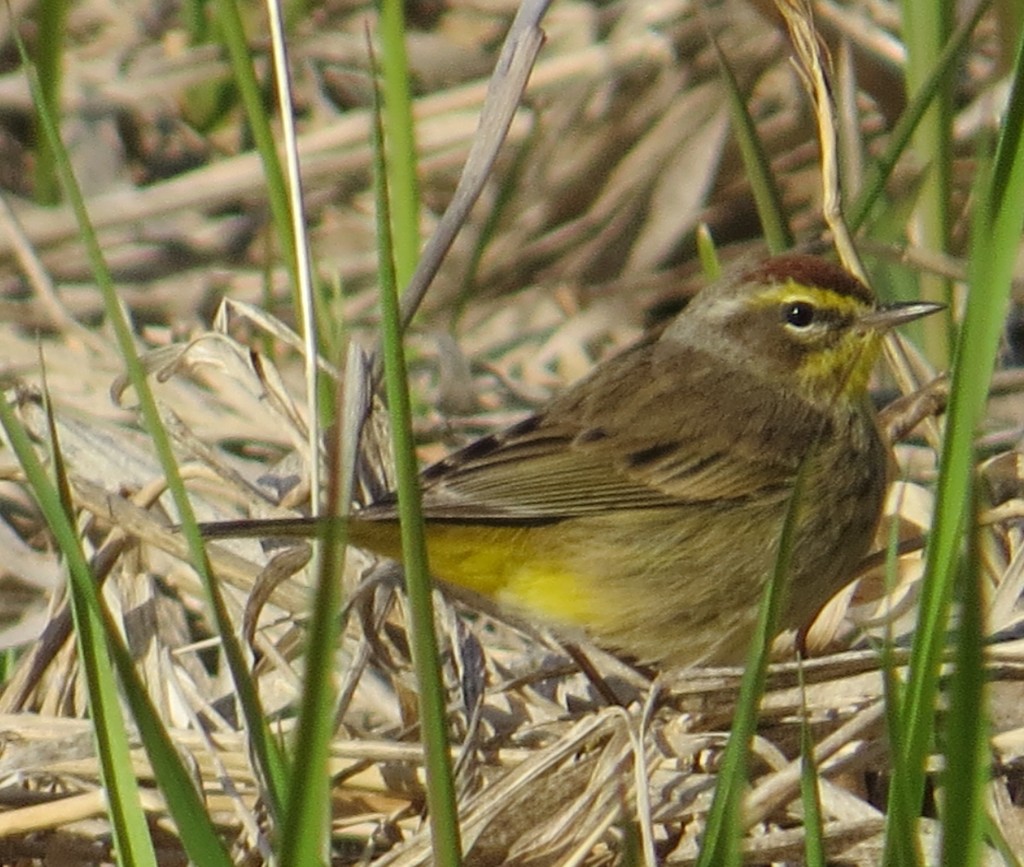
Warblers are tough to photograph, and I’m deciding that ground-skulking warblers may pose just as much of a challenge as the ones that flit about the treetops. It’s a good thing there are birds that pose, like this Veery.
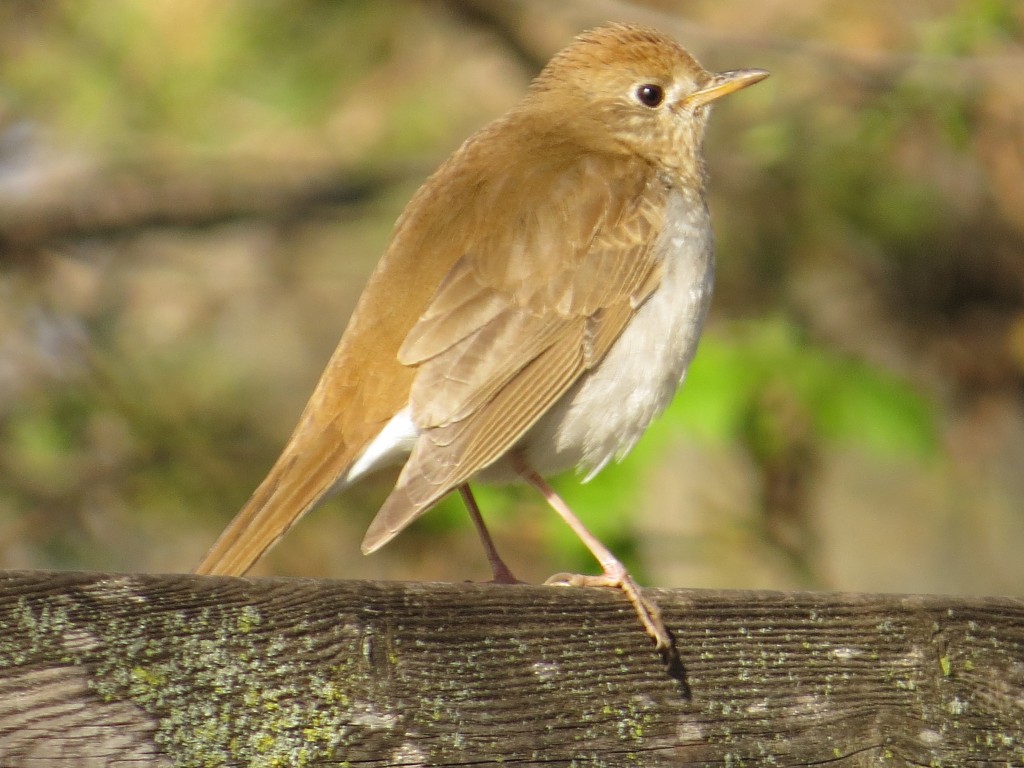
Veery
While I practiced bird photography, Evan was working on much more manly skills.
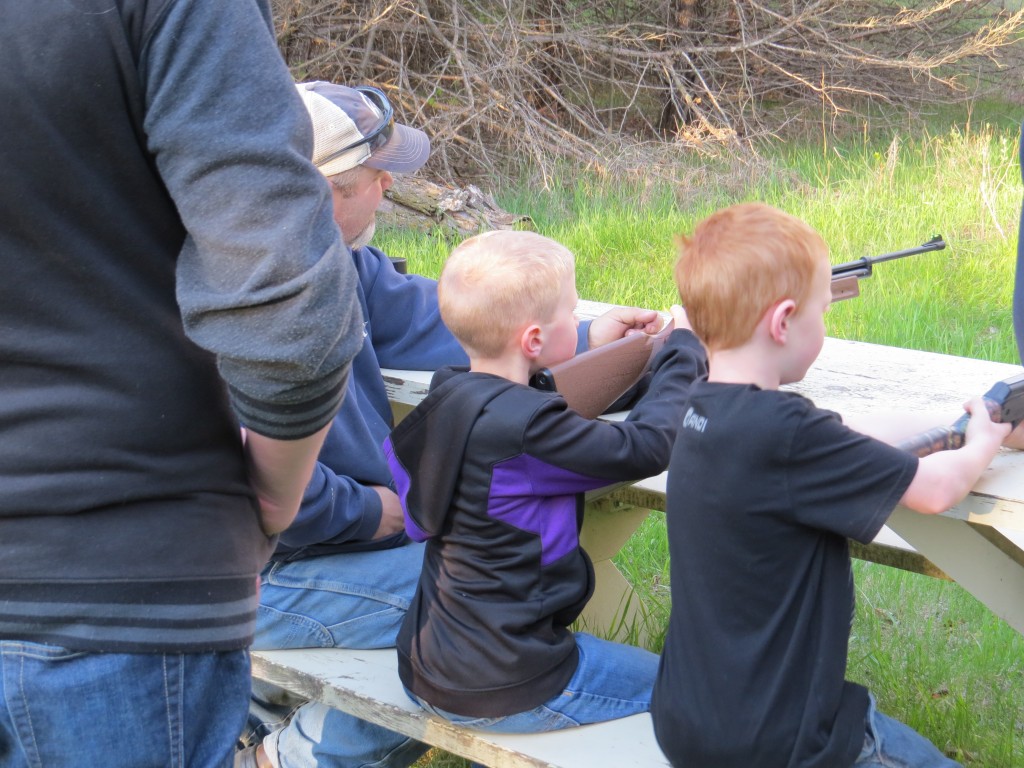
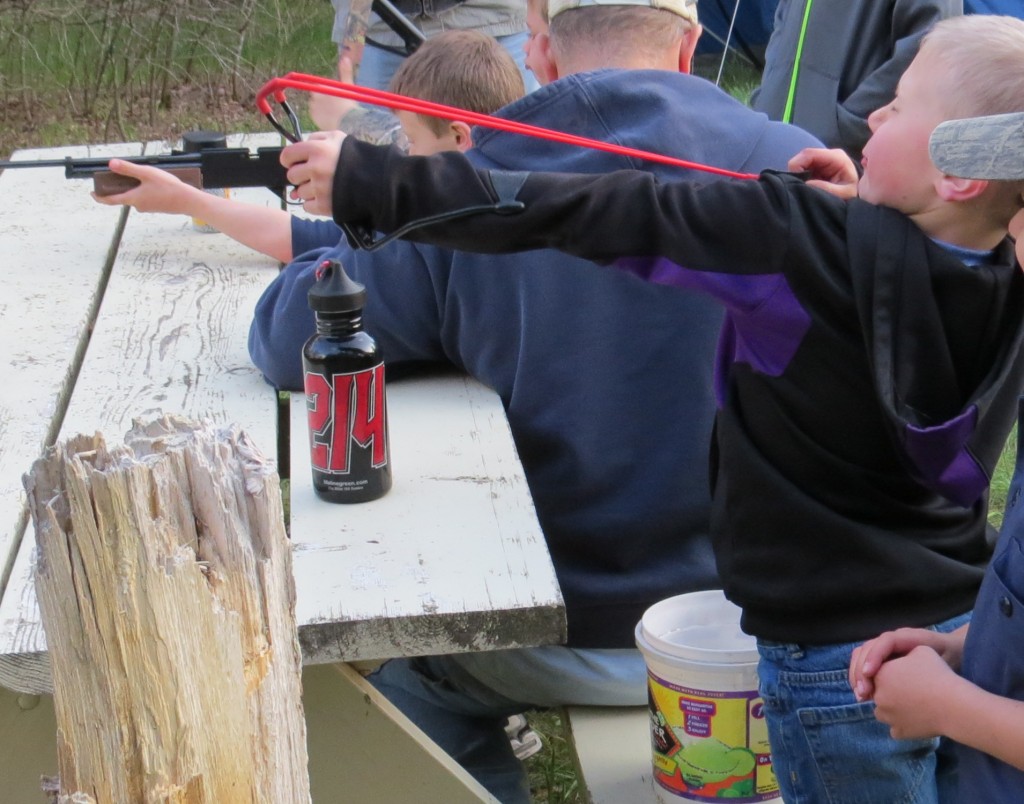
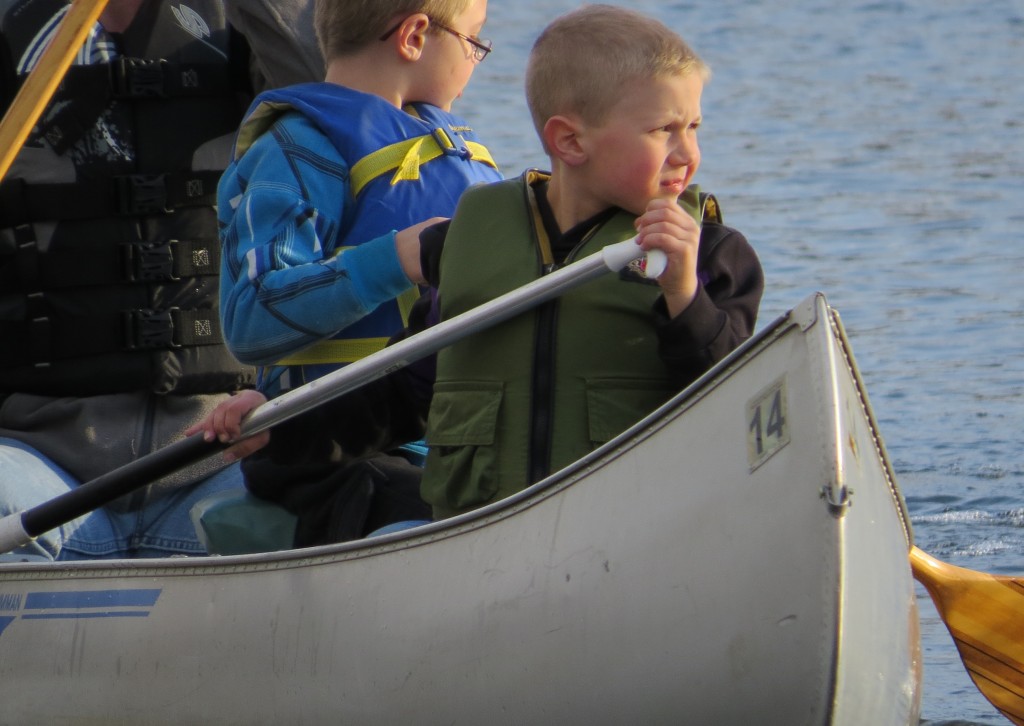
Though I took the picture above, I had taken Evan out earlier for a canoe ride. We were both thrilled to have four species of swallows buzzing right by our heads as they fed above the surface of the water. It got me thinking that I should dig out my canoe from behind the shed and do some birding with it. It’s a totally new perspective.
On Saturday at scout camp we headed to Sibley State Park for some geocaching. It was a mediocre experience considering we were in a group of about 12 people, over half of which were not scouts. I did get my Gray-cheeked Thrush lifer, but out of hesitation that I might actually be seeing a Swainson’s Thrush and that I was the only binocular-toting bird-nerd in the crowd, I opted not to draw more attention to myself by photographing the bird or pointing it out to Evan. I later regretted both decisions.
The “cache” that we located was quite appropriate – a bird card with the Yellow-throated Warbler. The very first pair of nesting Yellow-throated Warblers in Minnesota occurred at our very own Sibley State Park and were discovered by our friend, Randy.
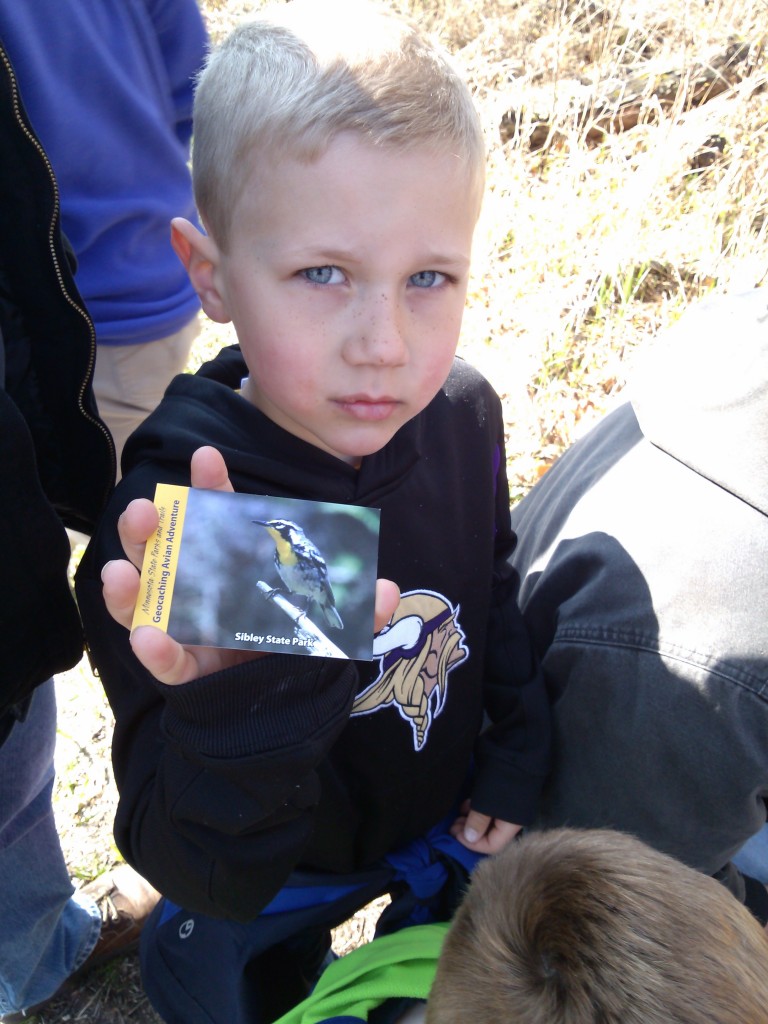
We saw some good birds at Sibley – Brown Thrasher, Yellow Warblers, Blackpoll Warbler, Golden-winged Warbler, Yellow-bellied Sapsucker, and quite possibly a Red-shouldered Hawk.
After scout weekend, Evan and I did our daily check of Bergquist Wildlife Area – a spot that can be walked in ten minutes if there are no birds. This time of year, with the birds changing daily, it takes a good hour to explore.
This particular day, Blackpoll Warblers seemed to be stealing the show.
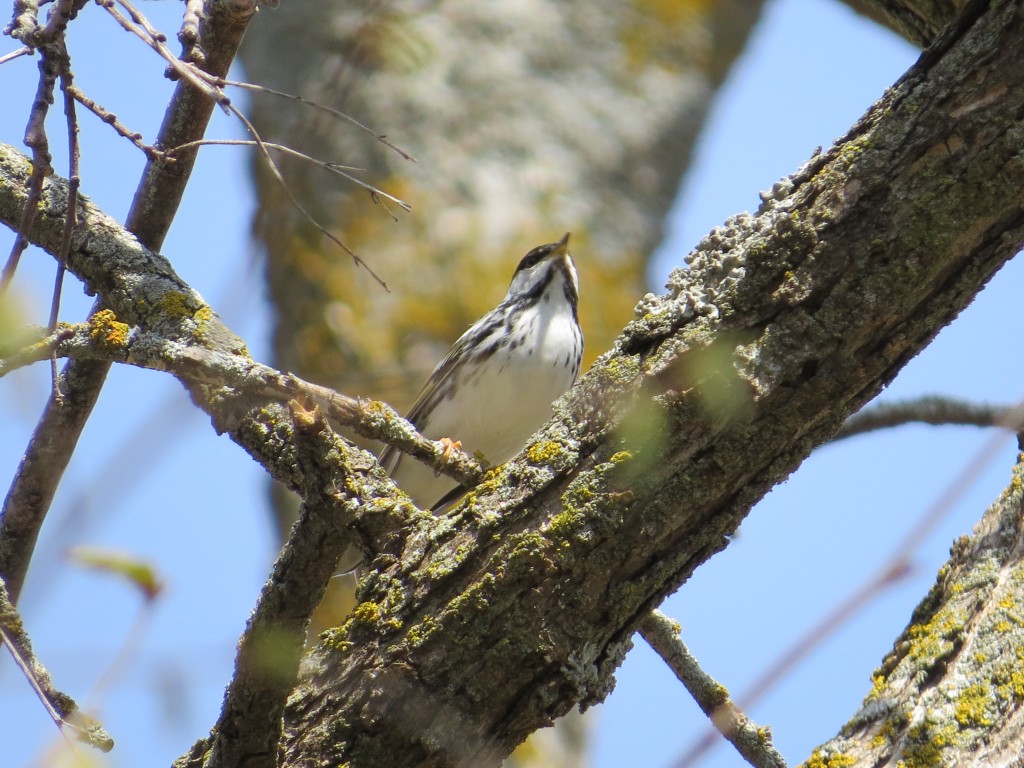
Blackpoll Warbler
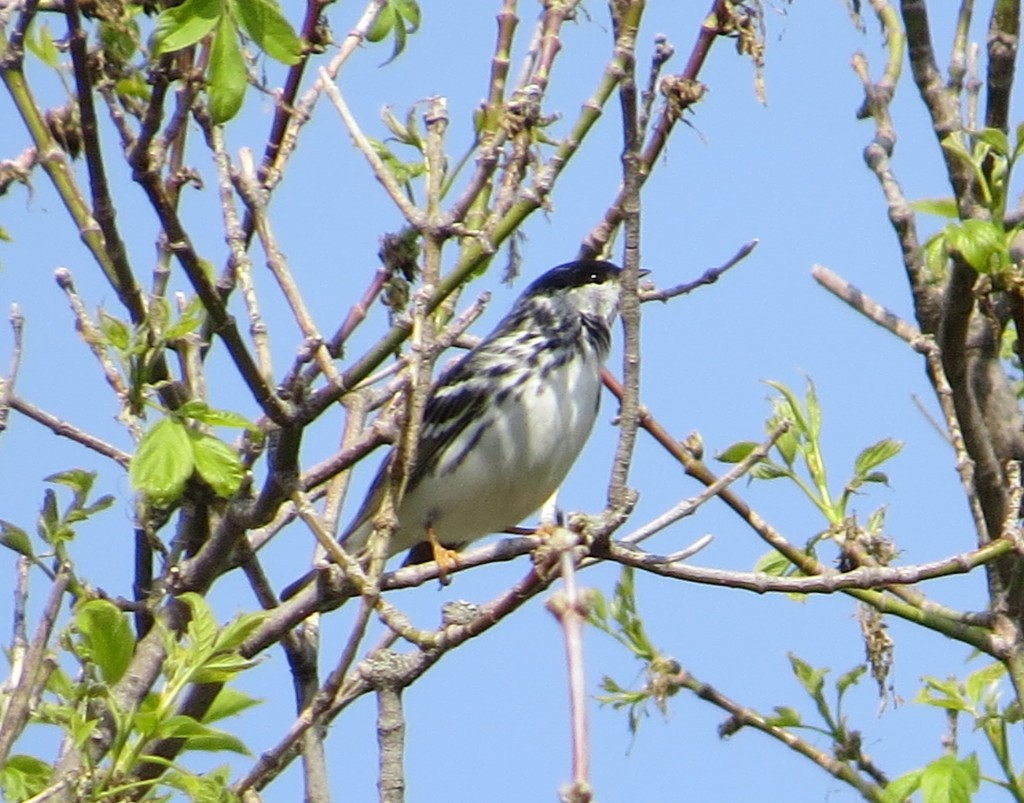
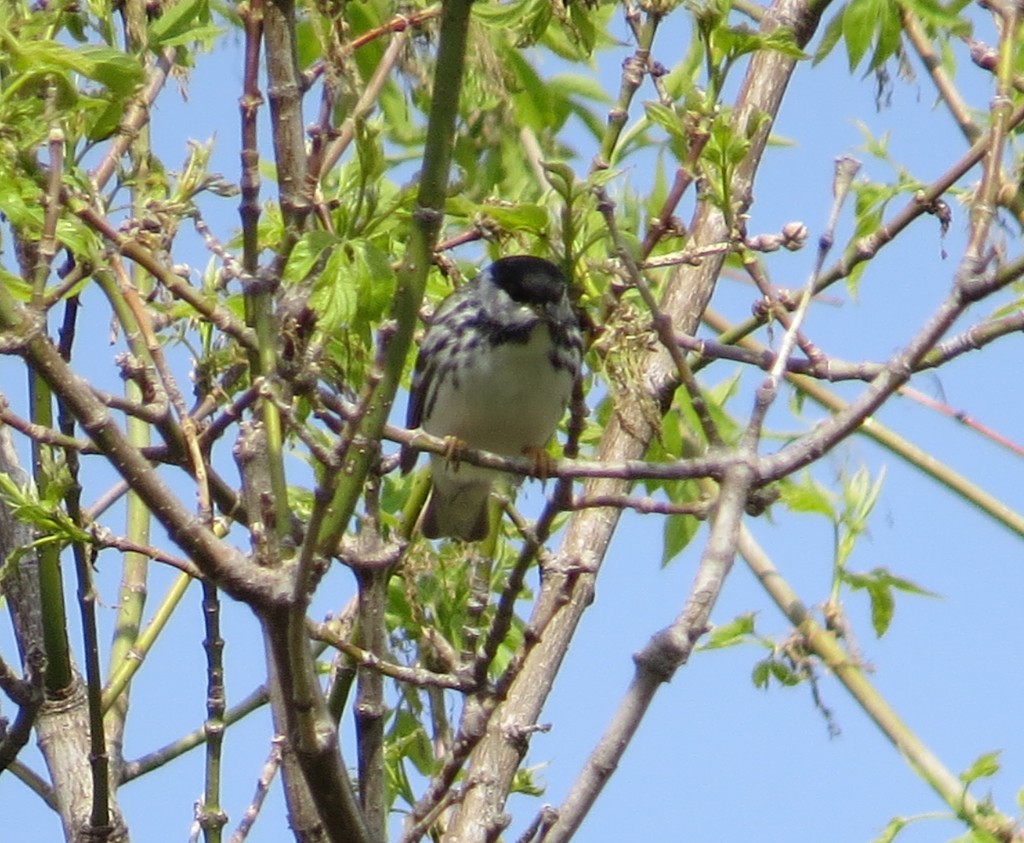
While I strained my neck looking at warblers in the treetops, Evan was again working on his warrior skills.
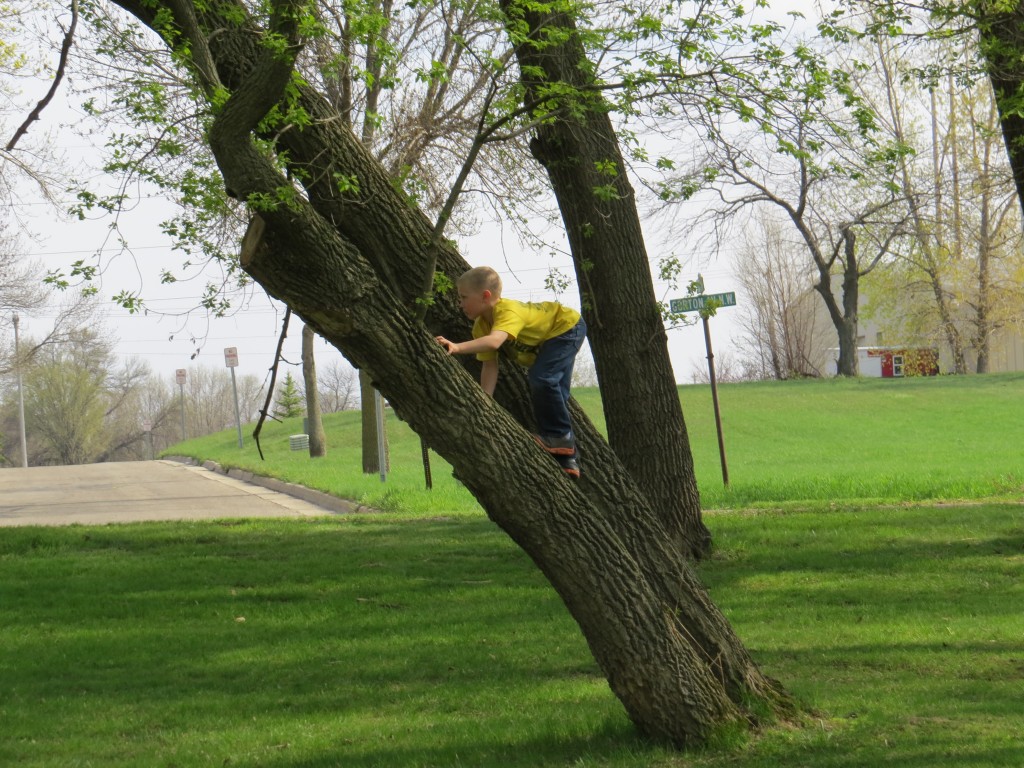
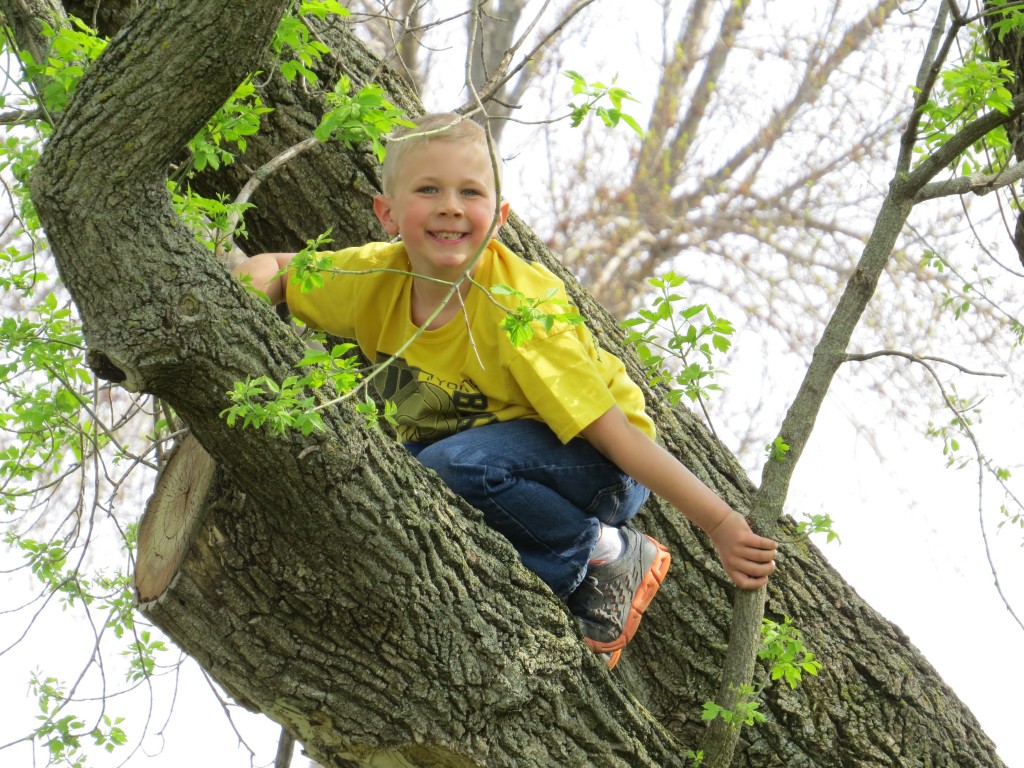
I was smiling like that too when I found one of my favorite warblers of all time – the Blackburnian Warbler who was more than willing to show off his flashy orange throat.
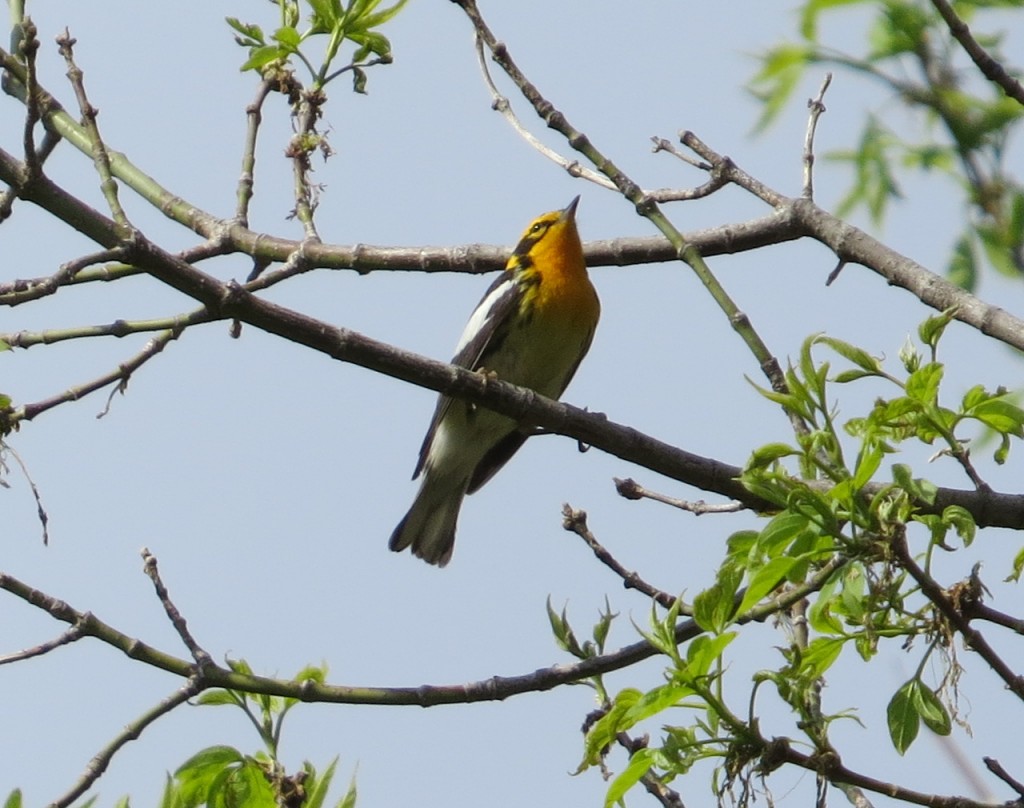
Blackburnian Warbler
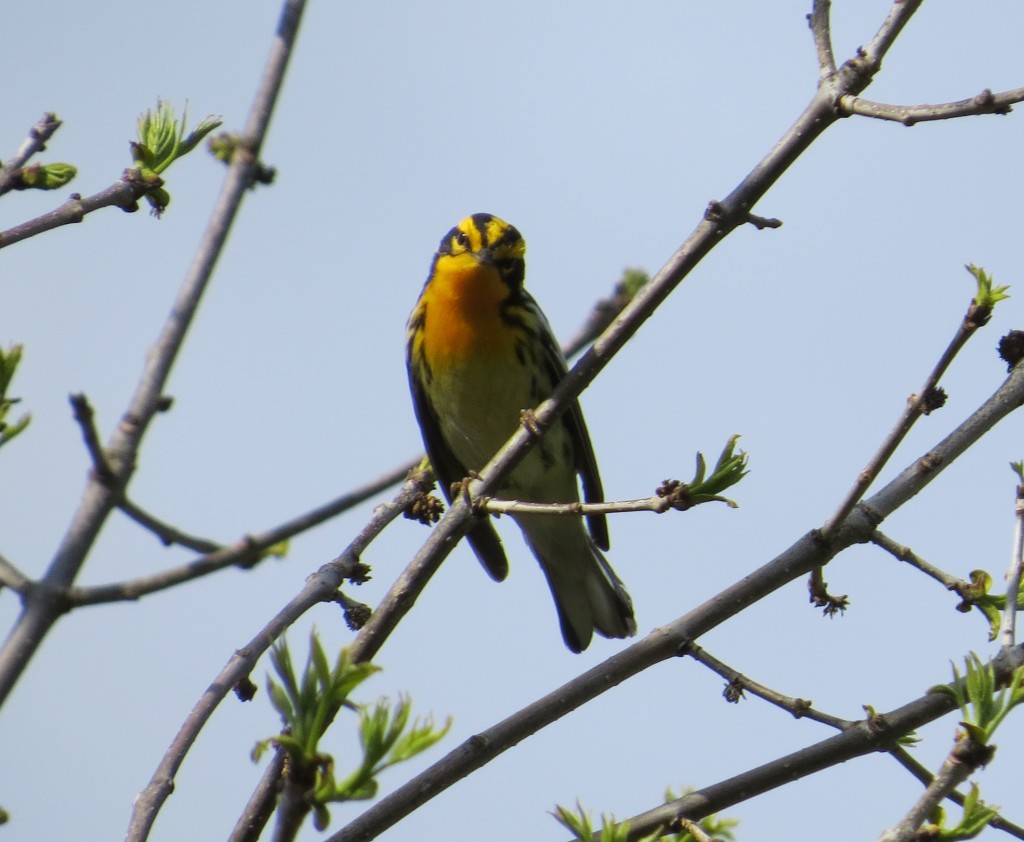 I wanted to keep photographing this bird, but it gave me the slip while I was checking on Hercules.
I wanted to keep photographing this bird, but it gave me the slip while I was checking on Hercules.
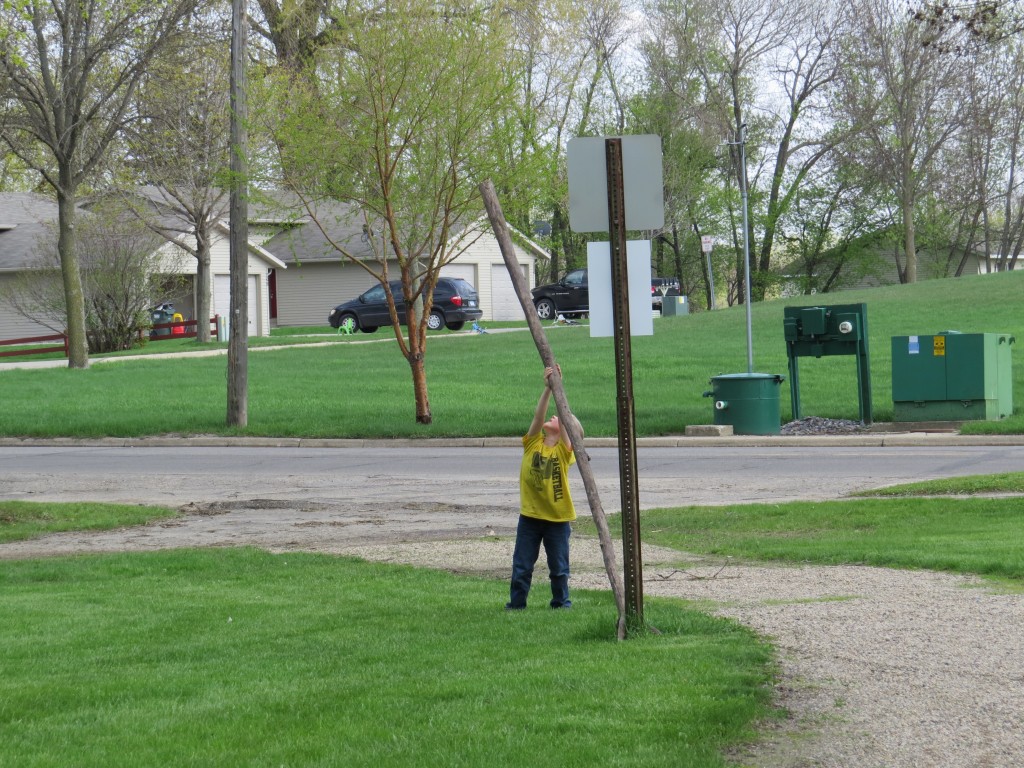 Though not as much fun as playing with dead wood, I photographed a couple of the more common warblers.
Though not as much fun as playing with dead wood, I photographed a couple of the more common warblers.
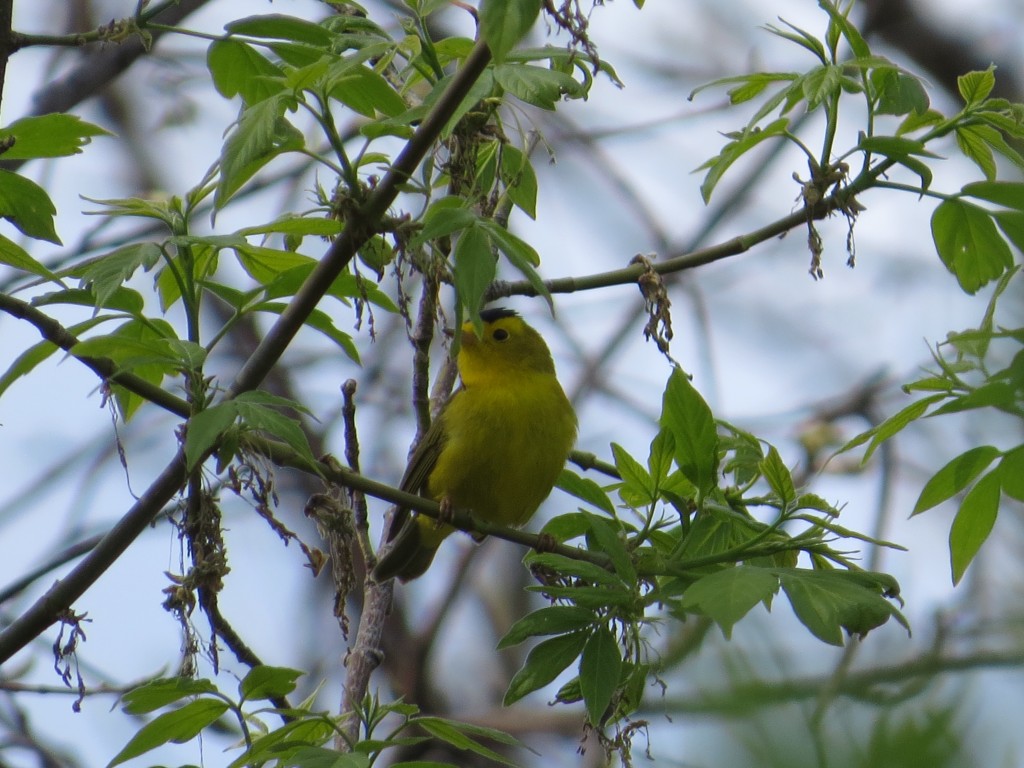
Wilson’s Warbler
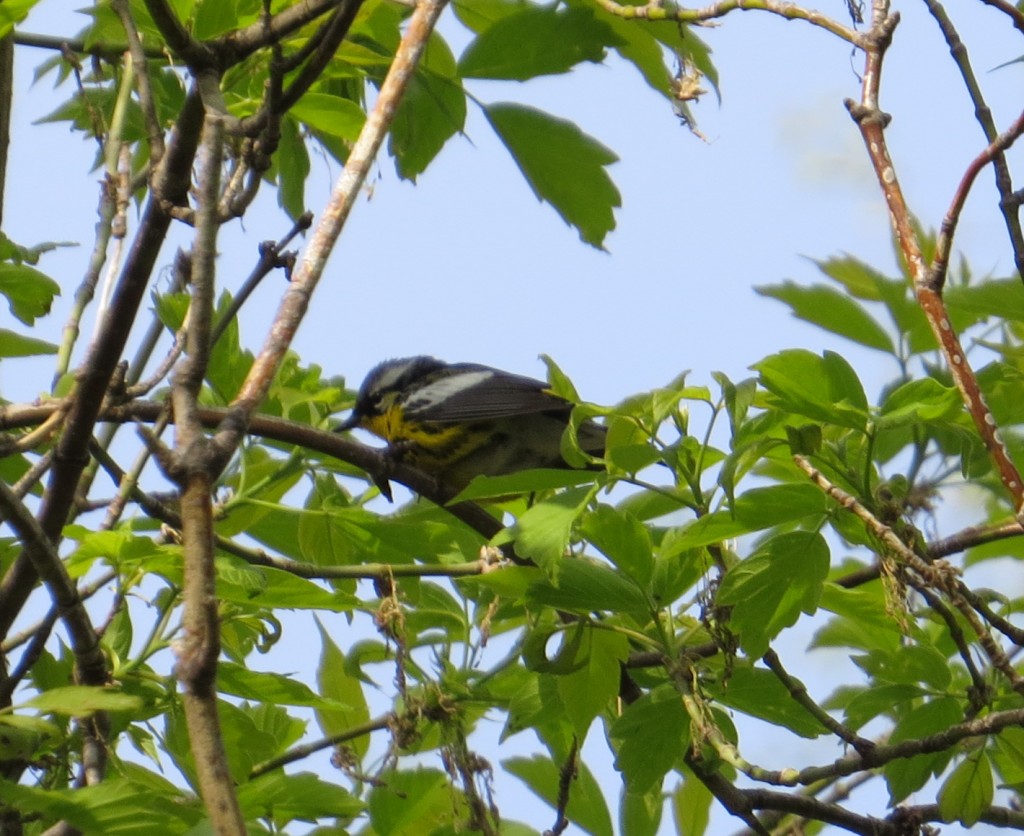
Magnolia Warbler
I was delighted to see that the Cape May pair is still hanging around in the same tree. It is getting very interesting that they are still here after two weeks and that there is a pair. We are way south of their breeding range.
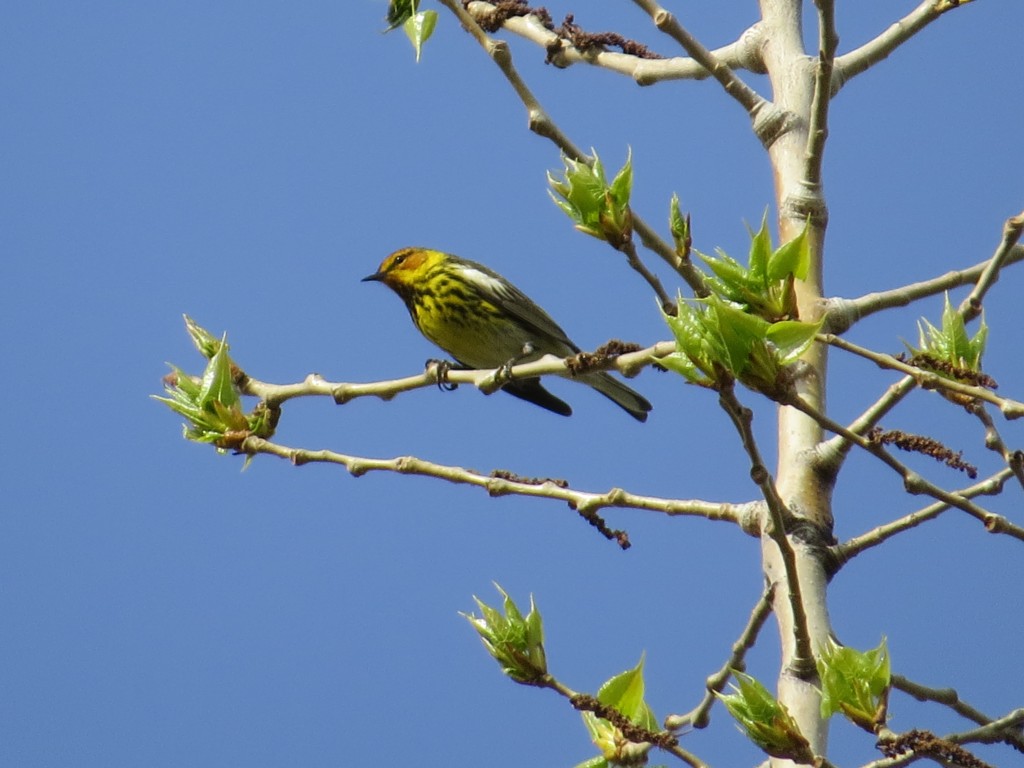
Cape May Warbler at Bergquist Wildlife Area
I’m still hoping to find a few last warblers at Bergquist before migration wraps up. They include Black-throated Green, Bay-breasted, Mourning, and Canada. Strangely we haven’t seen the ever-abundant Tennessee Warbler yet this year. I was finally able to catch up with a Northern Parula the other day. They are always a treat to see even if they aren’t very photogenic.
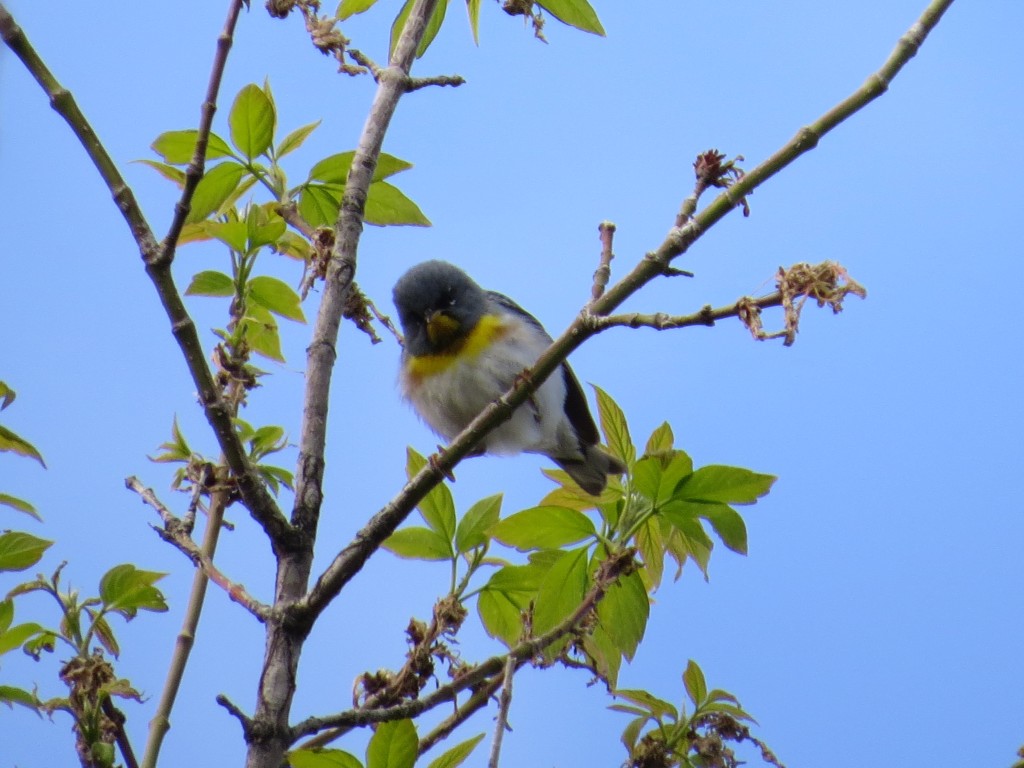
Northern Parula
We shall continue the hunt for more migrants for the next couple weeks. Then we will be putting Evan’s skills to the test as we go out camping this summer and hunting for warblers on territory. Stay tuned.
Tiny Dancers
This past weekend was an action-packed weekend full of visiting family. Not only was Mother’s Day part of the mix, but Marin had her first ever dance recital. Both sets of grandparents each made the 265 mile one-way trip to see first-hand the results of “hard-work” and hundreds of dollars on dance lessons. Surely the two-minute performance by a bunch of 3 and 4 year-olds would live up to the hype.
On Friday night we went to Marin’s recital. I knew there would be other ages dancing, but my jaw dropped when I looked at the program and saw a whopping 47 dance numbers, including a couple numbers by a womens’ group of 30-60 year-olds. (You read that right.) And no, we could not bolt after Marin’s class was done. It seems the higher-ups in recital planning have caught on to this dirty secret of parents and strategically scheduled one of Marin’s dance numbers near the beginning, one in the middle, and then included the little dancers in the finale with everyone else.
Right now the warbler migration is picking up some steam (warblers!) and we even have daylight until 9:00, and here I was settling in for not one, but two nights of dance. I asked Melissa how long the program would take. My sunken heart hit the floor when she said it would be 2+ hours – each night. Now my concern was no longer birding; it was survival. Sure I was excited to see Marin in her cute outfit trying to make her limbs do something that resembled dance, but 2+ hours! Melissa told me the secret to get through this was to find the dancers that were fun to watch – the ones with the infectious smile or the ones who never smiled – the ones who could move really well or the awkward ones you rooted for just to not crash and burn. Suddenly I had an epiphany: this was just like birding! You pick out the bird that’s fun to watch and ignore the rest. With this newfound connection and positive outlook, I was ready to watch some dance.
I’m not here to report on the recital, but I did survive, even the adult dancers’ group. Having been held back from a strong day of warbler migration and lingering shorebirds, I was out the door at first light on Saturday morning to get in on some of the action. Chasing the rare birds is fun, but currently there’s no other place I’d rather be than right near home with nearly two dozen warbler species dropping out of the sky. I couldn’t wait to watch these little dancers spazzing around much like a bunch of 3 and 4 year-olds on a dance stage. But really, I was after anything that was fascinating to watch, even the awkward ones.
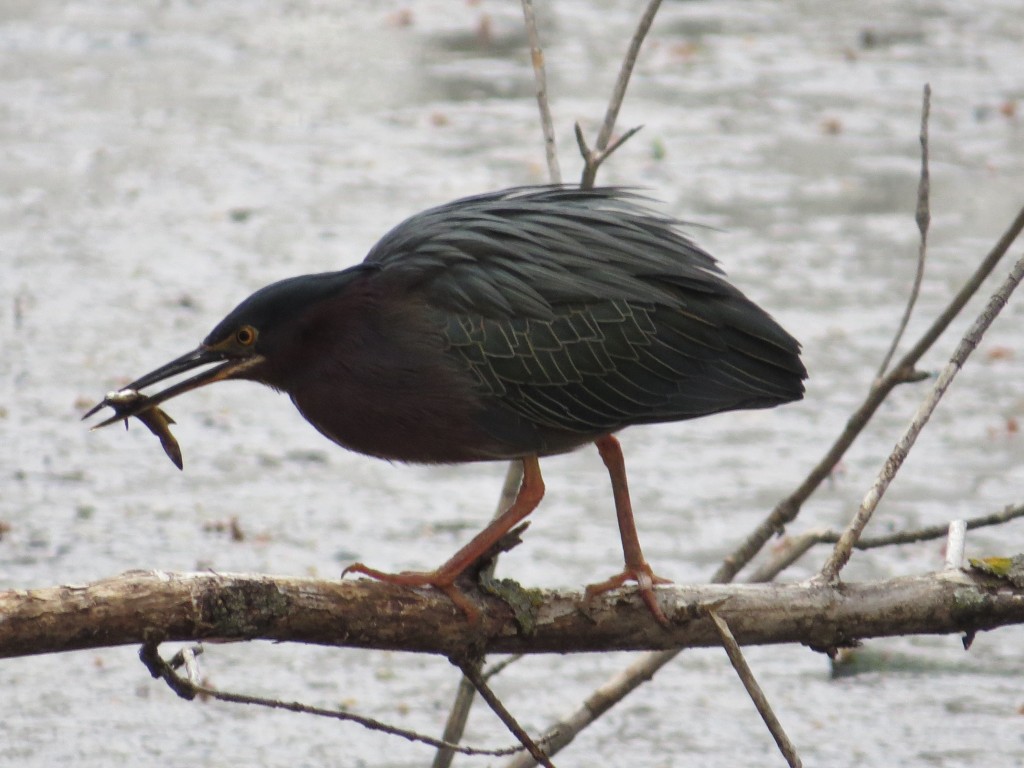
One of the awkward ones – the Green Heron
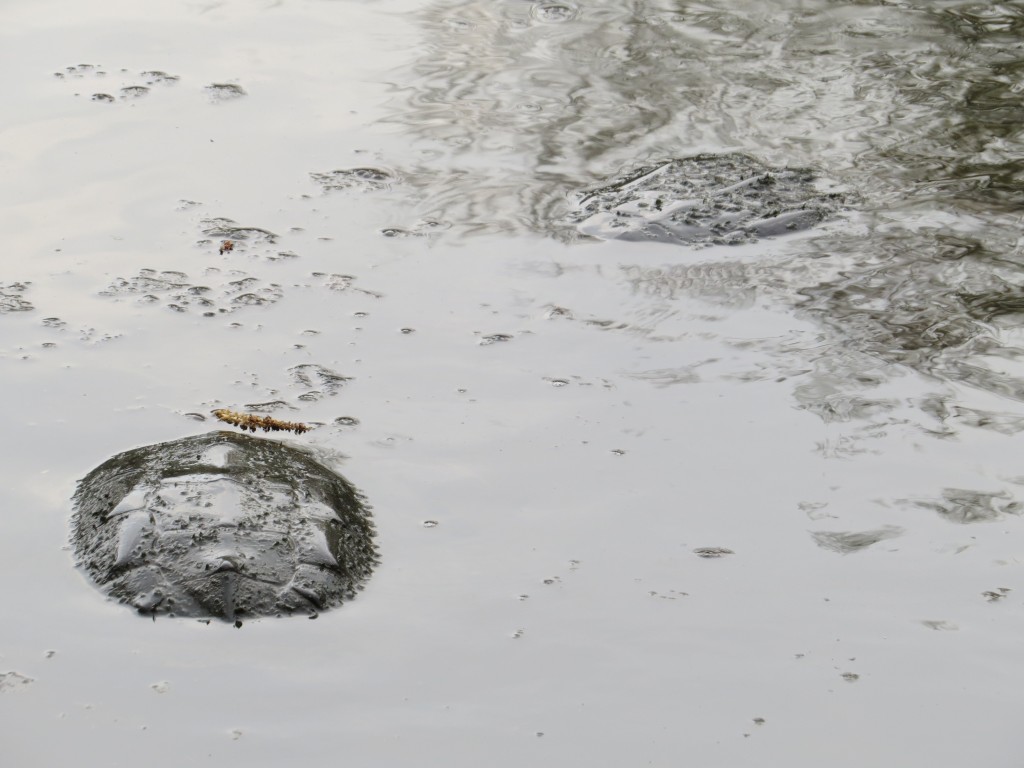
“Lovebird” Snapping Turtles – not birds, but most definitely an awkward encounter
Some of the many dancing warblers that aren’t as much fun to watch include the abundant Yellow-rumped Warblers, the extremely dull Orange-crowned Warblers, and the sort-of-bland-sort-of-colorful Nashville Warblers. I did find one dancer on which to focus my attention, the stunning Magnolia Warbler. As my picture shows, I was reminded of just how dificult these ADHD birds are to photograph.
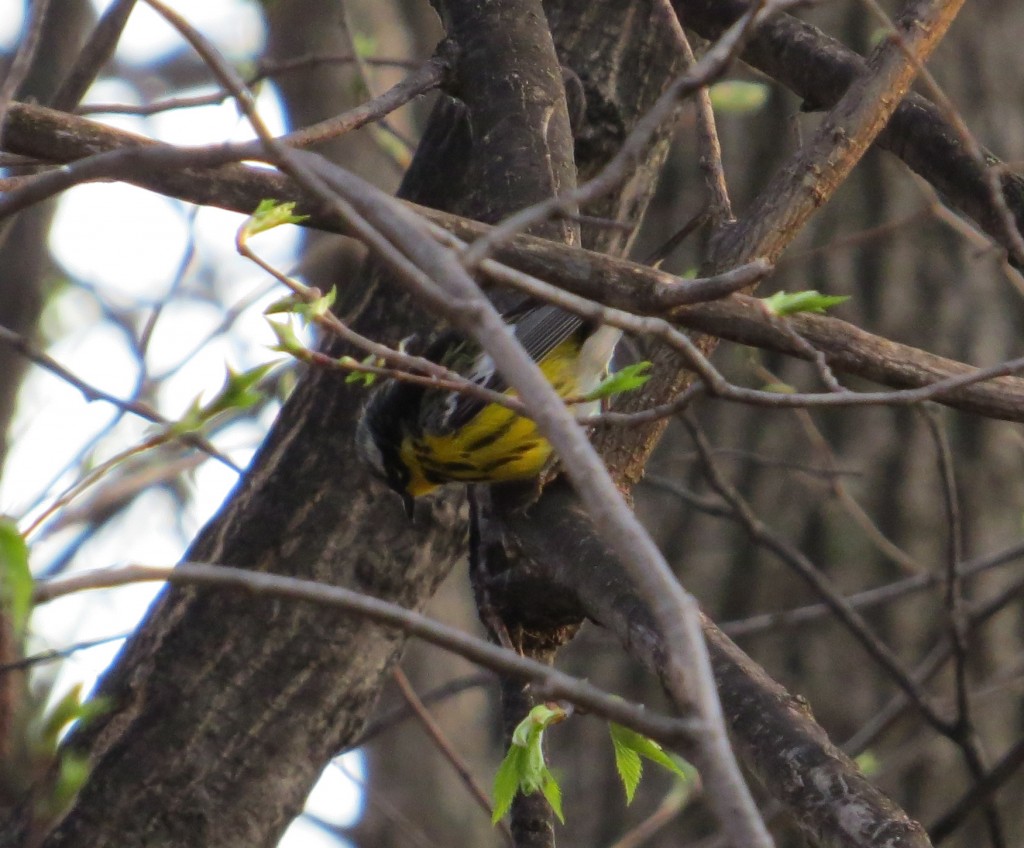
Magnolia Warbler
Another one of the birds I spent a great deal of time focusing on was a real key find for our area. The Cape May Warbler is not a common migrant, proven all the more by 300-club member Joel who has never seen one before this past week. But Joel did find one, and remarkably this male was with a female and they have been hanging on for nearly a week, visiting the same tree. This was only my second experience with a Cape May, and both times I have been surprised by how mellow they are by warbler standards. They generally don’t move a whole lot. It was fun to watch the pair interact with each other. That said, I focused mostly on photographing the male.
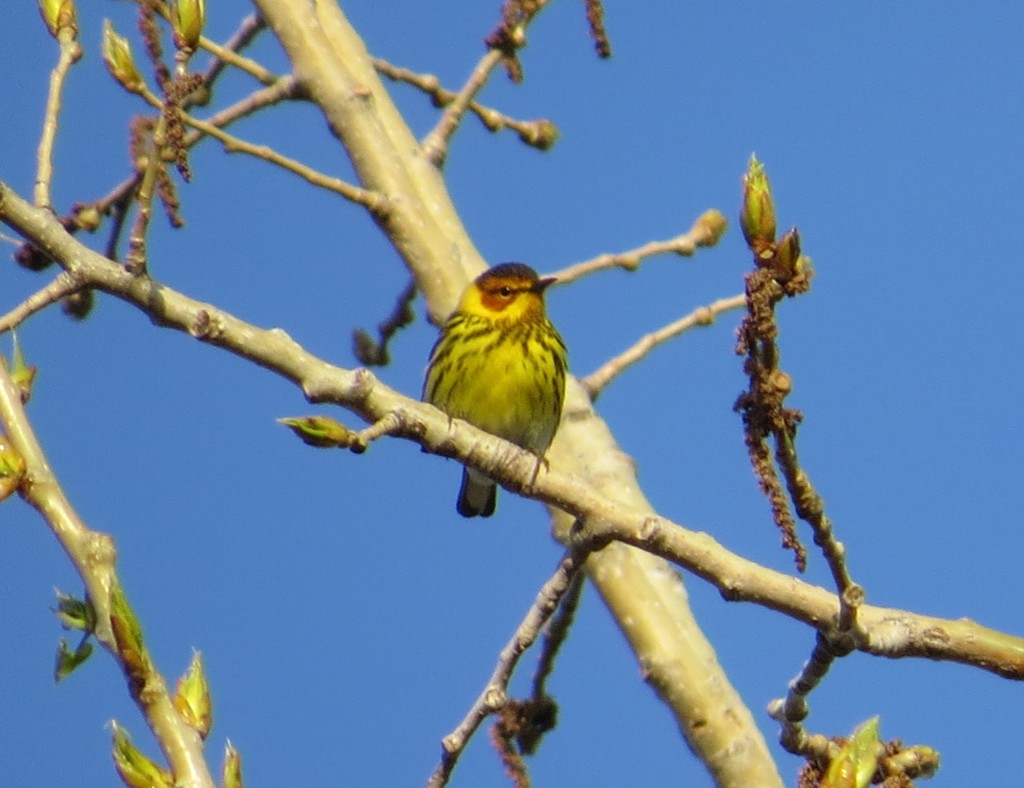
Cape May Warbler
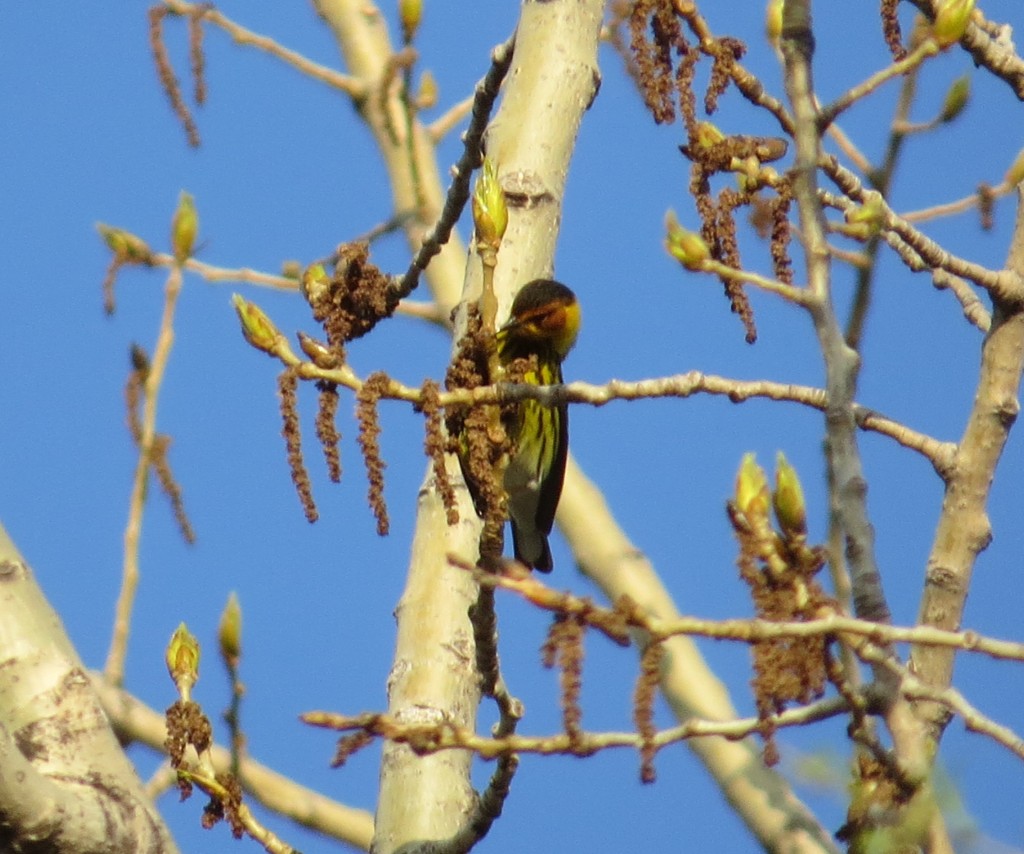
Classic Cape May pose – craning the neck to get some chow
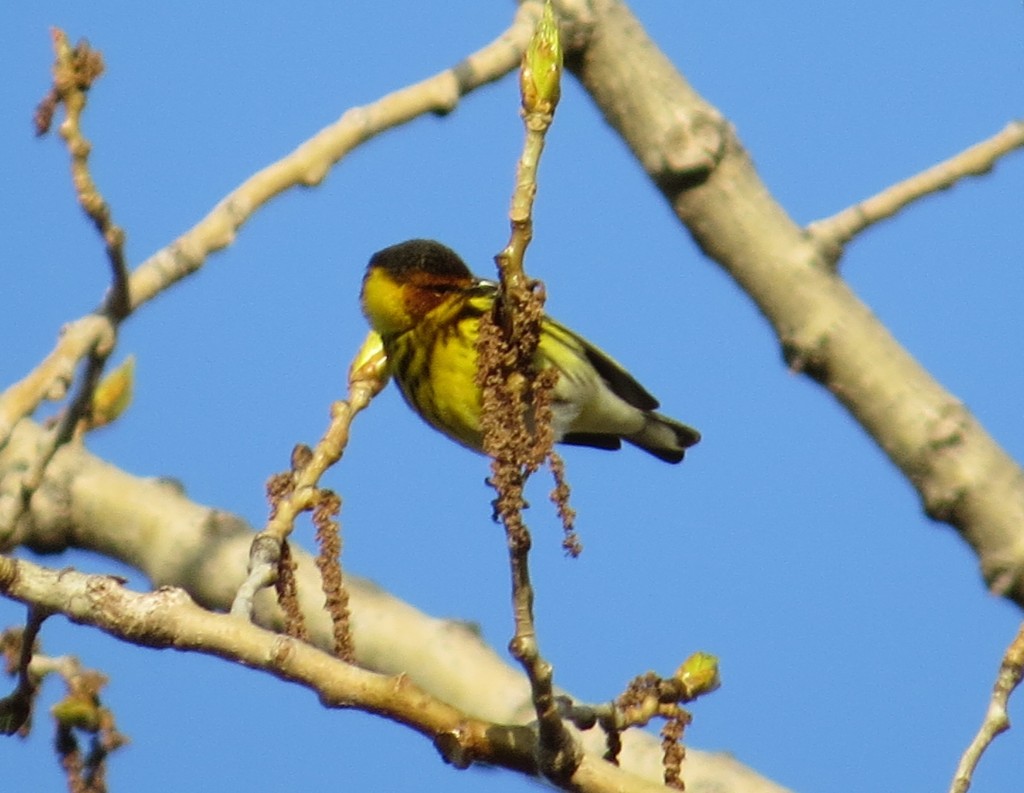
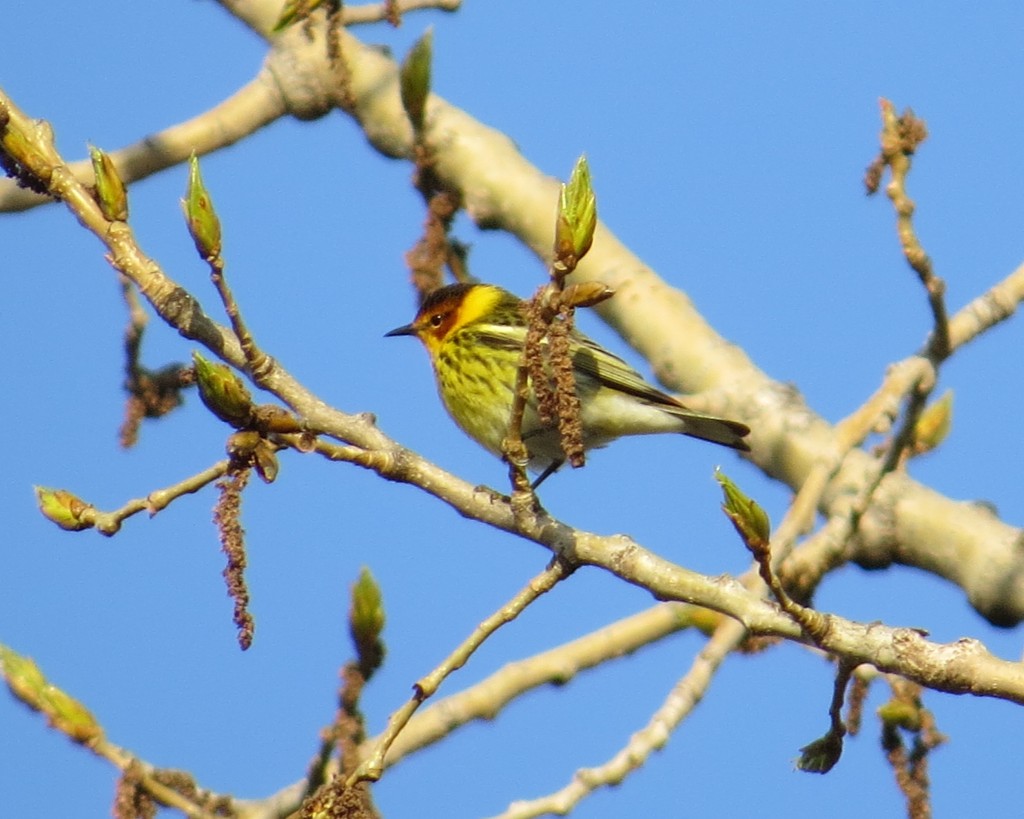 A Cape May is a darn nice bird and after getting some shots I was pleased with, I was feeling everything would be okay again even with round 2 of the recital on the horizon.
A Cape May is a darn nice bird and after getting some shots I was pleased with, I was feeling everything would be okay again even with round 2 of the recital on the horizon.
Another bird that my dad and I spent our time watching and tracking later in the day was the Red-headed Woodpecker! This is now the third time I have found one, and it is never any less thrilling than the first time. This species is quite stunning and on the decline. It is always a delight to see one.
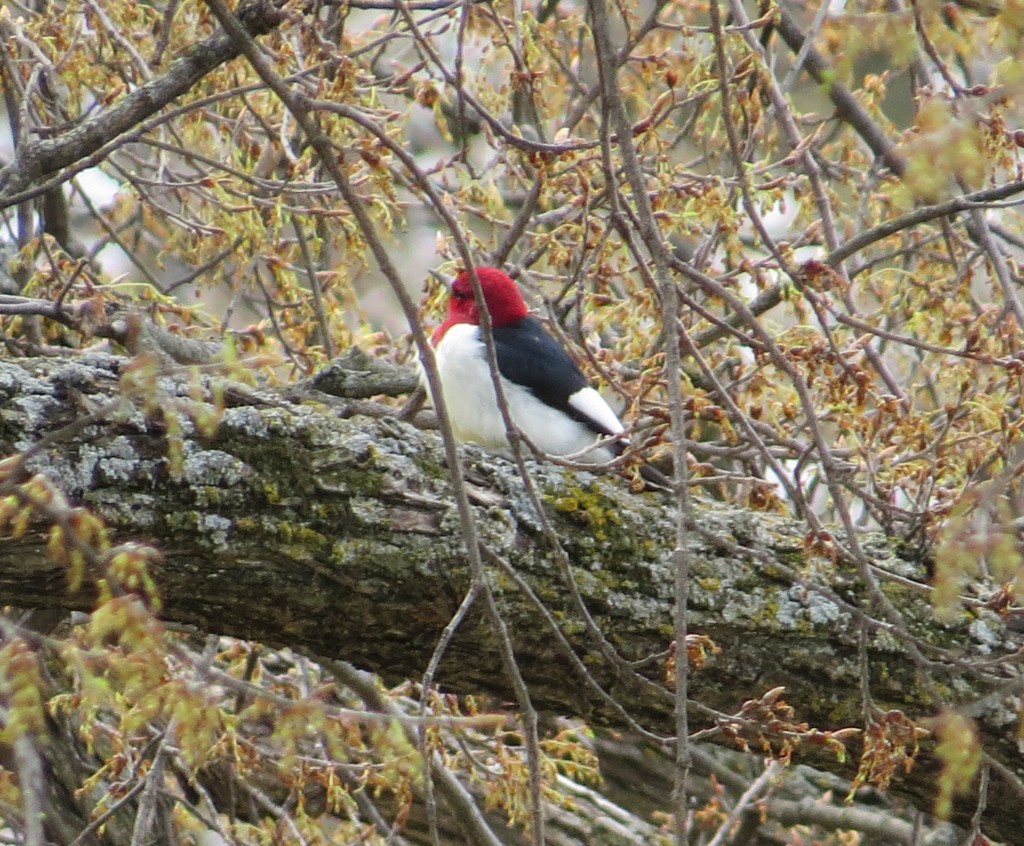
Red-headed Woodpecker
On one of my outings this weekend, one bird that grabbed and held my attention was the Golden-winged Warbler! This is one of my favorites and only the third time I’ve seen one. Now I was getting stellar looks at this bird in the beautiful morning light from 6 feet away as it foraged on the ground in the weeds. The views were spectacular but the photography proved quite challenging as it never really came in the open.
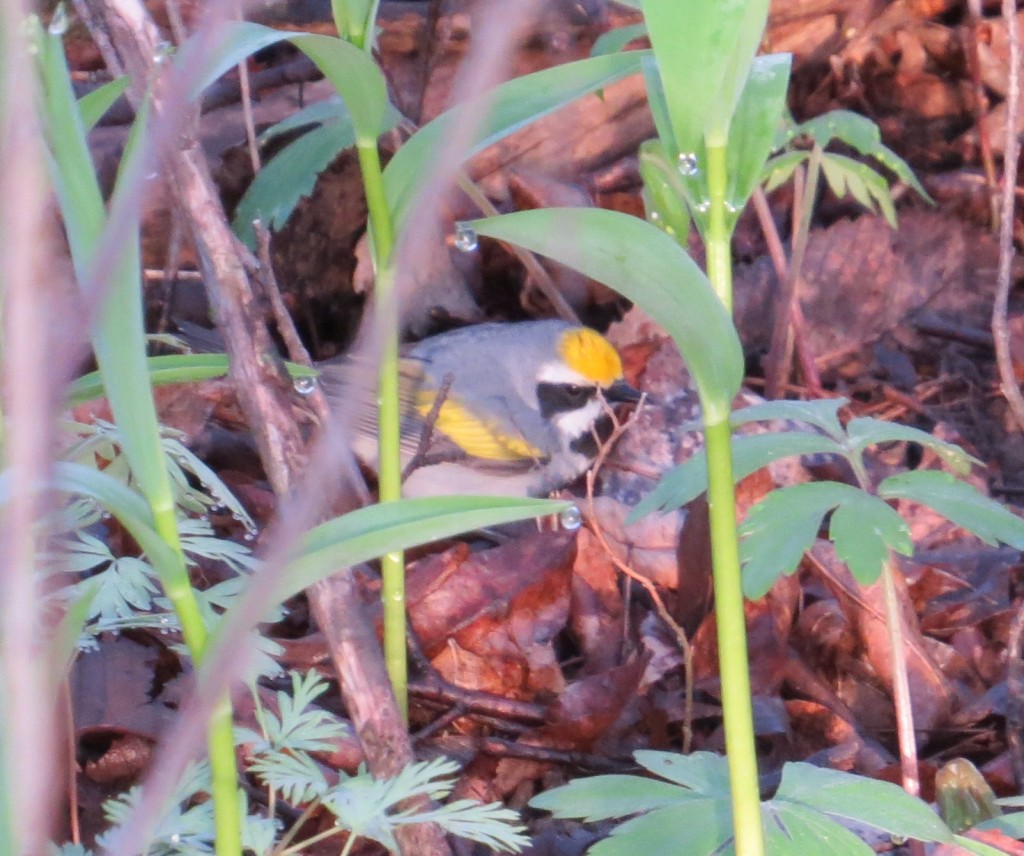
Golden-winged Warbler
With a good amount of imagination, I think you can see just how good of a picture this next one might have been. It definitely captures the essence of this bird, which is good enough and worthy of being posted. I love this bird. I can’t wait to go on the hunt for it when it’s on territory in northern Minnesota this summer.
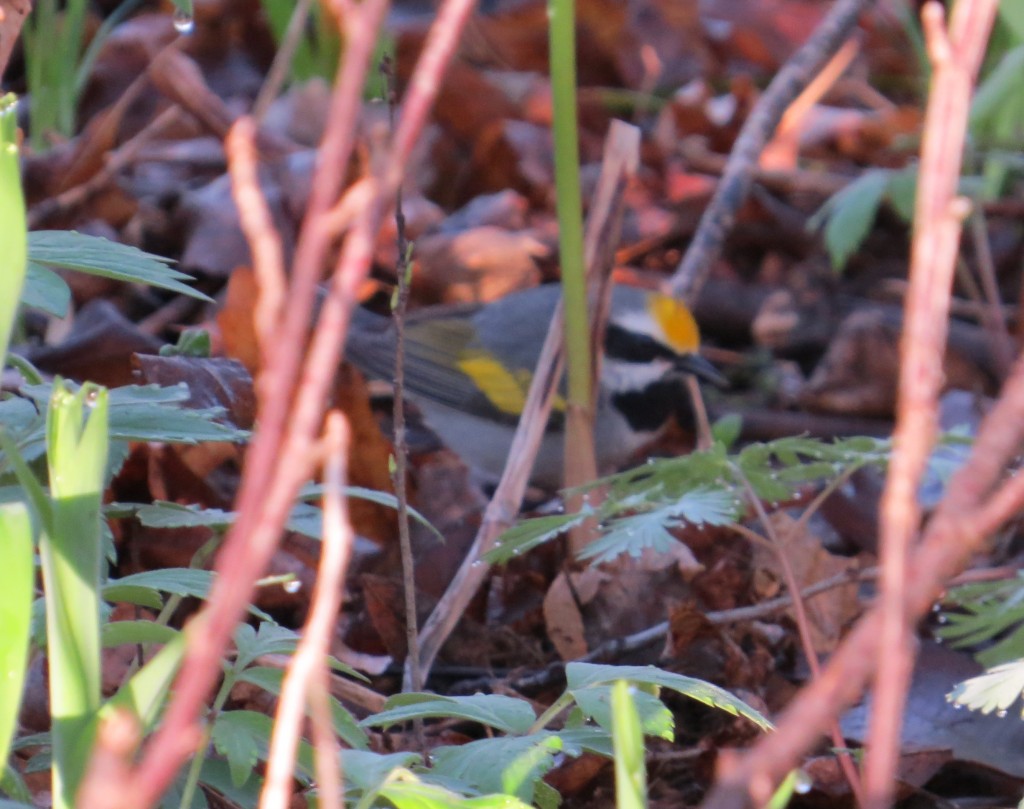
According to the Minnesota Conservation Volunteer, Minnesota has only 10% of the GWWA’s breeding habitat but over 40% of the breeding population!
Some dancers are so well-costumed that their outfits are striking and demand your attention, like this appropriately named Black-and-White Warbler.
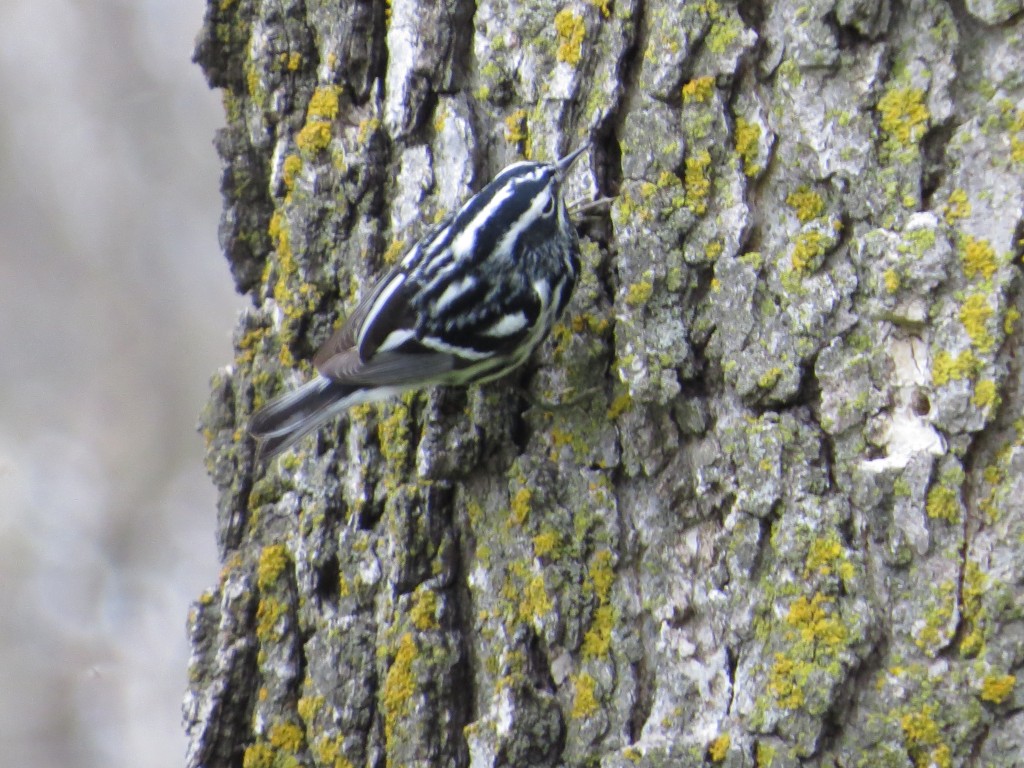
Black-and-White Warbler
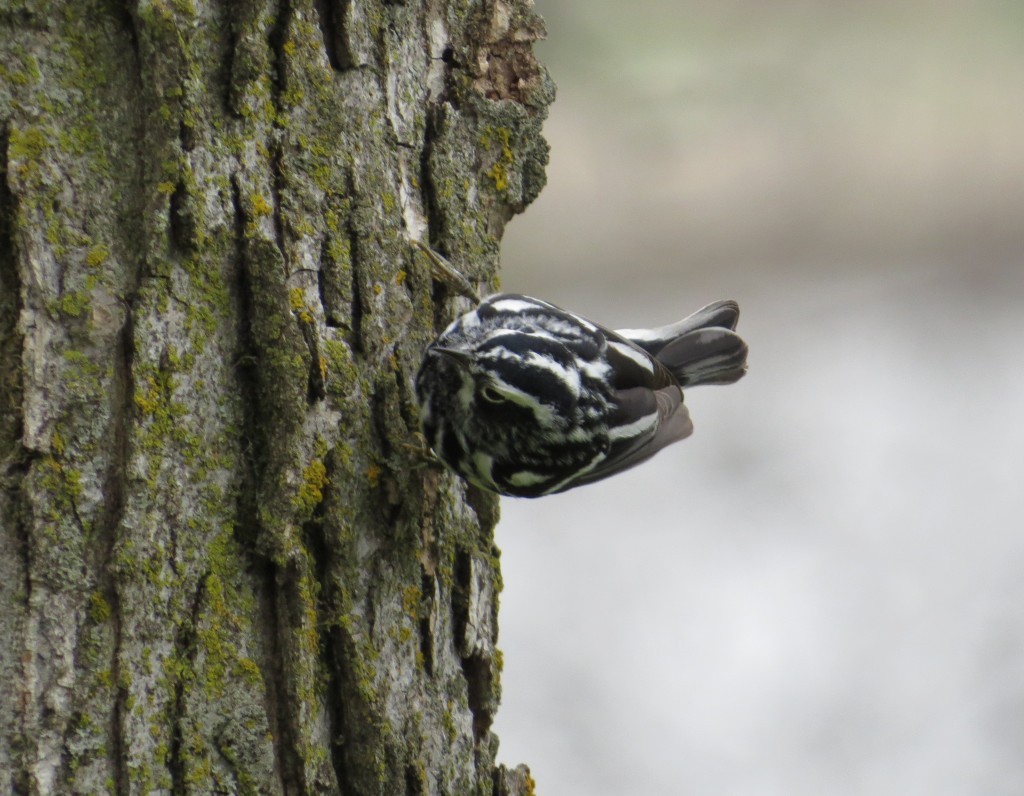 Sometimes the most unassuming dancers can hold your attention, like this Lincoln’s Sparrow. It is no warbler, but it is arguably one of the best sparrows.
Sometimes the most unassuming dancers can hold your attention, like this Lincoln’s Sparrow. It is no warbler, but it is arguably one of the best sparrows.
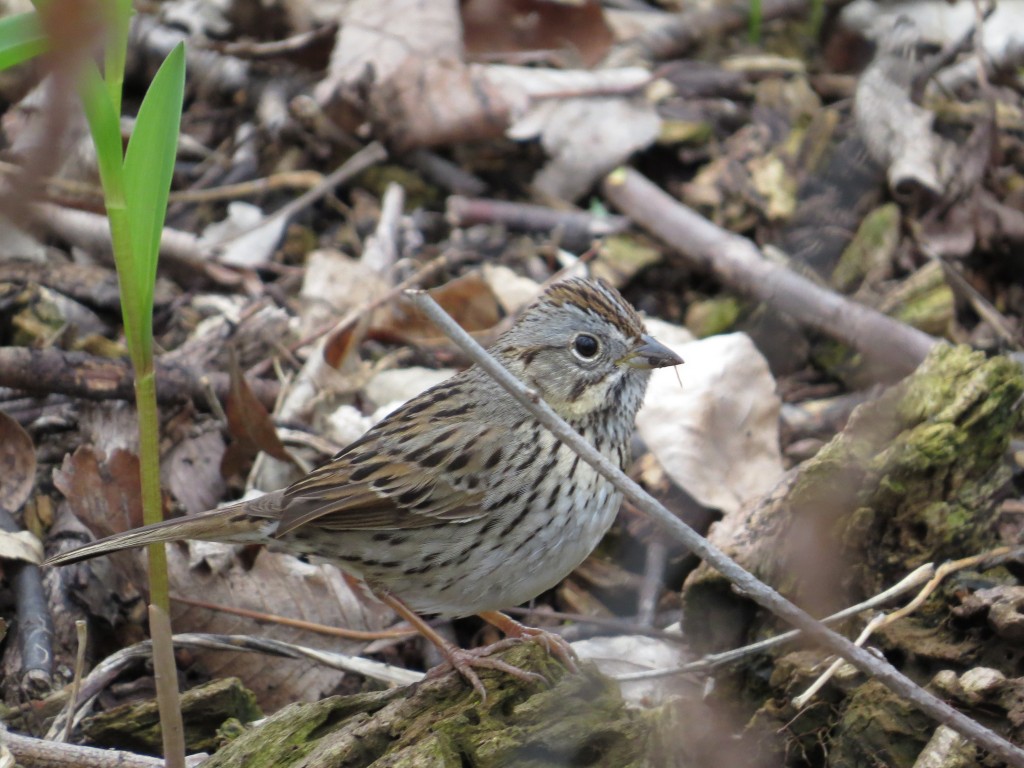
Lincoln’s Sparrow
But from time-to-time, one needs to watch the other things on the dance floor even if those things aren’t the most interesting things that are out there.
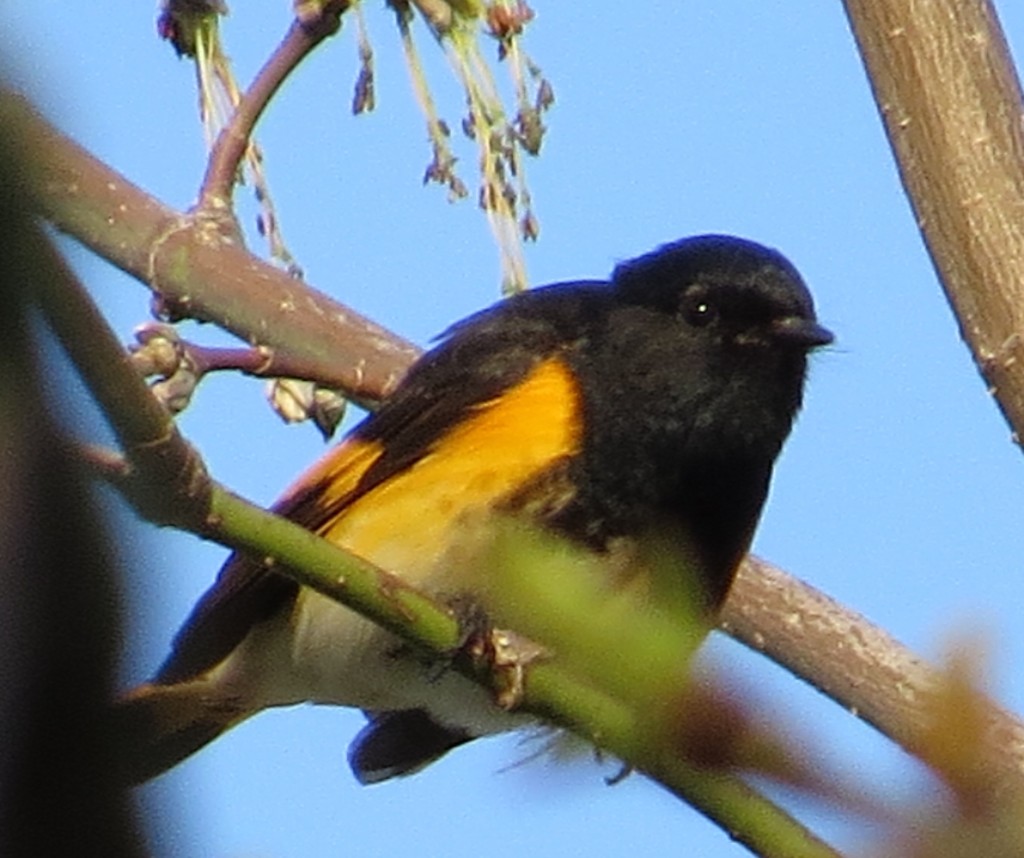
American Redstart
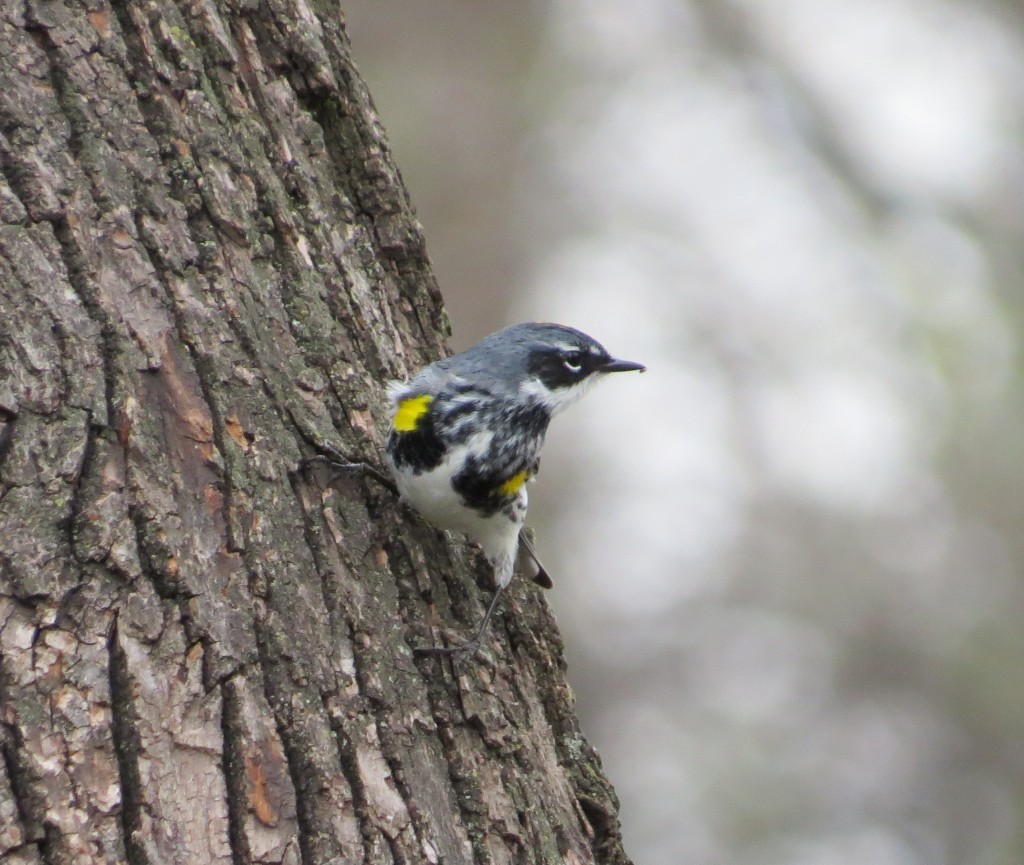
Yellow-rumped Warbler
It was a great weekend of dance and birding. Picking out the fun ones ensured that the time was well spent.
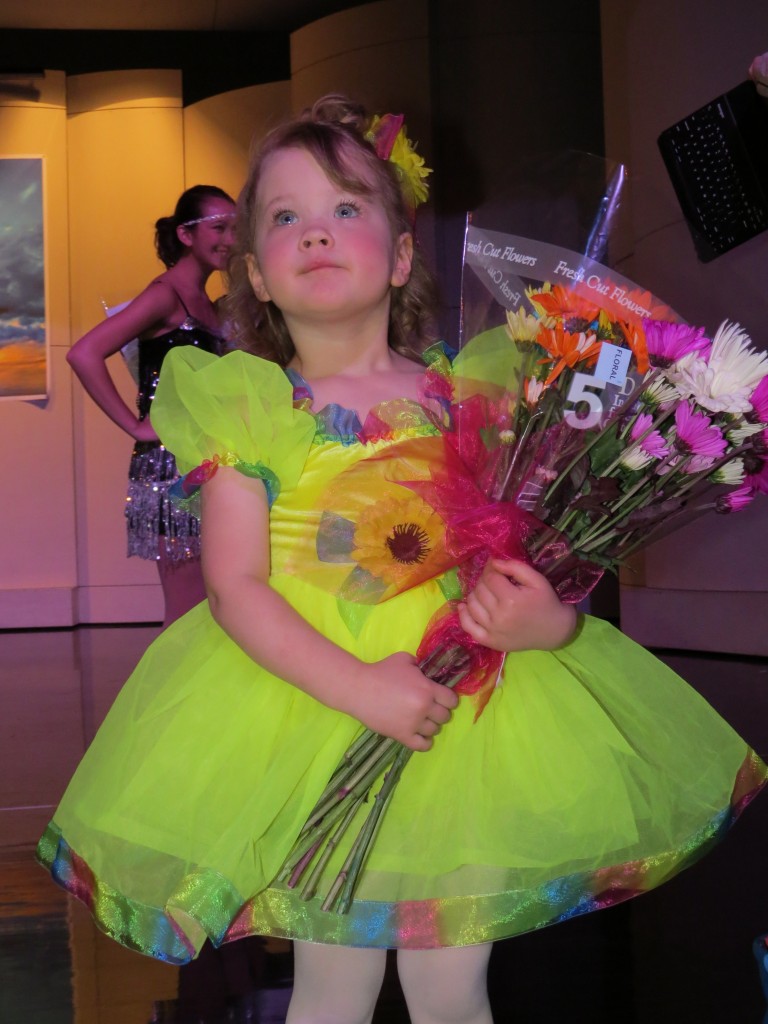
One of the fun ones.
Get the Oranges and Grape Jelly – Stat!
Not only do we tell you about our birding adventures on this blog, but we also use it from time to time as a platform for public service announcements. So here it is – if you want to see orioles in your yard, get your oranges and grape jelly out NOW! Don’t worry about taking down those Christmas lights – I know I didn’t.
It’s very simple to get started: cut an orange or two in half and set them out on a deck railing, tree branch, etc. Then put out a bowl of grape jelly. YOU DO NOT NEED FANCY FEEDERS. Don’t wory about it. The orioles don’t.
I saw radar maps of migrating birds that showed today would be a banner day. So before I turned in for the night last night, I followed my own advice and put out the oranges and grape jelly. And right away this morning I was rewarded with two Baltimore Orioles.
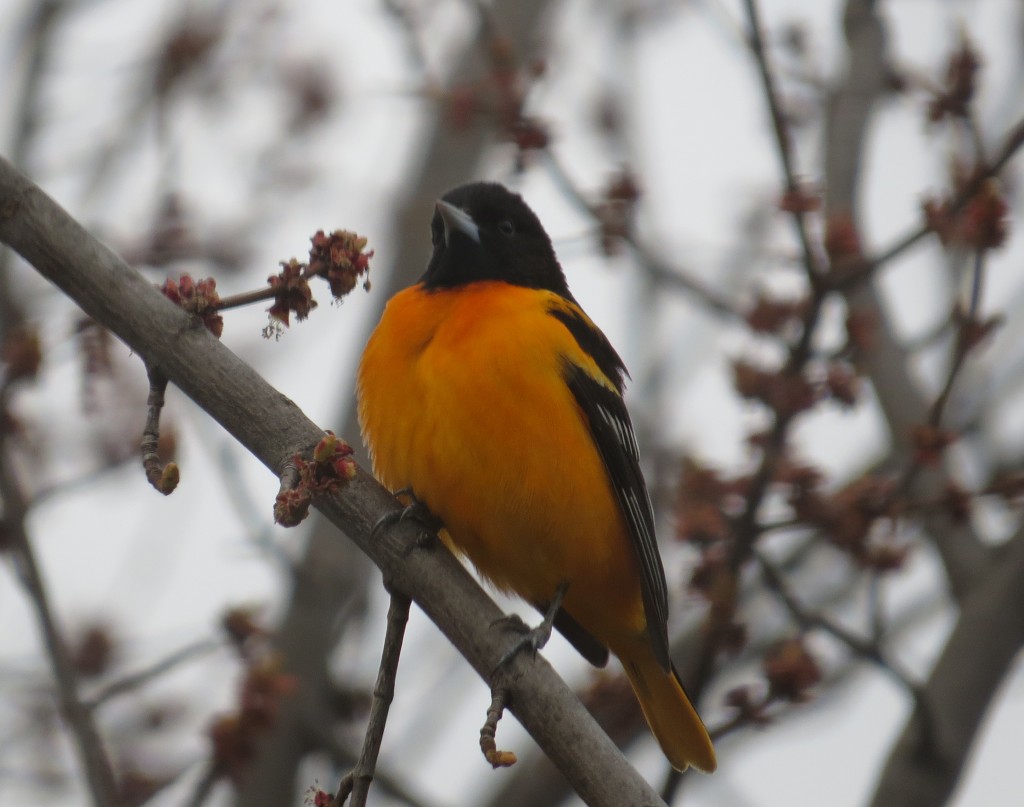
Baltimore Oriole
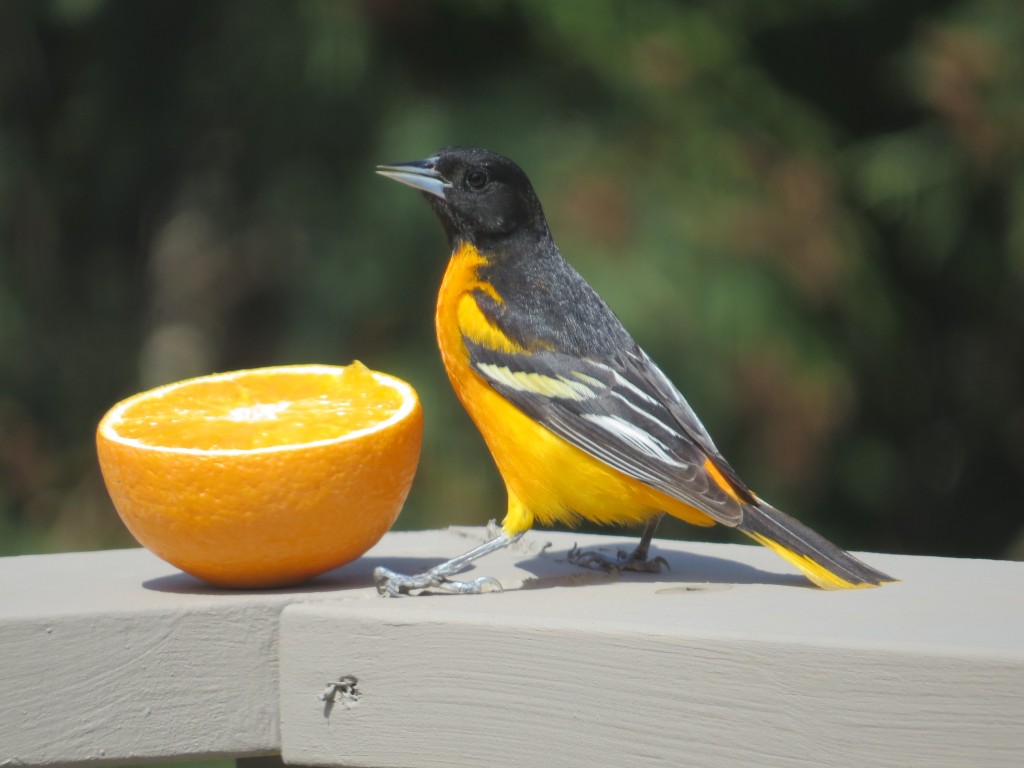 I might be out chasing birds, but Melissa makes sure the ones here on the ranch are taken care of. She bought lots of jars of cheap grape jelly and this cool, mess-free feeder. I know, I said you don’t need a fancy feeder. It’s true, you don’t. Welch’s will not like the following statement either: you don’t even need name-brand jelly.
I might be out chasing birds, but Melissa makes sure the ones here on the ranch are taken care of. She bought lots of jars of cheap grape jelly and this cool, mess-free feeder. I know, I said you don’t need a fancy feeder. It’s true, you don’t. Welch’s will not like the following statement either: you don’t even need name-brand jelly.
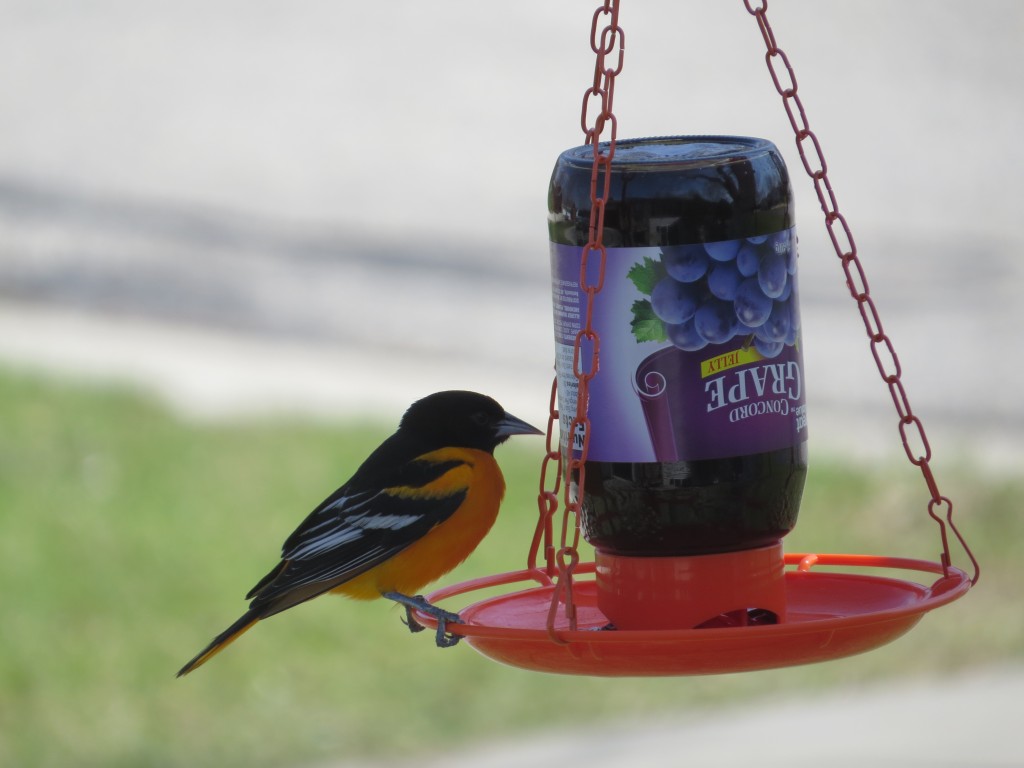 If you have kids I firmly think you should have a bird feeder of some sort. They are pretty exciting for everyone to watch. As Evan is in Cub Scouts and into birding, I’ve often thought that a great Eagle Scout project would be to erect and maintain bird feeders at a nursing home. If he’s still into both those activites in 10 years, I’ll suggest it.
If you have kids I firmly think you should have a bird feeder of some sort. They are pretty exciting for everyone to watch. As Evan is in Cub Scouts and into birding, I’ve often thought that a great Eagle Scout project would be to erect and maintain bird feeders at a nursing home. If he’s still into both those activites in 10 years, I’ll suggest it.
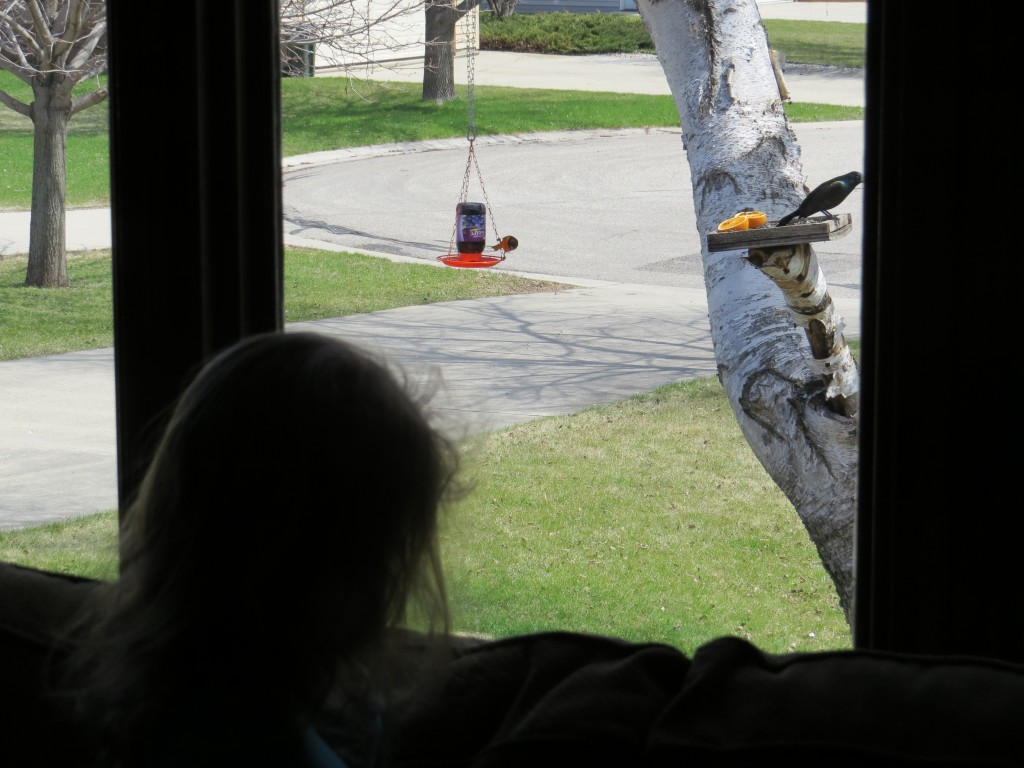
Watching feeder birds is fun for the whole family.
If you want a LOT more birds than just orioles, throw out some black-oiled sunflower seeds on a feeder or your lawn and watch the magic happen. Our yard list is getting closer and closer to the century mark for number of bird species. Right now, the sparrows are ruling the roost. The White-throated are the most abundant, and their song always reminds us of our home in northern Minnesota.
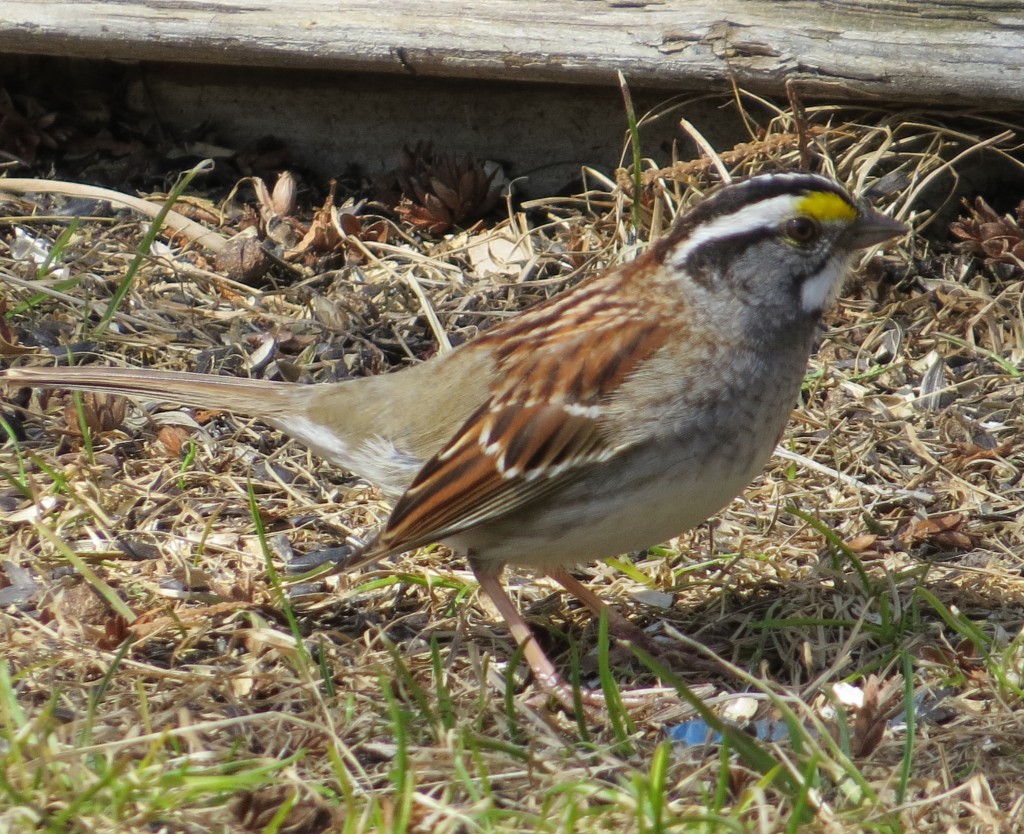
White-throated Sparrow
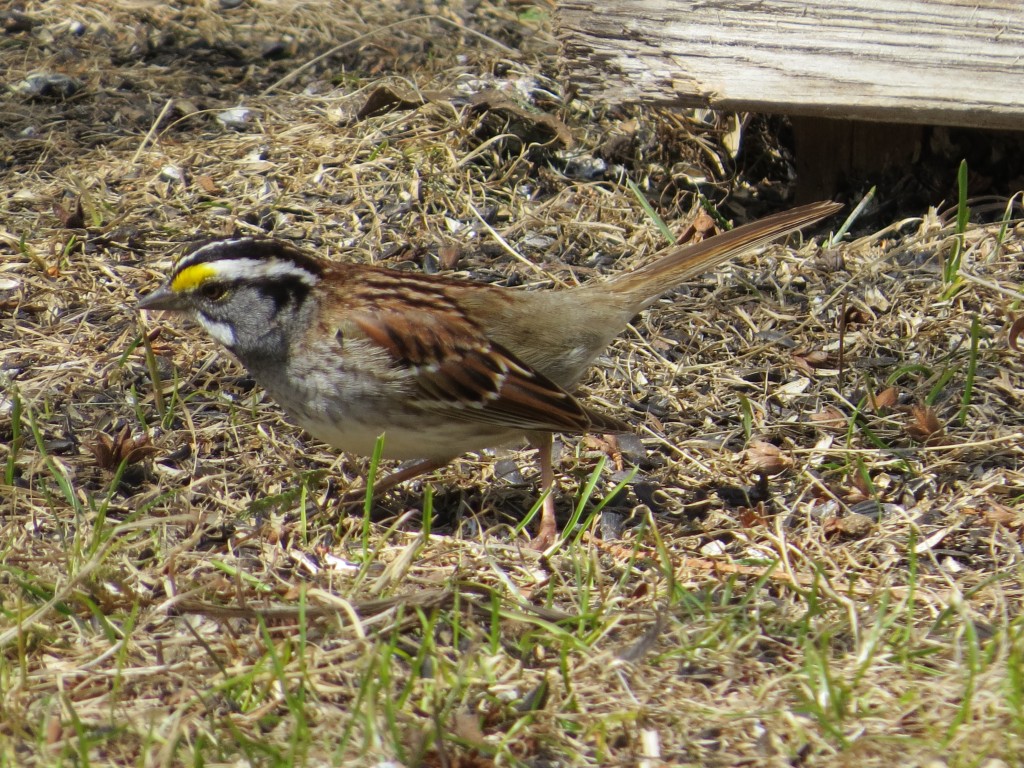
Today the sparrows were falling out of the sky. Our first-of-the-year Harris’s Sparrows showed up as well. Such an odd-looking bird.
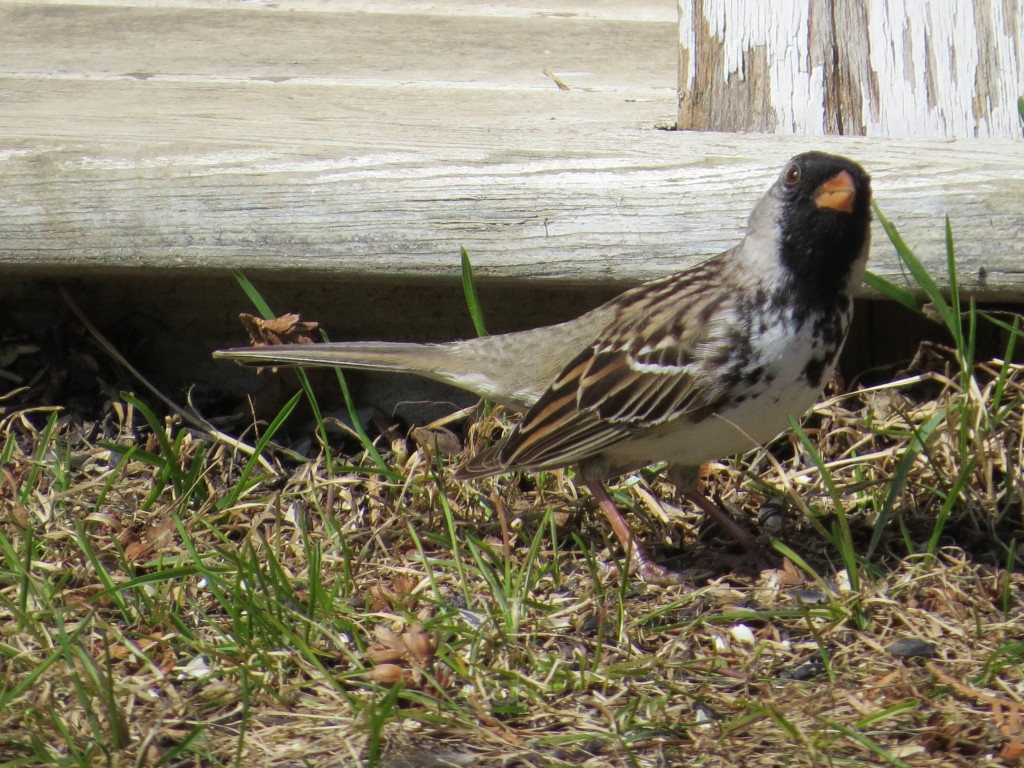
Harris’s Sparrow
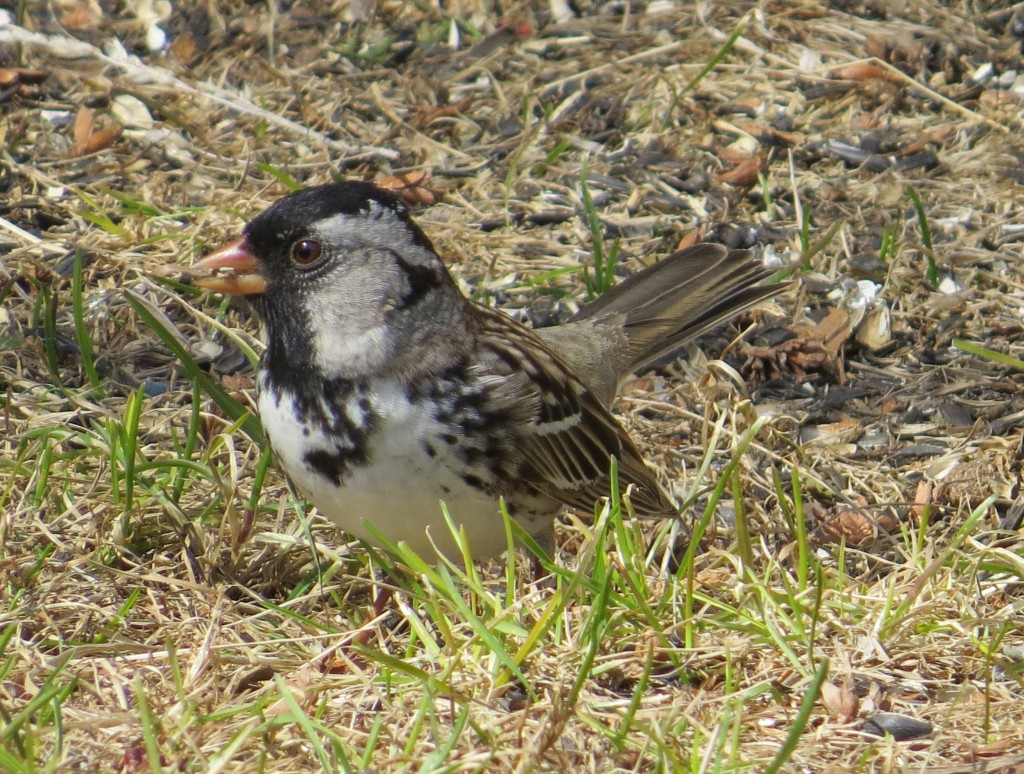
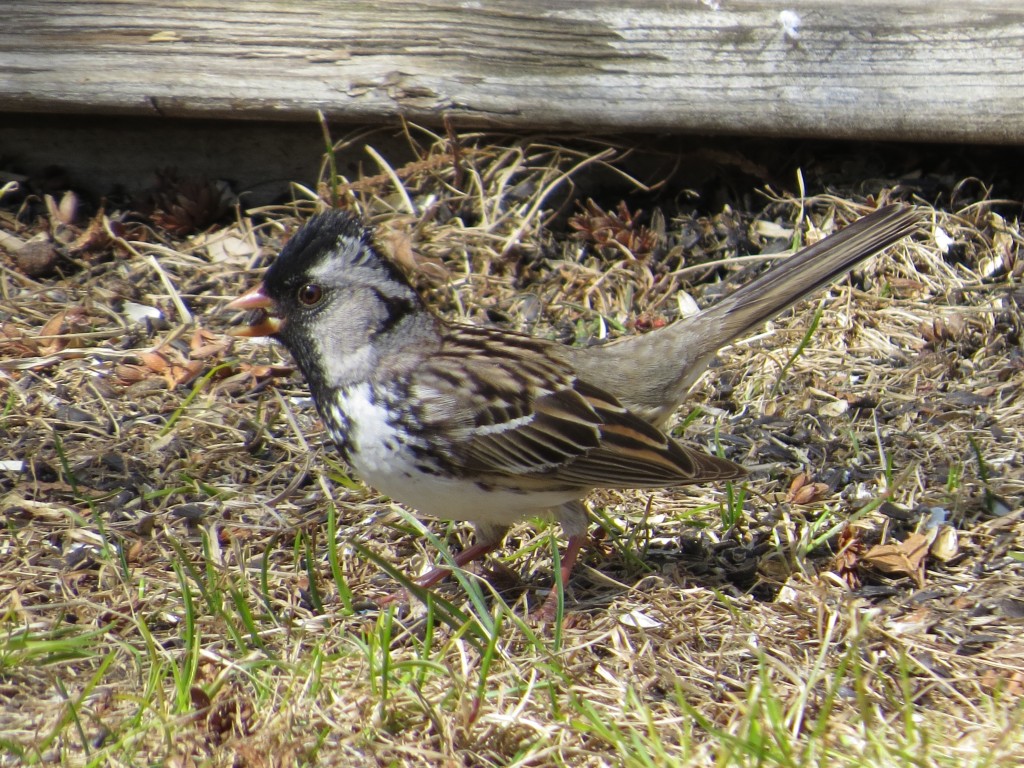 It was quite the sparrow-fest in the yard today.
It was quite the sparrow-fest in the yard today.
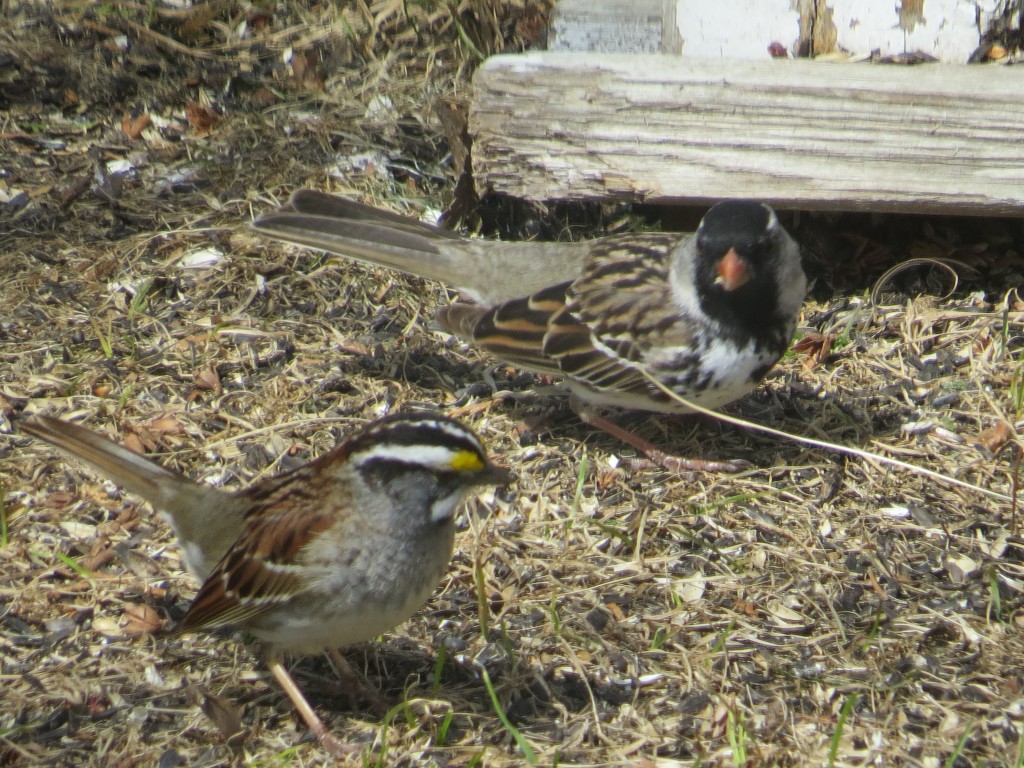 We even had a brief drop-in from a Clay-colored Sparrow.
We even had a brief drop-in from a Clay-colored Sparrow.
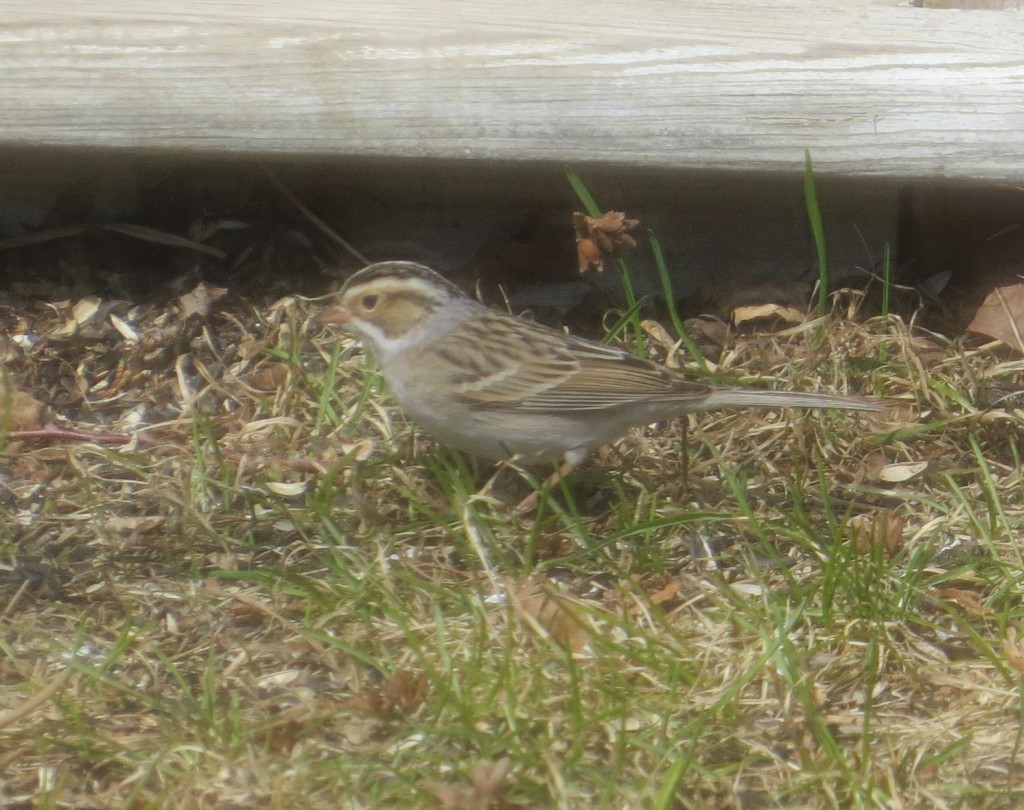
Clay-colored Sparrow
And, of course, Chipping Sparrows are all over right now trilling from treetops and just chilling out at the local watering hole.
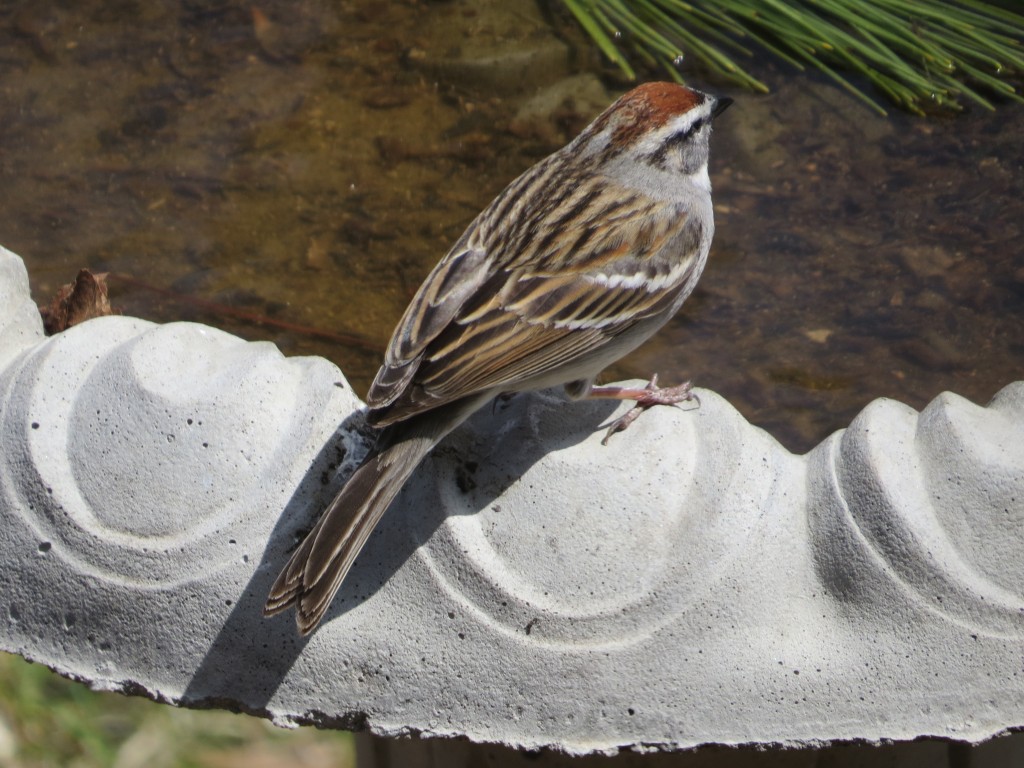
Chipping Sparrow
So what are you waiting for? Get the jelly, oranges, and seed out there to get the party started in your own yard.
No Lyin’ – Lyon County Has Unique Birds
The other night when my wife and I were on a date she took out her phone for a moment. I figured it was as good a time as any to do likewise. No, I wasn’t interested to see who texted me or check on sports scores. Instead I wanted to check for any intel from the field, bird-wise that is. Scanning the Minnesota Birding Facebook group posts, I saw one that got me fired up – 5 White-faced Ibises in Lyon County. Lyon County is where I just was the day before when we got the Ross’s Goose. I told Melissa that it looked like I’d be heading back to the southwest in the morning. I put the birding aside and continued on with the date – until I got home. Then I checked Birding Across America for any other info out of Lyon. I saw that my Cottonwood reporter was at it again – one Cattle Egret and 36 Smith’s Longspurs at the Cottonwood sewage ponds that evening. Yep, I was headin’ southwest in the morning.
I brought the kids along. I knew Evan wouldn’t want to miss a potential 3-lifer day (one of which was an ibis!). Plus we would be in the neighborhood of Lyon County’s Garvin Park – a campground with a playground so new and enormous that none can compare. With lunch, pillows, blankets, and movies, we were off on an adventure of undetermined length.
When we arrived at Sham Lake I looked for Cattle Egrets but came up empty. Almost as soon as I pulled in, though, a car pulled up behind me. I see a young man get out, binoculars in hand, and come up to my window. Could it be this young fellow whose eBird reports I salivate over? Sure enough, it was him. We visited for quite awhile about the unique birds in the area, and he told me the first-hand account of seeing those 16 Cattle Egrets on his way to school a couple days prior. By the looks of him I figured him to be a college student in his early twenties. As he talked about first waves of the warbler migration and nesting Western Kingbirds, I assumed he was in some sort of biology or naturalist program. That is, until he told me he stopped by to do a bit of birding before going to prom that afternoon. I didn’t even know what a warbler was until I was in my thirties. Sheesh. We didn’t get any Cattle Egrets there, but I got something almost as good – the contact information of this local birding kingpin. Those kingbirds shall be ours this summer.
After we parted company, the kids and I went to the poop ponds looking for the egret and longspurs. We struck out. Now we were 0 for 2 on the morning. On the way out of town we stopped by both Cottonwood Lake and the slough south of town. It was good to see that our Ross’s Goose was still hanging on.
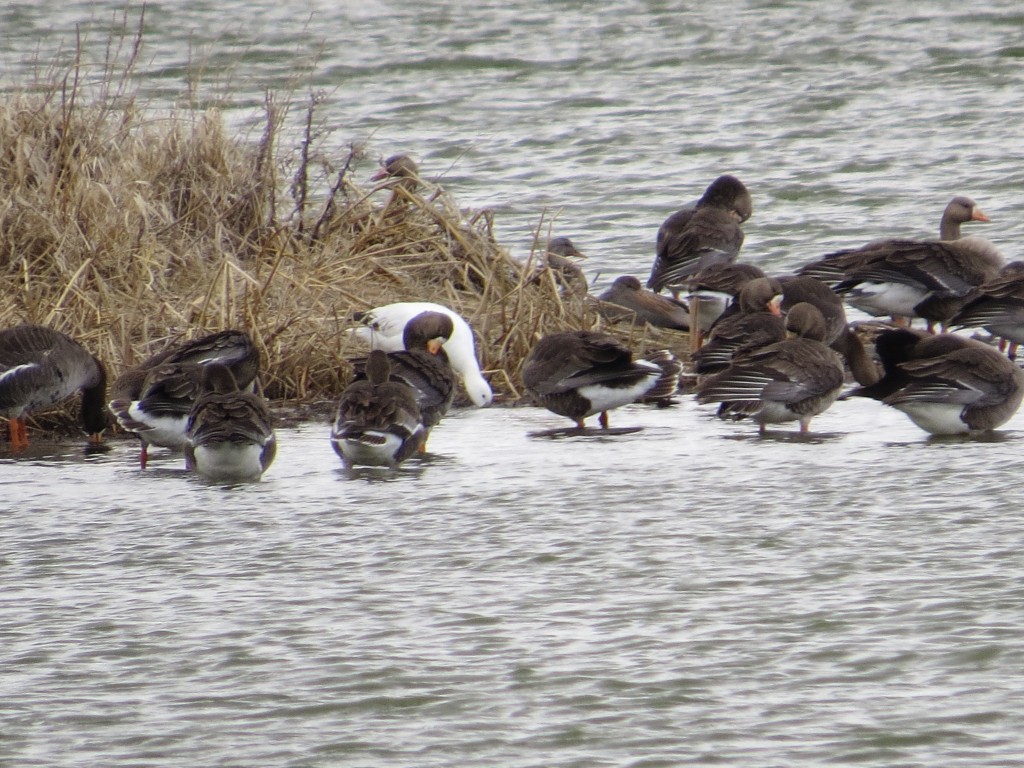
The kids were beyond anxious to get to Garvin Park. But we had to look for our main target first – the White-faced Ibises. Five of them had been reported at Black Rush WPA just east of Camden State Park on County Road 59. We drove the road back and forth a half dozen times or more. I was looking deep in the thick cattail marsh thinking that they were lurking somewhere out of easy viewing. Nothing. 0/3 now. It was time to go to the park – the big draw for the kids. In their world, it must have felt like an eternity until we got there around 12:30. Good thing we didn’t get there much sooner!
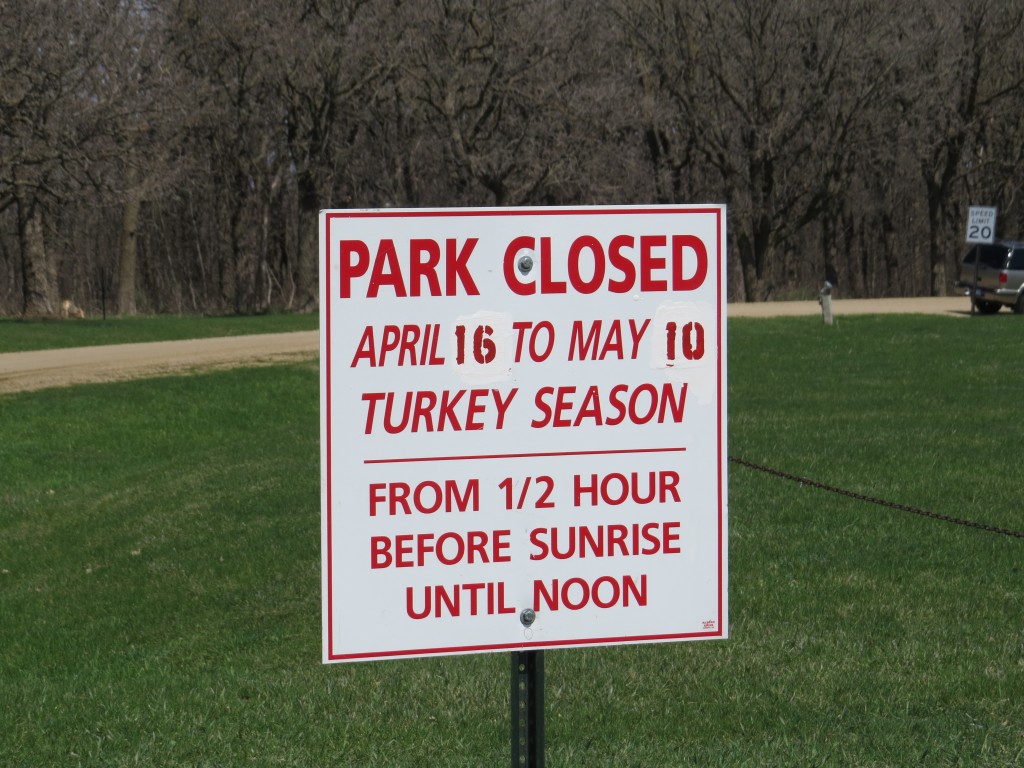 My goodness did those kids play hard and long in the chilly, windy weather. I was content to let them do so. Melissa was ill and bed-ridden all day back home, and I figured we’d have a better shot at those ibises on the return trip the closer it got to evening.
My goodness did those kids play hard and long in the chilly, windy weather. I was content to let them do so. Melissa was ill and bed-ridden all day back home, and I figured we’d have a better shot at those ibises on the return trip the closer it got to evening.

Birding at Garvin was limited. It was way too early for that Cerulean Warbler to be back, but it was nice to see and get some photos of a couple Yellow-bellied Sapsuckers.
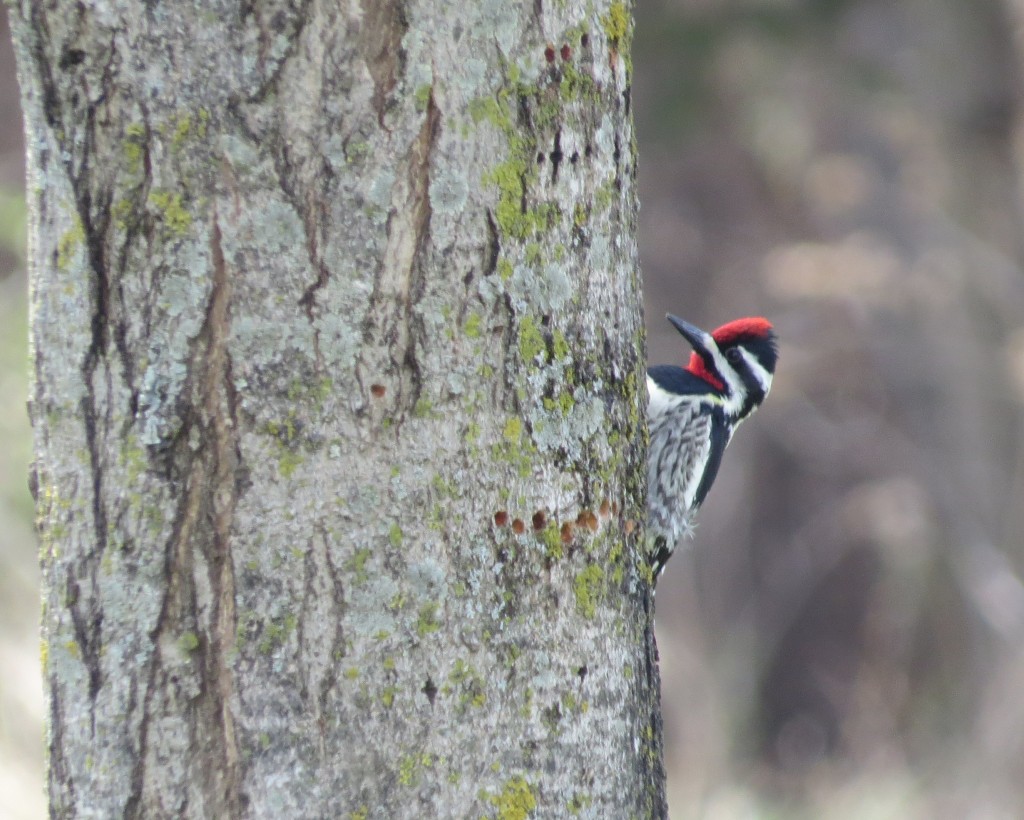
Yelloww-bellied Sapsuckeer
This bird will always be a notable one for me. Two years ago when Evan and I knew nothing about birds – well, he knew a lot more than me – we went on a birding walk with a naturalist at Bearhead Lake State Park. The first bird our guide pointed out to us was the Yellow-bellied Sapsucker. It was a rather odd-looking woodpecker with a funny name. It sounds like an insult you’d hurl at somebody.
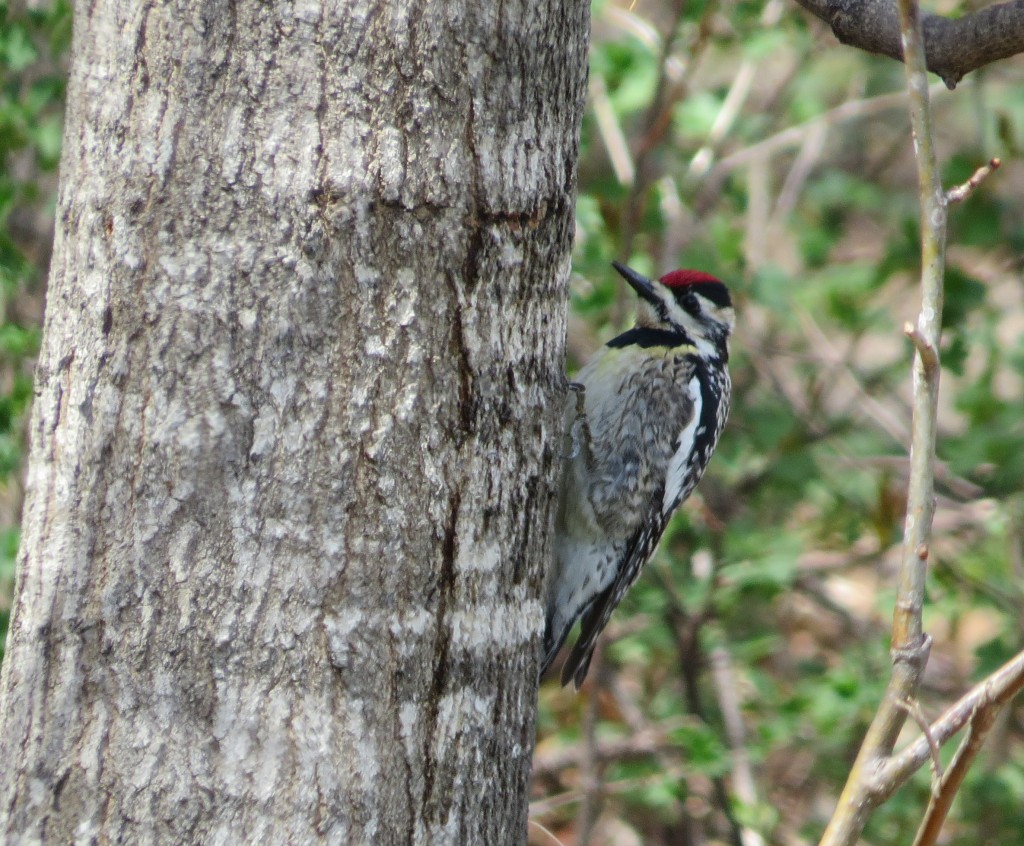 It was pretty neat to see him working so hard at his name-sake – sucking sap.
It was pretty neat to see him working so hard at his name-sake – sucking sap.
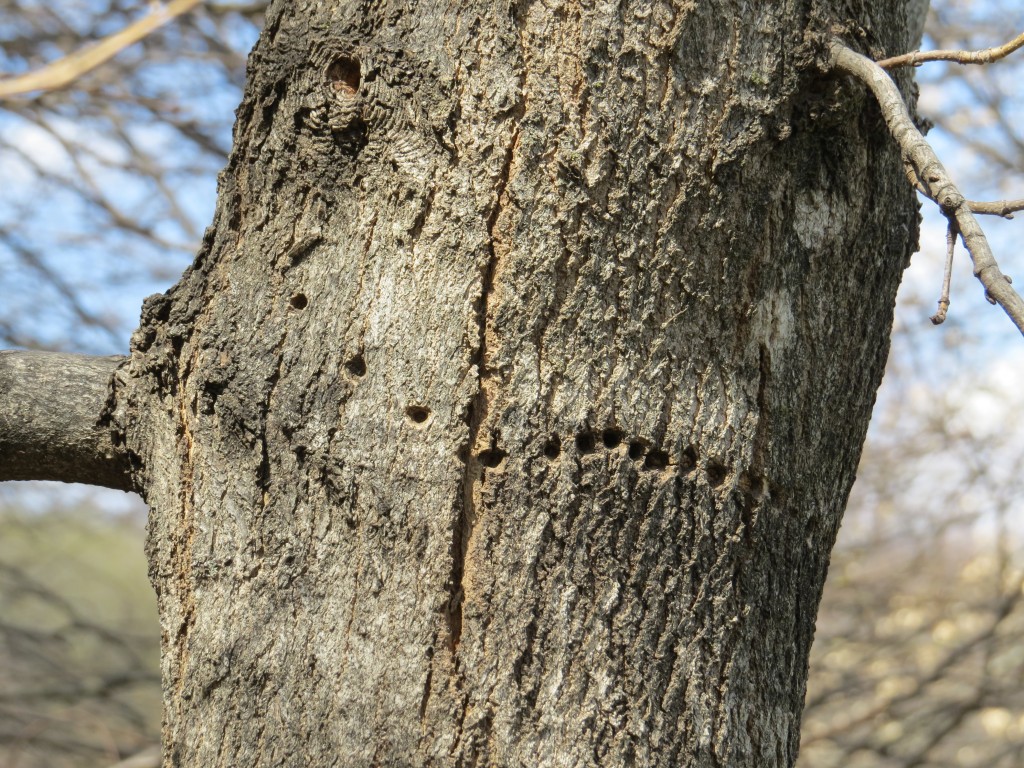 So, the blog post could very well have ended right here since we struck out on all three targets. Thankfully, though, it doesn’t.
So, the blog post could very well have ended right here since we struck out on all three targets. Thankfully, though, it doesn’t.
Just at the time we were getting ready to leave the park, I got an update that someone had seen the ibises just now! We were 15 minutes out. We hustled on over there and flushed the 5 White-faced Ibises as we drove County Road 59! A lifer and a very cool one at that.
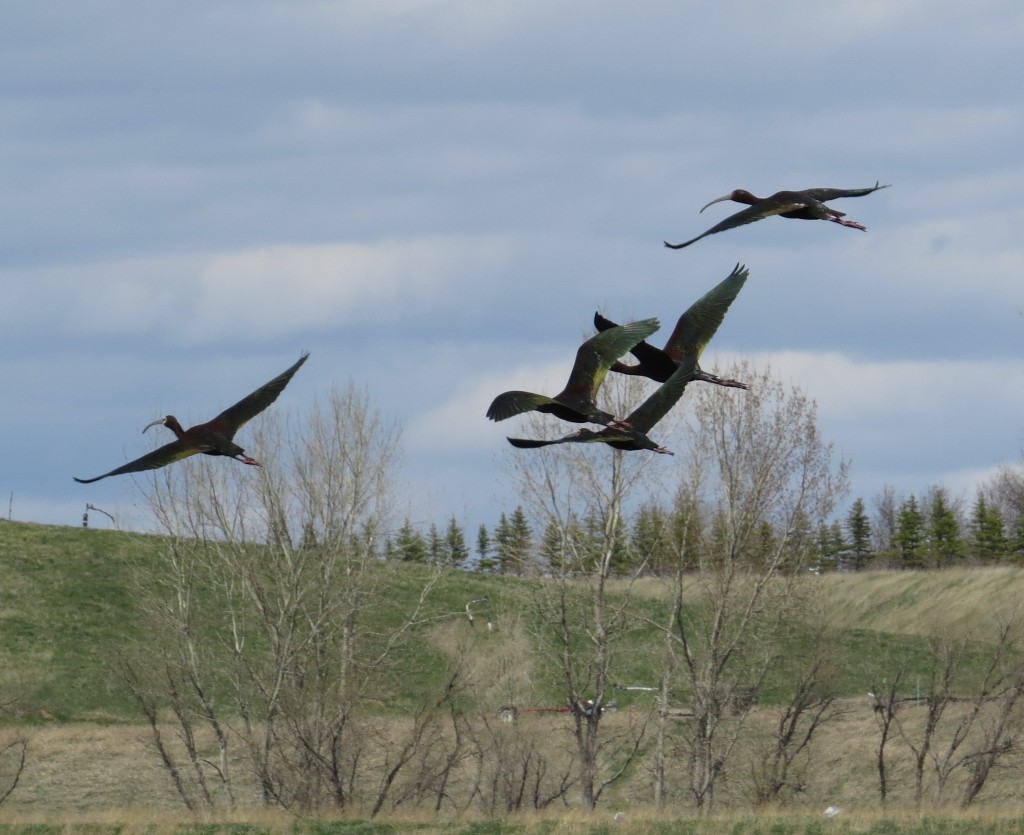
White-faced Ibises
They were actually smaller than I imagined. These birds were very skittish and would land 50 yards up the road, bobbing and weaving in the cattails and marsh grasses as they went along foraging for food.
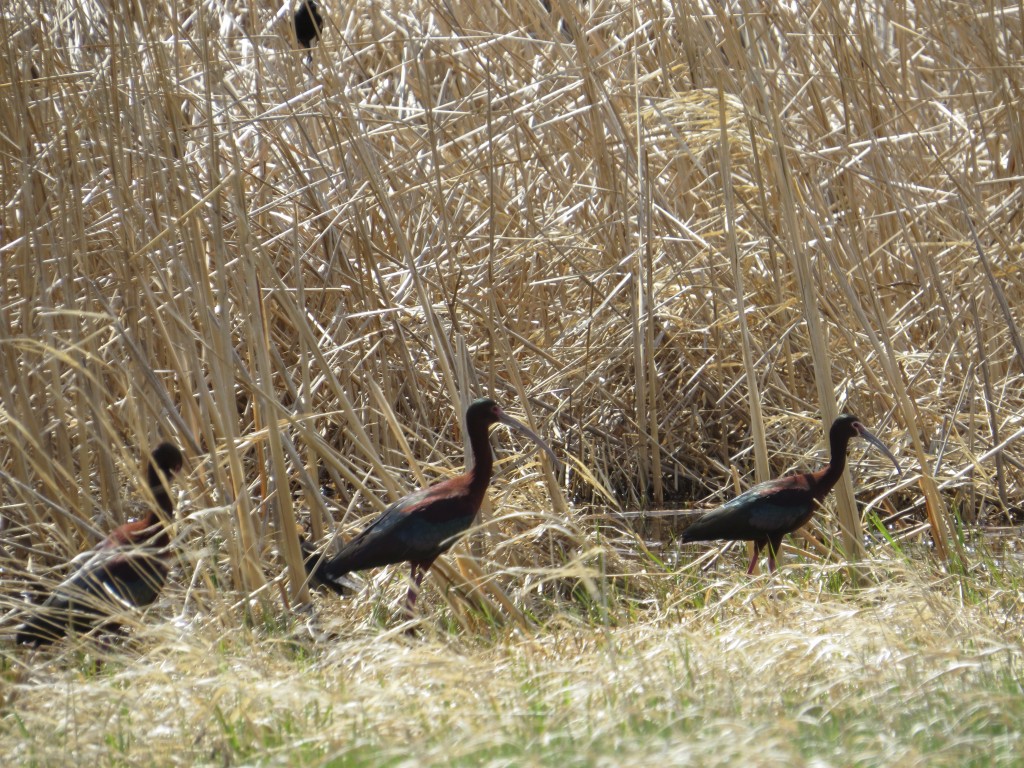
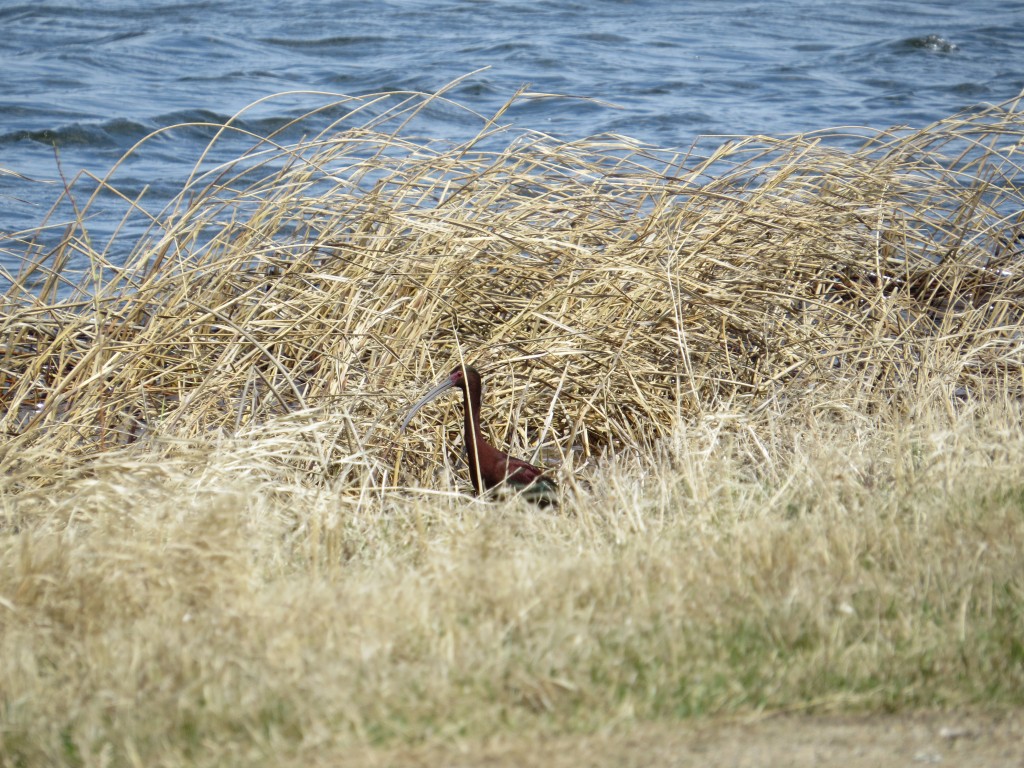 We spent a good deal of time driving up and creeping on these birds only to have them flush a short distance and always together as a group of five.
We spent a good deal of time driving up and creeping on these birds only to have them flush a short distance and always together as a group of five.
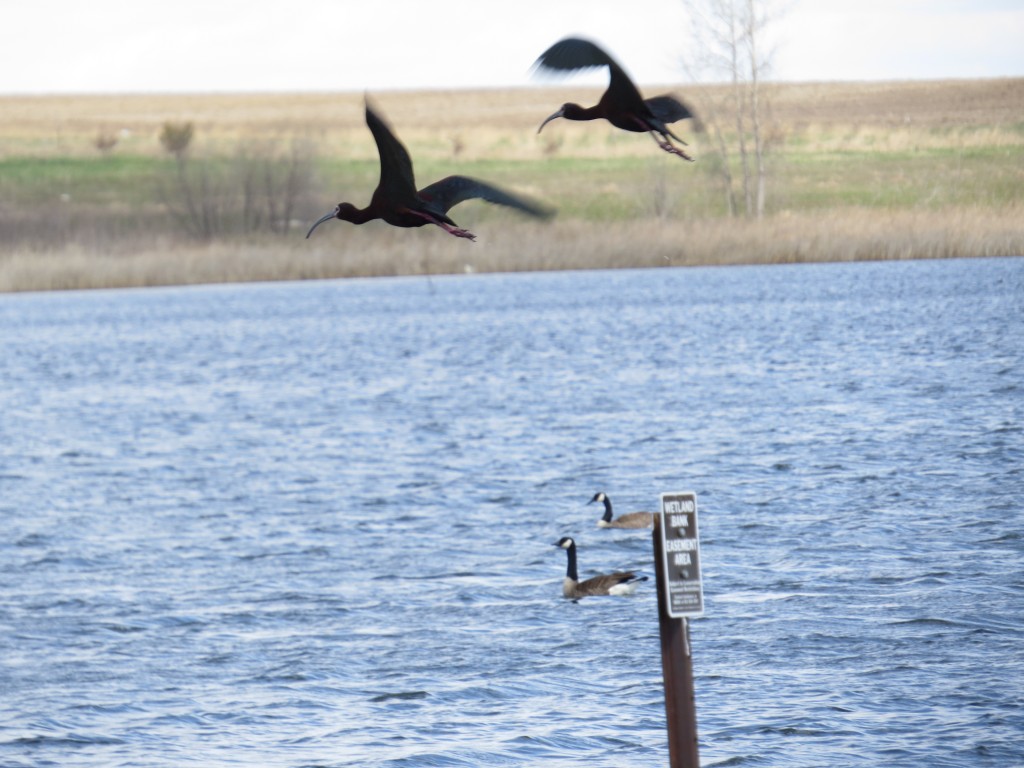
They were very loyal to the ditches along either side of the road.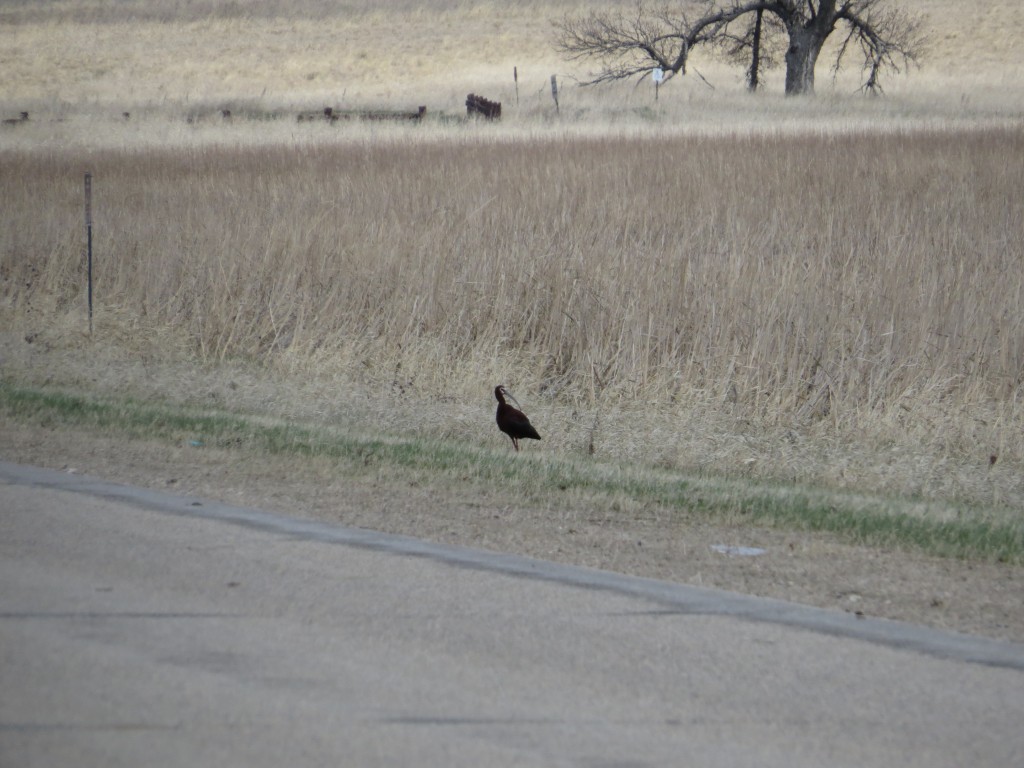 What a life bird this was. A small colony of them nest in South Dakota, so we do get them as scarce visitors every spring in Minnesota. I remember thinking last year what a strange bird this was and even more strange that it can be seen in our state.
What a life bird this was. A small colony of them nest in South Dakota, so we do get them as scarce visitors every spring in Minnesota. I remember thinking last year what a strange bird this was and even more strange that it can be seen in our state.
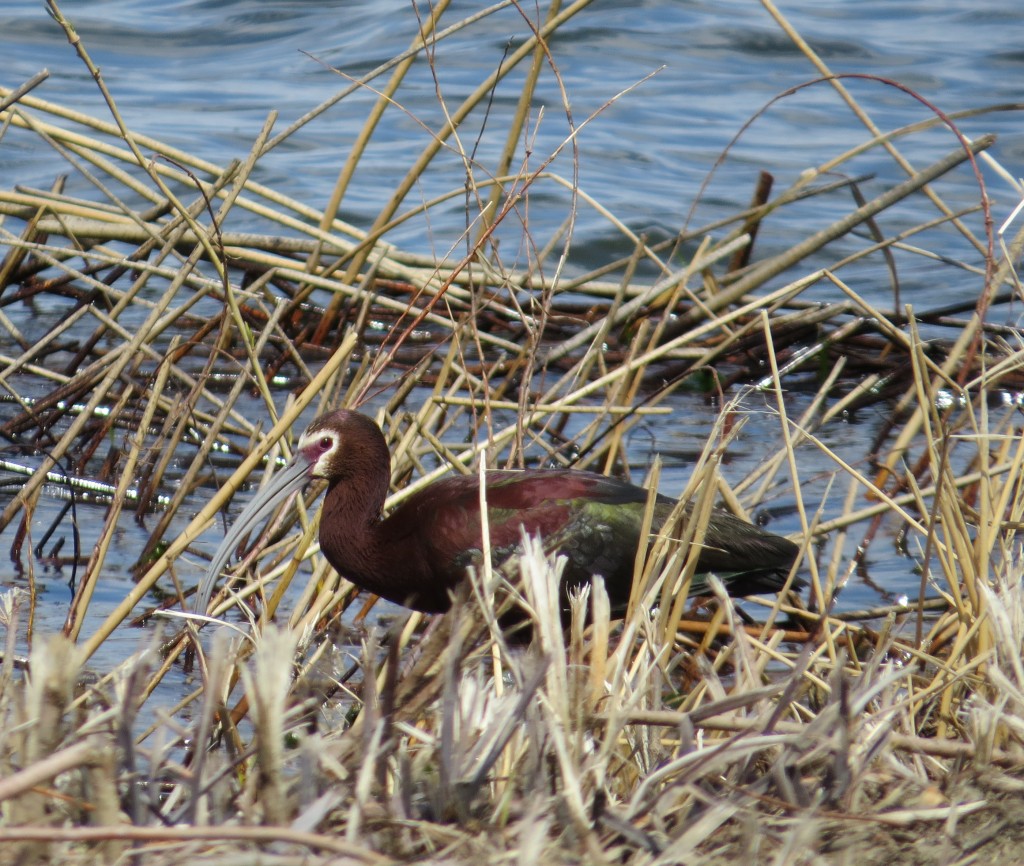
1 for 3. Not bad considering this is the bird that pulled us southwest again just two days after our last trip. We couldn’t go home and not check out the Cottonwood area again. Alas, there still was no Cattle Egret. I wouldn’t classify it as a nemesis bird yet, but rather just a really annoying bird that was getting under my skin.
There were a few interesting shorebirds at the poop ponds, though. I’m terrible at shorebird identification, but I knew they were peeps. I was frustrated because my camera battery had just died, and I couldn’t take photos to ID later. I did manage to have enough power to get just one image of this bird which we determined to be our Baird’s Sandpiper lifer. I don’t get too excited about most shorebird lifers because there’s always an element of doubt as to what it is. It’s not like a Blue-headed Vireo or Scarlet Tanager. Those ones are easy to tell and worthy of a fist pump.
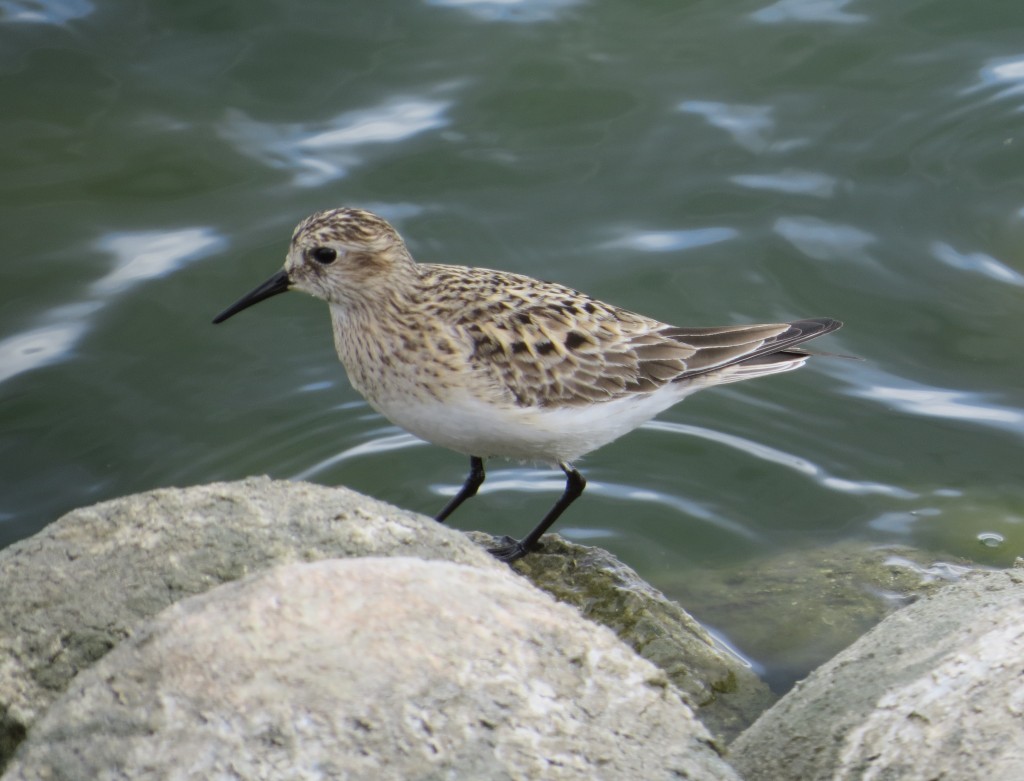
Baird’s Sandpiper
Well, this guy’s pretty cool, I guess – worthy of a suppressed ‘yay’.
It was a good trip. You can’t complain about a White-faced Ibis lifer coupled with a bonus shorebird lifer. You can complain about a dead battery, though. Lyon, we shall be back for more of your treasures with a fully charged camera next time.
